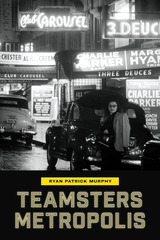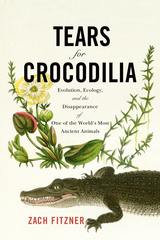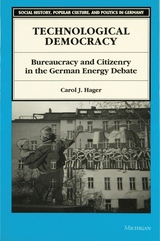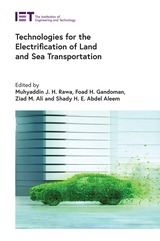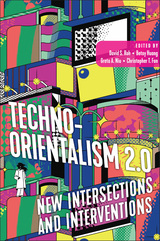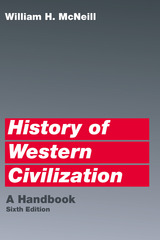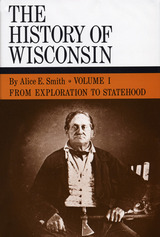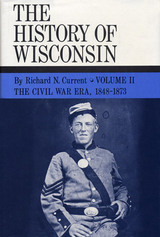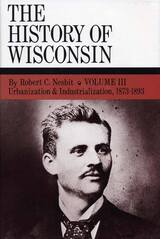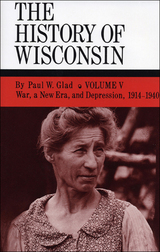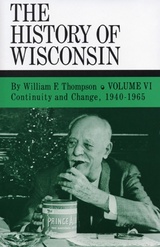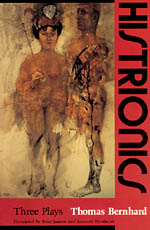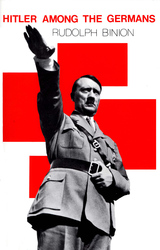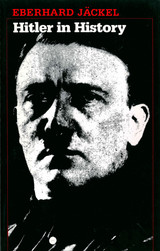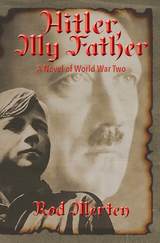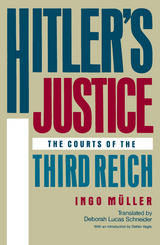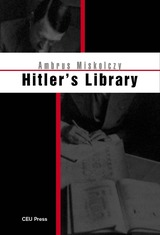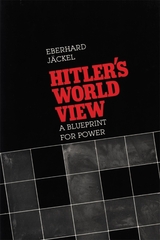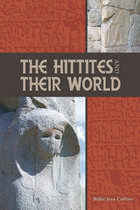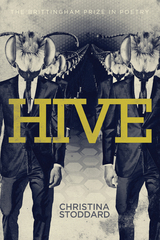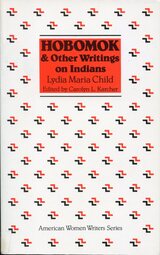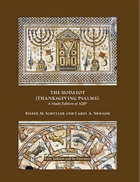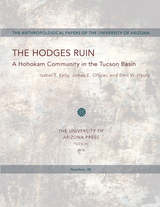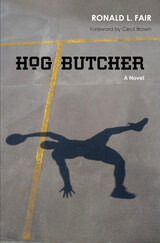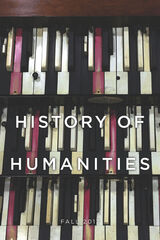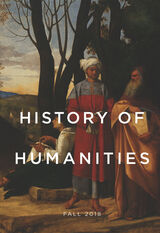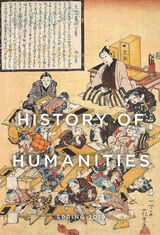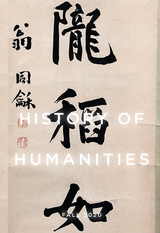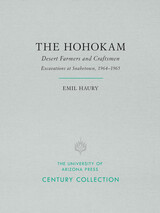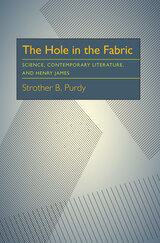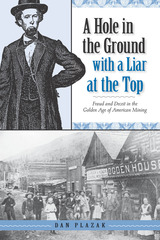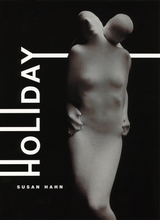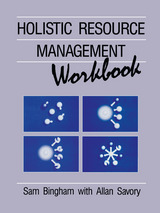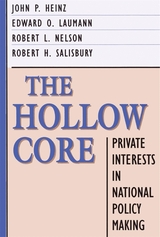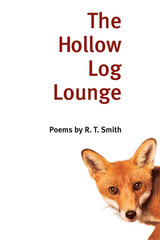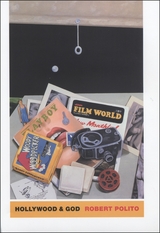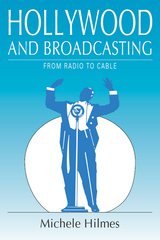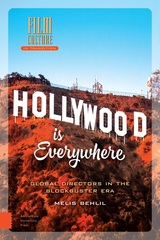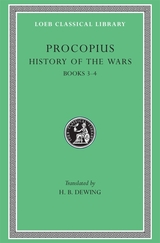 History of the Wars, Volume II: Books 3–4
Procopius
Harvard University Press Late antique military operations.
Procopius, born at Caesarea in Palestine late in the fifth century, became a lawyer. In AD 527 he was made legal adviser and secretary of Belisarius, commander against the Persians, and went with Belisarius again in 533 against the Vandals and in 535 against the Ostrogoths. Sometime after 540 he returned to Constantinople. He may have been that Procopius who was prefect of Constantinople in 562, but the date of his death (after 558) is unknown.
Procopius’ History of the Wars in 8 books recounts the Persian Wars of emperors Justinus and Justinian down to 550 (2 books); the Vandalic War and after-events in Africa 532–546 (2 books); the Gothic War against the Ostrogoths in Sicily and Italy 536–552 (3 books); and a sketch of events to 554 (1 book). The whole consists largely of military history, with much information about peoples and places as well, and about special events. He was a diligent, careful, judicious narrator of facts and developments and shows good powers of description. He is just to the empire’s enemies and boldly criticizes emperor Justinian. Other works by Procopius are the Anecdota or Secret History—vehement attacks on Justinian, Theodora, and others; and the Buildings of Justinian (down to AD 558) including roads and bridges as well as churches, forts, hospitals, and so on in various parts of the empire.
The Loeb Classical Library edition of Procopius is in seven volumes.
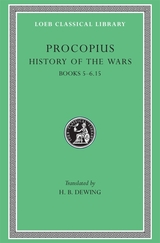 History of the Wars, Volume III: Books 5–6.15
Procopius
Harvard University Press Late antique military operations.
Procopius, born at Caesarea in Palestine late in the fifth century, became a lawyer. In AD 527 he was made legal adviser and secretary of Belisarius, commander against the Persians, and went with Belisarius again in 533 against the Vandals and in 535 against the Ostrogoths. Sometime after 540 he returned to Constantinople. He may have been that Procopius who was prefect of Constantinople in 562, but the date of his death (after 558) is unknown.
Procopius’ History of the Wars in 8 books recounts the Persian Wars of emperors Justinus and Justinian down to 550 (2 books); the Vandalic War and after-events in Africa 532–546 (2 books); the Gothic War against the Ostrogoths in Sicily and Italy 536–552 (3 books); and a sketch of events to 554 (1 book). The whole consists largely of military history, with much information about peoples and places as well, and about special events. He was a diligent, careful, judicious narrator of facts and developments and shows good powers of description. He is just to the empire’s enemies and boldly criticizes emperor Justinian. Other works by Procopius are the Anecdota or Secret History—vehement attacks on Justinian, Theodora, and others; and the Buildings of Justinian (down to AD 558) including roads and bridges as well as churches, forts, hospitals, and so on in various parts of the empire.
The Loeb Classical Library edition of Procopius is in seven volumes.
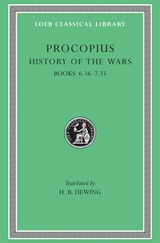 History of the Wars, Volume IV: Books 6.16–7.35
Procopius
Harvard University Press Late antique military operations.
Procopius, born at Caesarea in Palestine late in the fifth century, became a lawyer. In AD 527 he was made legal adviser and secretary of Belisarius, commander against the Persians, and went with Belisarius again in 533 against the Vandals and in 535 against the Ostrogoths. Sometime after 540 he returned to Constantinople. He may have been that Procopius who was prefect of Constantinople in 562, but the date of his death (after 558) is unknown.
Procopius’ History of the Wars in 8 books recounts the Persian Wars of emperors Justinus and Justinian down to 550 (2 books); the Vandalic War and after-events in Africa 532–546 (2 books); the Gothic War against the Ostrogoths in Sicily and Italy 536–552 (3 books); and a sketch of events to 554 (1 book). The whole consists largely of military history, with much information about peoples and places as well, and about special events. He was a diligent, careful, judicious narrator of facts and developments and shows good powers of description. He is just to the empire’s enemies and boldly criticizes emperor Justinian. Other works by Procopius are the Anecdota or Secret History—vehement attacks on Justinian, Theodora, and others; and the Buildings of Justinian (down to AD 558) including roads and bridges as well as churches, forts, hospitals, and so on in various parts of the empire.
The Loeb Classical Library edition of Procopius is in seven volumes.
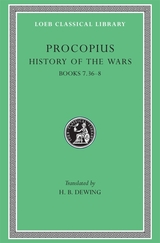 History of the Wars, Volume V: Books 7.36–8
Procopius
Harvard University Press Late antique military operations.
Procopius, born at Caesarea in Palestine late in the fifth century, became a lawyer. In AD 527 he was made legal adviser and secretary of Belisarius, commander against the Persians, and went with Belisarius again in 533 against the Vandals and in 535 against the Ostrogoths. Sometime after 540 he returned to Constantinople. He may have been that Procopius who was prefect of Constantinople in 562, but the date of his death (after 558) is unknown.
Procopius’ History of the Wars in 8 books recounts the Persian Wars of emperors Justinus and Justinian down to 550 (2 books); the Vandalic War and after-events in Africa 532–546 (2 books); the Gothic War against the Ostrogoths in Sicily and Italy 536–552 (3 books); and a sketch of events to 554 (1 book). The whole consists largely of military history, with much information about peoples and places as well, and about special events. He was a diligent, careful, judicious narrator of facts and developments and shows good powers of description. He is just to the empire’s enemies and boldly criticizes emperor Justinian. Other works by Procopius are the Anecdota or Secret History—vehement attacks on Justinian, Theodora, and others; and the Buildings of Justinian (down to AD 558) including roads and bridges as well as churches, forts, hospitals, and so on in various parts of the empire.
The Loeb Classical Library edition of Procopius is in seven volumes.
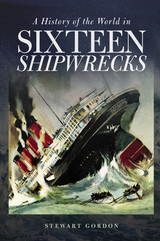 A History of the World in Sixteen Shipwrecks
Stewart Gordon
University Press of New England, 2017 Stories of disasters at sea, whether about Roman triremes, the treasure fleet of the Spanish Main, or great transatlantic ocean liners, fire the imagination as little else can. From the historical sinkings of the Titanic and the Lusitania to the recent capsizing of a Mediterranean cruise ship, the study of shipwrecks also makes for a new and very different understanding of world history. A History of the World in Sixteen Shipwrecks explores the age-old, immensely hazardous, persistently romantic, and ongoing process of moving people and goods across the seven seas. In recounting the stories of ships and the people who made and sailed them, from the earliest craft plying the ancient Nile to the Exxon Valdez, Stewart Gordon argues that the gradual integration of mainly local and separate maritime domains into fewer, larger, and more interdependent regions offers a unique perspective on world history. Gordon draws a number of provocative conclusions from his study, among them that the European “Age of Exploration” as a singular event is simply a myth: over the millennia, many cultures, east and west, have explored far-flung maritime worlds, and technologies of shipbuilding and navigation have been among the main drivers of science and exploration throughout history. In a series of compelling narratives, A History of the World in Sixteen Shipwrecks shows that the development of institutions and technologies that made the terrifying oceans familiar and turned unknown seas into well-traveled sea-lanes matters profoundly in our modern world.
A History of the World in the Twentieth Century
J. A. S. Grenville
Harvard University Press THIS EDITION HAS BEEN REPLACED BY A NEWER TWO-VOLUME PAPERBACK EDITION.
This now classic history of the world in our century has been updated and expanded to take the history almost to the end of our century. It is being published in paperback in two compact volumes, divided at the time of the Cold War. Volume I covers the years 1900 to 1947 while volume II extends from 1945 to 1996. Grenville has also updated the references and index, and has provided new prefatory material. All illustrations and maps have been retained.
A History of the World in the Twentieth Century: Enlarged Edition
J. A. S. Grenville
Harvard University Press, 2000 In this enlargement of his outstanding history of the world, Grenville stresses the history of nation-states within a world of interdependence and regional groupings. The twentieth century remains an epoch of revolutionary change. Clashes of culture, the impact of technology, the consequences of industrialization all play out within national borders that are also porous.
In this latest enlarged edition, Grenville has updated the history through 1999 and added new material on the demise of Yugoslavia, with its wars and ethnic cleansing; Clinton's policies in Haiti, Somalia, and Asia; his economic policy; Eastern Europe's new democracies; and the progress of Third World countries. Democracy and the market economy are portrayed as the linchpins of a new century.
A History of the World Semiconductor Industry
P.R. Morris
The Institution of Engineering and Technology, 1990 The book describes the development of semiconductor manufacture on a worldwide basis, from its early beginnings to date. Its approach is wide-ranging, encompassing early experimental work rooted in nineteenth century science, and it includes a brief historical review of the thermionic valve, which played an important part in the genesis of the semiconductor industry. The contents include a description of the establishment and subsequent development of semiconductor manufacture within the various nation states. Although not a technical treatise, major device types and manufacturing processes used in semiconductor fabrication are outlined. Factors affecting the performance of the industry within the major national participants are discussed, and the relationship of the industry to science and technology is also considered.
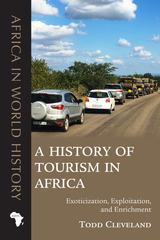 A History of Tourism in Africa: Exoticization, Exploitation, and Enrichment
Todd Cleveland
Ohio University Press, 2021 An engaging social history of foreign tourists’ dreams, the African tourism industry’s efforts to fulfill them, and how both sides affect each other. Since the nineteenth century, foreign tourists and resident tourism workers in Africa have mutually relied upon notions of exoticism, but from vastly different perspectives. Many of the countless tourists who have traveled to the African continent fail to acknowledge or even realize that skilled African artists in the tourist industry repeatedly manufacture “authentic” experiences in order to fulfill foreigners’ often delusional, or at least uninformed, expectations. These carefully nurtured and controlled performances typically reinforce tourists’ reductive impressions—formed over centuries—of the continent, its peoples, and even its wildlife. In turn, once back in their respective homelands, tourists’ accounts of their travels often substantiate, and thereby reinforce, prevailing stereotypes of “exotic” Africa. Meanwhile, Africans’ staged performances not only impact their own lives, primarily by generating remunerative opportunities, but also subject the continent’s residents to objectification, exoticization, and myriad forms of exploitation.
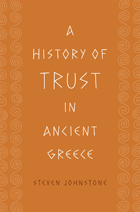 A History of Trust in Ancient Greece
Steven Johnstone
University of Chicago Press, 2011 An enormous amount of literature exists on Greek law, economics, and political philosophy. Yet no one has written a history of trust, one of the most fundamental aspects of social and economic interaction in the ancient world. In this fresh look at antiquity, Steven Johnstone explores the way democracy and markets flourished in ancient Greece not so much through personal relationships as through trust in abstract systems—including money, standardized measurement, rhetoric, and haggling. Focusing on markets and democratic politics, Johnstone draws on speeches given in Athenian courts, histories of Athenian democracy, comic writings, and laws inscribed on stone to examine how these systems worked. He analyzes their potentials and limitations and how the Greeks understood and critiqued them. In providing the first comprehensive account of these pervasive and crucial systems, A History of Trust in Ancient Greece links Greek political, economic, social, and intellectual history in new ways and challenges contemporary analyses of trust and civil society.
 A History of Twentieth-Century Russia
Robert Service
Harvard University Press, 1998 Russia has had an extraordinary history in the twentieth century. As the first Communist society, the USSR was both an admired model and an object of fear and hatred to the rest of the world.
How are we to make sense of this history? A History of Twentieth-Century Russia treats the years from 1917 to 1991 as a single period and analyzes the peculiar mixture of political, economic, and social ingredients that made up the Soviet formula. Under a succession of leaders from Lenin to Gorbachev, various methods were used to conserve and strengthen this compound. At times the emphasis was upon shaking up the ingredients, at others upon stabilization. All this occurred against a background of dictatorship, civil war, forcible industrialization, terror, world war, and the postwar arms race. Communist ideas and practices never fully pervaded the society of the USSR. Yet an impact was made and, as this book expertly documents, Russia since 1991 has encountered difficulties in completely eradicating the legacy of Communism.
A History of Twentieth-Century Russia is the first work to use the mass of material that has become available in the documentary collections, memoirs, and archives over the past decade. It is an extraordinarily lucid, masterful account of the most complex and turbulent period in Russia's long history.
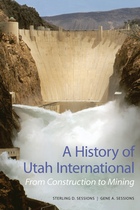 A History of Utah International: From Construction to Mining
Sterling D Sessions
University of Utah Press, 2005 The story of how the Utah Construction Company, founded in Ogden, Utah in 1900, became Utah International, a multinational corporation, is known to historians of the American West but perhaps not by the general public. The publication of this book remedies that omission.
During its first decades, the company built railroads and dams and was one of the Six Companies Consortium that built Hoover Dam. Utah Construction was also engaged in numerous war-contract activities during World War II. In the postwar period, the company expanded its activities into mining and land development and moved its headquarters to San Francisco. Changing its name to Utah Construction and Mining, and eventually to Utah International, the corporation became one of the most successful multinational mining companies in the world. In 1976, Utah International and General Electric negotiated the largest yet corporate merger in the United States.
Based on the Utah International archives housed in the Stewart Library at Weber State University, the story of Utah International describes more than projects: it is also the story of how two remarkable entrepreneurs, Marriner Stoddard Eccles and Edmund Wattis Littlefield, transformed the company incorporated in 1900 by the Wattis brothers into the largest and most profitable mining company in the United States.
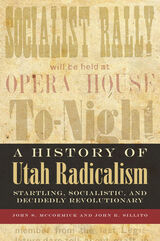 A History of Utah Radicalism: Startling, Socialistic, and Decidedly Revolutionary
John S. McCormick and John R. Sillito
Utah State University Press, 2023 Utah, now one of the most conservative states, has a long tradition of left-wing radicalism. Early Mormon settlers set a precedent with the United Order and other experiments with a socialistic economy. The tradition continued into the more recent past with New Left, anti-apartheid, and other radicals. Throughout, Utah radicalism usually reflected national and international developments. Recounting its long history, McCormick and Sillito focus especially on the Socialist Party of America, which reached a peak of political influence in the first two decades of the twentieth century—in Utah and across the nation.
At least 115 Socialists in over two dozen Utah towns and cities were elected to office in that period, and on seven occasions they controlled governments of five different municipalities. This is a little-known story worth a closer look. Histories of Socialism in the United States have tended to forsake attention to specific, local cases and situations in favor of broader overviews of the movement. By looking closely at Utah's experience, this book helps unravel how American Socialism briefly flowered before rapidly withering in the early twentieth century. It also broadens the conventional understanding of Utah history.
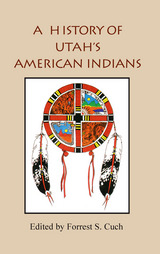 History Of Utah's American Indians
Forrest S. Cuch
Utah State University Press, 2003 This book is a joint project of the Utah Division of Indian Affairs and the Utah State Historical Society. It is distributed to the book trade by Utah State University Press. The valleys, mountains, and deserts of Utah have been home to native peoples for thousands of years. Like peoples around the word, Utah's native inhabitants organized themselves in family units, groups, bands, clans, and tribes. Today, six Indian tribes in Utah are recognized as official entities. They include the Northwestern Shoshone, the Goshutes, the Paiutes, the Utes, the White Mesa or Southern Utes, and the Navajos (Dineh). Each tribe has its own government. Tribe members are citizens of Utah and the United States; however, lines of distinction both within the tribes and with the greater society at large have not always been clear. Migration, interaction, war, trade, intermarriage, common threats, and challenges have made relationships and affiliations more fluid than might be expected. In this volume, the editor and authors endeavor to write the history of Utah's first residents from an Indian perspective. An introductory chapter provides an overview of Utah's American Indians and a concluding chapter summarizes the issues and concerns of contemporary Indians and their leaders. Chapters on each of the six tribes look at origin stories, religion, politics, education, folkways, family life, social activities, economic issues, and important events. They provide an introduction to the rich heritage of Utah's native peoples. This book includes chapters by David Begay, Dennis Defa, Clifford Duncan, Ronald Holt, Nancy Maryboy, Robert McPherson, Mae Parry, Gary Tom, and Mary Jane Yazzie. Forrest Cuch was born and raised on the Uintah and Ouray Ute Indian Reservation in northeastern Utah. He graduated from Westminster College in 1973 with a bachelor of arts degree in behavioral sciences. He served as education director for the Ute Indian Tribe from 1973 to 1988. From 1988 to 1994 he was employed by the Wampanoag Tribe in Gay Head, Massachusetts, first as a planner and then as tribal administrator. Since October 1997 he has been director of the Utah Division of Indian Affairs.
History of Vardan and the Armenian War
Eļishē
Harvard University Press, 1982 Here is a fully annotated translation of an Armenian literary classic, the first made from the critical Armenian text.
The sixth-century History of Vardan and the Armenian War describes a revolt of Armenians against the shah of Sasanian Iran in 450-451 in protest against the persecution of Christianity. Elishē uses this occasion to express in more general terms his attitude as a Christian Armenian to the problems of cultural survival and patriotism in a hostile environment. His history profoundly influenced Armenian writers from classical times to the present; its hero, Vardan, remains the ideal figure of a patriot even in Soviet Armenia. Mr. Thomson's introduction places the work in its historical context, while extensive notes identify people and places, explain allusions, and clarify details of the account.
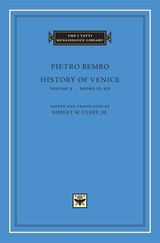 History of Venice
Pietro BemboEdited and translated by Robert W. Ulery, Jr.
Harvard University Press, 2007 Pietro Bembo (1470–1547), a Venetian nobleman, later a cardinal of the Roman Catholic Church, was the most celebrated Latin stylist of his day and was widely admired for his writings in Italian as well. His early dialogue on the subject of love greatly influenced the development of the literary vernacular, as did his Prose della volgar lingua (1525). From 1513 to 1521, he served Pope Leo X as Latin secretary and became known as the leading advocate of Ciceronian Latin in Europe and of the Tuscan dialect within Italy. He was named official historian of Venice in 1529 and began to compose in Latin his continuation of the city’s history in twelve books, covering the years from 1487 to 1513. Although the work chronicles internal politics and events, much of it is devoted to the external affairs of Venice, principally conflicts with other European states (France, Spain, the Holy Roman Empire, Milan, and the papacy) and with the Turks in the East. The History of Venice was published after Bembo’s death, in Latin and in his own Italian version. This edition, completed by this third volume, makes it available for the first time in English translation.
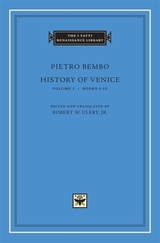 History of Venice
Pietro BemboEdited and translated by Robert W. Ulery, Jr.
Harvard University Press, 2007 Pietro Bembo (1470–1547), a Venetian nobleman, later a cardinal of the Roman Catholic Church, was the most celebrated Latin stylist of his day and was widely admired for his writings in Italian as well. His early dialogue on the subject of love greatly influenced the development of the literary vernacular, as did his Prose della volgar lingua (1525). From 1513 to 1521 he served Pope Leo X as Latin secretary and became known as the leading advocate of Ciceronian Latin in Europe and of the Tuscan dialect within Italy. He was named official historian of Venice in 1529 and began to compose in Latin his continuation of the city's history in twelve books, covering the years from 1487 to 1513. Although the work chronicles internal politics and events, much of it is devoted to the external affairs of Venice, principally conflicts with other European states (France, Spain, the Holy Roman Empire, Milan, and the papacy) and with the Turks in the East. The History of Venice was published after Bembo's death, in Latin and in his own Italian version. This edition, in a projected three volumes, makes it available for the first time in English translation.
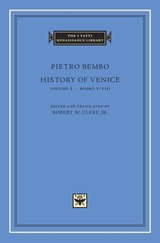 History of Venice
Pietro BemboEdited and translated by Robert W. Ulery, Jr.
Harvard University Press, 2007 Pietro Bembo (1470–1547), a Venetian nobleman, later a cardinal of the Roman Catholic Church, was the most celebrated Latin stylist of his day and was widely admired for his writings in Italian as well. His early dialogue on the subject of love greatly influenced the development of the literary vernacular, as did his Prose della volgar lingua (1525). From 1513 to 1521 he served Pope Leo X as Latin secretary and became known as the leading advocate of Ciceronian Latin in Europe and of the Tuscan dialect within Italy. He was named official historian of Venice in 1529 and began to compose in Latin his continuation of the city’s history in twelve books, covering the years from 1487 to 1513. Although the work chronicles internal politics and events, much of it is devoted to the external affairs of Venice, principally conflicts with other European states (France, Spain, the Holy Roman Empire, Milan, and the papacy) and with the Turks in the East. The History of Venice was published after Bembo’s death, in Latin and in his own Italian version. This edition, in a projected three volumes, makes it available for the first time in English translation.
History of Western Civilization: A Handbook
William H. McNeill
University of Chicago Press, 1986 A compact yet thorough one-volume narrative of the entire history of the development of Western civilization
With this book, renowned historian William H. McNeil provides a brilliant narrative chronology of the development of Western civilization, representing its sociopolitical as well as cultural aspects. Sweeping in its coverage but careful in its attention to detail, and up to date with the latest scholarship History of Western Civlization is the perfect introduction to the subject for general readers and students alike.
The History of Wisconsin, Volume I: From Exploration to Statehood
Alice E. Smith
Wisconsin Historical Society Press, 1973 Published in 1973, this first volume in the History of Wisconsin series remains the definitive work on Wisconsin's beginnings, from the arrival of the French explorer Jean Nicolet in 1634, to the attainment of statehood in 1848. This volume explores how Wisconsin's Native American inhabitants, early trappers, traders, explorers, and many immigrant groups paved the way for the territory to become a more permanent society. Including nearly two dozen maps as well as illustrations of territorial Wisconsin and portraits of early residents, this volume provides an in-depth history of the beginnings of the state.
The History of Wisconsin, Volume II: Civil War Era, 1848-1873
Richard N. Current
Wisconsin Historical Society Press, 1976 This second volume in the History of Wisconsin series introduces us to the first generation of statehood, from the conversion of prairie and forests into farmland to the development of cities and industry. In addition, this volume presents a synthesis of the Civil War and Reconstruction era in Wisconsin. Scarcely a decade after entering the Union, the state was plunged into the nationwide debate over slavery, the secession crisis, and a war in which 11,000 "Badger Boys in Blue" gave their lives. Wisconsin's role in the Civil War is chronicled, along with the post-war years. Complete with photographs from the Historical Society's collections, as well as many pertinent maps, this book is a must-have for anyone interested in this era of Wisconsin's history.
The History of Wisconsin, Volume III: Urbanization & Industrialization 1873-1893
Robert C. Nesbit
Wisconsin Historical Society Press, 1985 Although the years from 1873-1893 lacked the well known, dramatic events of the periods before and after, this period presented a major transformation in Wisconsin's economy. The third volume in the History of Wisconsin series presents a balanced, comprehensive, and witty account of these two decades of dynamic growth and change in Wisconsin society, business, and industry. Concentrating on three major areas: the economy, communities, and politics and government, this volume in the History of Wisconsin series adds substantially to our knowledge and understanding of this crucial, but generally little-understood, period.
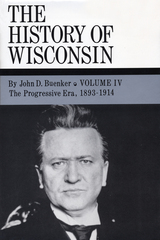 The History of Wisconsin, Volume IV: The Progressive Era, 1893-1914
John D. Buenker
Wisconsin Historical Society Press, 1998 Published in Wisconsin's Sesquicentennial year, this fourth volume in The History of Wisconsin series covers the twenty tumultuous years between the World's Columbian Exposition and the First World War when Wisconsin essentially reinvented itself, becoming the nation's "laboratory of democracy." The period known as the Progressive Era began to emerge in the mid-1890s. A sense of crisis and a widespread clamor for reform arose in reaction to rapid changes in population, technology, work, and society. Wisconsinites responded with action: their advocacy of women's suffrage, labor rights and protections, educational reform, increased social services, and more responsive government led to a veritable flood of reform legislation that established Wisconsin as the most progressive state in the union. As governor and U.S. Senator from Wisconsin, Robert M. La Follette, Sr., was the most celebrated of the Progressives, but he was surrounded by a host of pragmatic idealists from politics, government, and the state university. Although the Progressives frequently disagreed over priorities and tactics, their values and core beliefs coalesced around broad-based participatory democracy, the application of scientific expertise to governance, and an active concern for the welfare of all members of society-what came to be known as "the Wisconsin Idea."
The History of Wisconsin, Volume V: War, a New Era, and Depression, 1914-1940
Paul W. Glad
Wisconsin Historical Society Press, 1990 The fifth volume in The History of Wisconsin series covers the years from the outbreak of World War I to the eve of American entry into World War II. In between, the rise of the woman's movement, the advent of universal suffrage, and the "great experiment" of Prohibition are explored, along with the contest between newly emergent labor unions and powerful business and industrial corporations. Author Paul W. Glad also investigates the Great Depression in Wisconsin and its impact on rural and urban families in the state. Photographs and maps further illustrate this volume which tells the story of one of the most exciting and stressful eras in the history of the state.
The History of Wisconsin, Volume VI: Continuity and Change, 1940-1965
William F. Thompson
Wisconsin Historical Society Press, 1988 The sixth and final volume in the History of Wisconsin series examines the period from 1940-1965, in which state and nation struggled to maintain balance and traditions. Some of the major developments analyzed in this volume include: coping with three wars, racial and societal conflict, technological innovation, population shifts to and from cities and suburbs, and accompanying stress in politics, government, and society as a whole. Using dozens of photographs to visually illustrate this period in the state's history, this volume upholds the high standards set forth in the previous volumes.
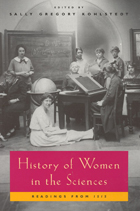 History of Women in the Sciences: Readings from Isis
Edited by Sally Gregory Kohlstedt
University of Chicago Press, 2000 Why is it that some women have created successful careers in science, when historically there have been so many barriers that exclude women from engaging in scientific work? At last, here is a comparative history that illuminates some of the patterns that have emerged in the history of women in science.
This book features some of the most influential and pioneering studies of women in the sciences, with a special focus on patterns of education, access, barriers, and opportunities for women's work in science. Spanning the 17th through the 20th centuries, the book demonstrates the meaning and power of gender experienced by women in the sciences.
Individual chapters focus on exceptional women whose unusual initiativee and particular circumstance led them to engage in science: Laura Bassi, Nettie Stevens, Maria Winkelmann, and others. Chapters on women's access to science discuss collaboration with family members in the domestic sphere, the impact of primers and popular science writing, and formal education in public schools and advanced research institutions. There are examinations of the reasons for clusters of women working in "female friendly" sciences such as botany and physiology in the 19th century and astronomy in the U.S. during the early 20th century.
This important and useful book provides a thoughtful and detailed overview for scholars and students in the history of science, as well as for feminist historians, scientists, and others who who want a comparative and historical analysis of women in the sciences.
Contributors include Janet Browne, Paula Findlen, Peggy Aldrich Kidwell, Ann Hibner Koblitz, M. Susan Lindee, Carolyn Merchant, Margaret W. Rossiter, Londa Schiebinger, Nancy Leys Stepan, and Deborah Jean Warner.
History of Women in the West
Georges Duby
Harvard University Press, 1992 Volume III of A History of Women draws a richly detailed picture of women in early modern Europe, considering them in a context of work, marriage, and family. At the heart of this volume is “woman” as she appears in a wealth of representations, from simple woodcuts and popular literature to master paintings; and as the focal point of a debate—sometimes humorous, sometimes acrimonious—conducted in every field: letters, arts, philosophy, the sciences, and medicine. Against oppressive experience, confining laws, and repetitious claims about female “nature,” women took initiative by quiet maneuvers and outright dissidence. In conformity and resistance, in image and reality, women from the sixteenth through the eighteenth centuries emerge from these pages in remarkable diversity.
History of Women in the West
Georges Duby
Harvard University Press, 1992 Has the worst of times for humanity—this century bloodied by wars and revolutions without precedent in history—been the best of times for women? How have the promises of freedom, parity with men, full participation in society, actually been met amid all the transformations and upheavals the twentieth century has witnessed? This fifth volume in the world-acclaimed series brings the history of women up to the present, placing it in the context of momentous events and profound social changes that have marked our time.
History of Women in the West
Georges Duby
Harvard University Press, 1992 Informed by the work of seventy-five distinguished historians, this five-volume series sets before us an engaging, panoramic chronicle that extends from antiquity to the present day.
The inaugural volume brings women from the margins of ancient history into the fore. It offers fresh insight into more than twenty centuries of Greek and Roman history and encompasses a landscape that stretches from the North Sea to the Mediterranean and from the Pillars of Hercules to the banks of the Indus. The authors draw upon a wide range of sources including gravestones, floor plans, papyrus rolls, vase paintings, and literary works to illustrate how representations of women evolved during this age. They journey into the minds of men and bring to light an imaginative history of women and of the relations between the sexes.
 History of Women in the West
Georges Duby
Harvard University Press, 1992 Drawing on myriad sources—from the faint traces left by the rocking of a cradle at the site of an early medieval home to an antique illustration of Eve’s fall from grace—this second volume in the celebrated series offers new perspectives on women of the past. Twelve distinguished historians from many countries examine the image of women in the masculine mind, their social condition, and their daily experience from the demise of the Roman Empire to the genesis of the Italian Renaissance.
More than in any other era, a medieval woman’s place in society was determined by men; her sexuality was perceived as disruptive and dangerous, her proper realm that of the home and cloister. The authors draw upon the writings of bishops and abbots, moralists and merchants, philosophers and legislators, to illuminate how men controlled women’s lives. Sumptuary laws regulating feminine dress and ornament, pastoral letters admonishing women to keep silent and remain chaste, and learned treatises with their fantastic theories about women’s physiology are fully explored in these pages. As adoration of the Virgin Mary reached full flower by the year 1200, ecclesiastics began to envision motherhood as a holy role; misogyny, however, flourished unrestrained in local proverbs, secular verses, and clerical thought throughout the period.
Were women’s fates sealed by the dictates of church and society? The authors investigate legal, economic, and demographic aspects of family and communal life between the sixth and the fifteenth centuries and bring to light the fleeting moments in which women managed to seize some small measure of autonomy over their lives. The notion that courtly love empowered feudal women is discredited in this volume. The pattern of wear on a hearthstone, fingerprints on a terracotta pot, and artifacts from everyday life such as scissors, thimbles, spindles, and combs are used to reconstruct in superb detail the commonplace tasks that shaped women’s existence inside and outside the home. As in antiquity, male fantasies and fears are evident in art. Yet a growing number of women rendered visions of their own gender in sumptuous tapestries and illuminations. The authors look at the surviving texts of female poets and mystics and document the stirrings of a quiet revolution throughout the West, as a few daring women began to preserve their thoughts in writing.
History of Women in the West
Georges Duby
Harvard University Press, 1992 The French Revolution opened a whole new stage in the history of women, despite their conspicuous absence from the playbill. The coming century would see women’s subordination to men codified in all manner of new laws and rules; and yet the period would also witness the birth of feminism, the unprecedented emergence of women as a collective force in the political arena.
The fourth volume in this world-acclaimed series covers the distance between these two poles, between the French Revolution and World War I. It gives us a vibrant picture of a bourgeois century, dynamic and expansive, in which the role of woman in the home was stressed more and more, even as the economic pressures and opportunities of the industrial revolution drew her out of the house; in which woman’s growing role in the family as the center of all morals and virtues pressed her into public service to fight social ills.
 A History of Young People in the West
Giovanni Levi
Harvard University Press, 1997 However swiftly it passes, youth is always with us, a perpetual passing phase, an apprenticeship to the myriad ways of the world, subject of panegyrics and diatribes, romances and cautionary tales from antiquity to our day. This two-volume history is the first to present a comprehensive account of what youth has been in the West and what it has meant through the ages. Brought together by Giovanni Levi and Jean-Claude Schmitt, a company of gifted historians and social scientists traces the changing character and status of young people from the gymnasia of ancient Greece to the lycées of modern France, from the sweatshops of the industrial revolution to the crucibles of Nazi youth.
Monumental in its scope, minute in its attention to detail, A History of Young People takes us into the sensational rituals surrounding youth in Roman antiquity (such as the Lupercalia, with its nudity and whipping) and into the chivalric trials awaiting the privileged young of the Middle Ages. Elisabeth Crouzet-Pavan and Michel Pastoureau explore the elusive question of what defines youth, a concept that over time has reached from infancy to the age of forty. Elliott Horowitz and Renata Ago consider the young in the context of the family--within the different worlds of European Judaism and Catholicism through the Renaissance. Sabina Loriga takes us through three centuries of military experience to temper and complicate our assumptions about the youthful face of war. Michelle Perrot focuses on working-class youth, and Jean-Claude Caron on the young at school. The obedient and the rebellious are here, the cherished and the sacrificed, the children catapulted into adult responsibility, the adults who have yet to forsake the protections of childhood. What emerges in this history as never before is a vast, richly textured picture of youth as a changing constant of culture, society, economics, politics, and art, and as a uniquely complex experience of acculturation in every life.
 A History of Young People in the West
Giovanni Levi
Harvard University Press, 1997 However swiftly it passes, youth is always with us, a perpetual passing phase, an apprenticeship to the myriad ways of the world, subject of panegyrics and diatribes, romances and cautionary tales from antiquity to our day. This two-volume history is the first to present a comprehensive account of what youth has been in the West and what it has meant through the ages. Brought together by Giovanni Levi and Jean-Claude Schmitt, a company of gifted historians and social scientists traces the changing character and status of young people from the gymnasia of ancient Greece to the lycées of modern France, from the sweatshops of the industrial revolution to the crucibles of Nazi youth.
Monumental in its scope, minute in its attention to detail, A History of Young People takes us into the sensational rituals surrounding youth in Roman antiquity (such as the Lupercalia, with its nudity and whipping) and into the chivalric trials awaiting the privileged young of the Middle Ages. Elisabeth Crouzet-Pavan and Michel Pastoureau explore the elusive question of what defines youth, a concept that over time has reached from infancy to the age of forty. Elliott Horowitz and Renata Ago consider the young in the context of the family--within the different worlds of European Judaism and Catholicism through the Renaissance. Sabina Loriga takes us through three centuries of military experience to temper and complicate our assumptions about the youthful face of war. Michelle Perrot focuses on working-class youth, and Jean-Claude Caron on the young at school. The obedient and the rebellious are here, the cherished and the sacrificed, the children catapulted into adult responsibility, the adults who have yet to forsake the protections of childhood. What emerges in this history as never before is a vast, richly textured picture of youth as a changing constant of culture, society, economics, politics, and art, and as a uniquely complex experience of acculturation in every life.
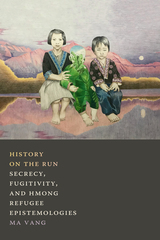 History on the Run: Secrecy, Fugitivity, and Hmong Refugee Epistemologies
Ma Vang
Duke University Press, 2021 During its secret war in Laos (1961–1975), the United States recruited proxy soldiers among the Hmong people. Following the war, many of these Hmong soldiers migrated to the United States with refugee status. In History on the Run Ma Vang examines the experiences of Hmong refugees in the United States to theorize refugee histories and secrecy, in particular those of the Hmong. Vang conceptualizes these histories as fugitive histories, as they move and are carried by people who move. Charting the incomplete archives of the war made secret through redacted US state documents, ethnography, film, and literature, Vang shows how Hmong refugees tell their stories in ways that exist separately from narratives of U.S. empire and that cannot be traditionally archived. In so doing, Vang outlines a methodology for writing histories that foreground refugee epistemologies despite systematic attempts to silence those histories.
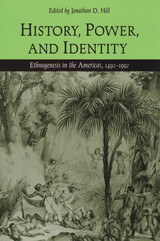 History, Power, and Identity: Ethnogenesis in the Americas, 1492-1992
Jonathan D. Hill
University of Iowa Press, 1996 For the past five centuries, indigenous and African American communities throughout the Americas have sought to maintain and recreate enduring identities under conditions of radical change and discontinuity. The essays in this groundbreaking volume document this cultural activity—this ethnogenesis—within and against the broader contexts of domination; the authors simultaneously encompass the entanglements of local communities in the webs of national and global power relations as well as people's unique abilities to gain control over their history and identity. By defining ethnogenesis as the synthesis of people's cultural and political struggles, History, Power, and Identity breaks out of the implicit contrast between isolated local cultures and dynamic global history. From the northeastern plains of North America to Amazonia, colonial and independent states in the Americas interacted with vast multilingual and multicultural networks, resulting in the historical emergence of new ethnic identities and the disappearance of many earlier ones. The importance of African, indigenous American, and European religions, myths, and symbols, as historical cornerstones in the building of new ethnic identities, emerges as one of the central themes of this convincing collection.
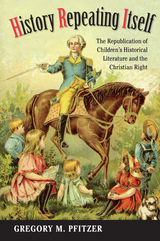 History Repeating Itself: The Republication of Children's Historical Literature and the Christian Right
Gregory M. Pfitzer
University of Massachusetts Press, 2014 Recently publishers on the Christian Right have been reprinting nineteenth-century children's history books and marketing them to parents as "anchor texts" for homeschool instruction. Why, Gregory M. Pfitzer asks, would books written more than 150 years ago be presumed suitable for educating twenty-first-century children? The answer, he proposes, is that promoters of these recycled works believe that history as a discipline took a wrong turn in the early twentieth century, when progressive educators introduced social studies methodologies into public school history classrooms, foisting upon unsuspecting and vulnerable children ideologically distorted history books.
In History Repeating Itself, Pfitzer tests these assertions by scrutinizing and contextualizing the original nineteenth-century texts on which these republications are based. He focuses on how the writers borrowed from one another to produce works that were similar in many ways yet differed markedly in terms of pedagogical strategy and philosophy of history. Pfitzer demonstrates that far from being non-ideological, these works were rooted in intense contemporary debates over changing conceptions of childhood.
Pfitzer argues that the repurposing of antiquated texts reveals a misplaced resistance to the idea of a contested past. He also raises essential philosophical questions about how and why curricular decisions are shaped by the "past we choose to remember" on behalf of our children.
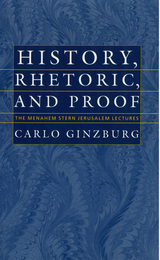 History, Rhetoric, and Proof
Carlo Ginzburg
Brandeis University Press, 1999 Historian Carlo Ginzburg uses the occasion of his Menachem Stern Lectureship to present a provocative and characteristically brilliant examination of the relation between rhetoric and historiography. In four lectures, based on a wide range of texts -- Aristotle's Poetics; humanist Lorenzo Valla's tract exposing the Donation of Constantine as a forgery; an early 18th-century Jesuit historical account purporting to record the diatribe of a Mariana Island native against Spanish rule; and Proust's commentary on Flaubert's style -- he demonstrates that rhetoric, if properly understood, is related not only to ornament but to historical understanding and truth. Ginzburg discovers a middle ground between the empiricist or positivist view of history, and the current postmodern tendency to regard any historical account as just one among an infinity of possible narratives, distinguished or measured not by the standard of truth, but by rhetorical skill. As a whole, these lectures stake out a position that both mediates and transcends warring factions in the current historiographical debate.
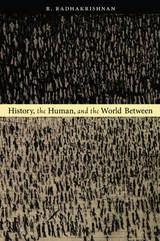 History, the Human, and the World Between
R. Radhakrishnan
Duke University Press, 2008 History, the Human, and the World Between is a philosophical investigation of the human subject and its simultaneous implication in multiple and often contradictory ways of knowing. The eminent postcolonial theorist R. Radhakrishnan argues that human subjectivity is always constituted “between”: between subjective and objective, temporality and historicity, being and knowing, the ethical and the political, nature and culture, the one and the many, identity and difference, experience and system. In this major study, he suggests that a reconstituted phenomenology has a crucial role to play in mediating between generic modes of knowledge production and an experiential return to life. Keenly appreciative of poststructuralist critiques of phenomenology, Radhakrishnan argues that there is still something profoundly vulnerable at stake in the practice of phenomenology. Radhakrishnan develops his rationale of the “between” through three linked essays where he locates the terms “world,” “history,” “human,” and “subject” between phenomenology and poststructuralism, and in the process sets forth a nuanced reading of the politics of a gendered postcolonial humanism. Critically juxtaposing the works of thinkers such as Friedrich Nietzsche, Adrienne Rich, Frantz Fanon, Edward Said, Michel Foucault, Maurice Merleau-Ponty, Martin Heidegger, David Harvey, and Ranajit Guha, Radhakrishnan examines the relationship between systems of thought and their worldly situations. History, the Human, and the World Between is a powerful argument for a theoretical perspective that combines the existential urgency of phenomenology with the discursive rigor of poststructuralist practices.
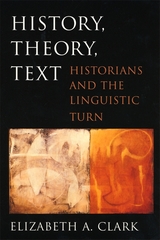 History, Theory, Text: Historians and the Linguistic Turn
Elizabeth A. Clark
Harvard University Press, 2004 In this work of sweeping erudition, one of our foremost historians of early Christianity considers a variety of theoretical critiques to examine the problems and opportunities posed by the ways in which history is written. Elizabeth Clark argues forcefully for a renewal of the study of premodern Western history through engagement with the kinds of critical methods that have transformed other humanities disciplines in recent decades.
History, Theory, Text provides a user-friendly survey of crucial developments in nineteenth- and twentieth-century debates surrounding history, philosophy, and critical theory. Beginning with the "noble dream" of "history as it really was" in the works of Leopold von Ranke, Clark goes on to review Anglo-American philosophies of history, schools of twentieth-century historiography, structuralism, the debate over narrative history, the changing fate of the history of ideas, and the impact of interpretive anthropology and literary theory on current historical scholarship. In a concluding chapter she offers some practical case studies to illustrate how attending to theoretical considerations can illuminate the study of premodernity.
Written with energy and clarity, History, Theory, Text is a clarion call to historians for richer and more imaginative use of contemporary theory.
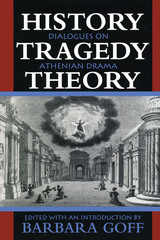 History, Tragedy, Theory: Dialogues on Athenian Drama
Edited and with an introduction by Barbara Goff
University of Texas Press, 1995 Greek tragedy has held sway over the imagination of audiences for well over two millennia. This collection of essays on Athenian drama, the proceedings of a conference held at the University of Texas at Austin in 1992, demonstrates that Greek tragedy still retains its power to provoke debate and to engage the interest of specialists and non-classicists alike. The book includes essays by seven of the foremost scholars of Greek drama—Helene Foley, Michelle Gellrich, Peter W. Rose, David Rosenbloom, Richard Seaford, Bernd Seidensticker, and Froma I. Zeitlin. These writers explore the work of all three great tragedians, Aeschylus, Sophocles, and Euripides, and approach them from a variety of perspectives on history and theory, including poststructuralism and Marxism. They investigate the possibilities for coordinating theoretically informed readings of tragedy with a renewed attention to the pressure of material history within those texts. The collection thus represents a response within classics to "New Historicism" and the debates it has generated within related literary disciplines.
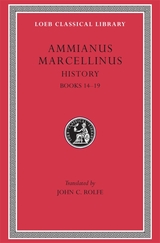 History, Volume I: Books 14–19
Ammianus Marcellinus
Harvard University Press A soldier’s chronicle of Rome in decline.
Ammianus Marcellinus (ca. AD 325–ca. 395), a Greek of Antioch, joined the army when still young and served under the governor Ursicinus and the emperor of the East Constantius II, and later under the emperor Julian, whom he admired and accompanied against the Alamanni and the Persians. He subsequently settled in Rome, where he wrote in Latin a history of the Roman empire in the period AD 96–378, entitled Rerum Gestarum Libri XXXI. Of these 31 books only 14–31 (AD 353–378) survive, a remarkably accurate and impartial record of his own times. Soldier though he was, he includes economic and social affairs. He was broadminded towards non-Romans and towards Christianity. We get from him clear indications of causes of the fall of the Roman empire. His style indicates that his prose was intended for recitation.
The Loeb Classical Library edition of Ammianus Marcellinus is in three volumes.
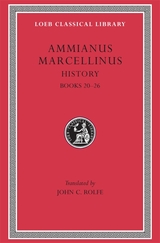 History, Volume II: Books 20–26
Ammianus Marcellinus
Harvard University Press A soldier’s chronicle of Rome in decline.
Ammianus Marcellinus (ca. AD 325–ca. 395), a Greek of Antioch, joined the army when still young and served under the governor Ursicinus and the emperor of the East Constantius II, and later under the emperor Julian, whom he admired and accompanied against the Alamanni and the Persians. He subsequently settled in Rome, where he wrote in Latin a history of the Roman empire in the period AD 96–378, entitled Rerum Gestarum Libri XXXI. Of these 31 books only 14–31 (AD 353–378) survive, a remarkably accurate and impartial record of his own times. Soldier though he was, he includes economic and social affairs. He was broadminded towards non-Romans and towards Christianity. We get from him clear indications of causes of the fall of the Roman empire. His style indicates that his prose was intended for recitation.
The Loeb Classical Library edition of Ammianus Marcellinus is in three volumes.
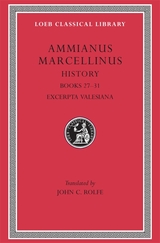 History, Volume III: Books 27–31. Excerpta Valesiana
Ammianus Marcellinus
Harvard University Press A soldier’s chronicle of Rome in decline.
Ammianus Marcellinus (ca. AD 325–ca. 395), a Greek of Antioch, joined the army when still young and served under the governor Ursicinus and the emperor of the East Constantius II, and later under the emperor Julian, whom he admired and accompanied against the Alamanni and the Persians. He subsequently settled in Rome, where he wrote in Latin a history of the Roman empire in the period AD 96–378, entitled Rerum Gestarum Libri XXXI. Of these 31 books only 14–31 (AD 353–378) survive, a remarkably accurate and impartial record of his own times. Soldier though he was, he includes economic and social affairs. He was broadminded towards non-Romans and towards Christianity. We get from him clear indications of causes of the fall of the Roman empire. His style indicates that his prose was intended for recitation.
The Loeb Classical Library edition of Ammianus Marcellinus is in three volumes.
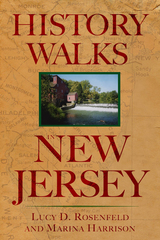 History Walks in New Jersey
Rosenfeld, Lucy D
Rutgers University Press, 2006 New Jersey has a varied and fascinating history-from its earliest Native American settlements, through its central role in the Revolutionary War, to its strategic position in the major events of our country's past. In History Walks in New Jersey, Lucy D. Rosenfeld and Marina Harrison treat readers to a comprehensive statewide guidebook that includes detailed information on forty-eight of the best sites for historical walks. These outings take the history enthusiast through beautiful green landscapes, natural preserves, and picturesque settlements.
Whether you are an amateur historian, a weekend walker, or a teacher planning a class trip, this book will be an essential resource for ideas and information. Walks include the Kingston Loop, a long canal where George Washington, pen in hand, composed his post-Revolutionary War speech, "Farewell Orders to the Armies of the United States." Also included is a mountain walk that traces Native American Leni-Lenape history and one that wends its way into an old Moravian village in the town of Hope. A pirate cove, stops on the Underground Railroad, a Civil War cemetery, and the sites of duels, mines, canals, architectural innovations, estates and resorts, centuries-old agricultural and fishing settlements, and the Hindenburg crash are all here.
Each walk includes directions, information on tours, a brief history, and suggestions for additional places to visit in the area. Whether a New Jersey native or a visitor to the Garden State, readers will enjoy going beyond the highways and suburban towns to learn about history while discovering the state's natural beauty.
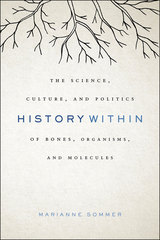 History Within: The Science, Culture, and Politics of Bones, Organisms, and Molecules
Marianne Sommer
University of Chicago Press, 2016 Personal genomics services such as 23andMe and Ancestry.com now offer what once was science fiction: the ability to sequence and analyze an individual’s entire genetic code—promising, in some cases, facts about that individual’s ancestry that may have remained otherwise lost. Such services draw on and contribute to the science of human population genetics that attempts to reconstruct the history of humankind, including the origin and movement of specific populations. Is it true, though, that who we are and where we come from is written into the sequence of our genomes? Are genes better documents for determining our histories and identities than fossils or other historical sources?
Our interpretation of gene sequences, like our interpretation of other historical evidence, inevitably tells a story laden with political and moral values. Focusing on the work of Henry Fairfield Osborn, Julian Sorell Huxley, and Luigi Luca Cavalli-Sforza in paleoanthropology, evolutionary biology, and human population genetics, History Within asks how the sciences of human origins, whether through the museum, the zoo, or the genetics lab, have shaped our idea of what it means to be human. How have these biologically based histories influenced our ideas about nature, society, and culture? As Marianne Sommer shows, the stories we tell about bones, organisms, and molecules often change the world.
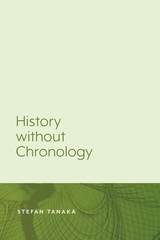 History without Chronology
Stefan Tanaka
Lever Press, 2019 Although numerous disciplines recognize multiple ways of conceptualizing time, Stefan Tanaka argues that scholars still overwhelmingly operate on chronological and linear Newtonian or classical time that emerged during the Enlightenment. This short, approachable book implores the humanities and humanistic social sciences to actively embrace the richness of different times that are evident in non-modern societies and have become common in several scientific fields throughout the twentieth century. Tanaka first offers a history of chronology by showing how the social structures built on clocks and calendars gained material expression. Tanaka then proposes that we can move away from this chronology by considering how contemporary scientific understandings of time might be adapted to reconceive the present and pasts. This opens up a conversation that allows for the possibility of other ways to know about and re-present pasts. A multiplicity of times will help us broaden the historical horizon by embracing the heterogeneity of our lives and world via rethinking the complex interaction between stability, repetition, and change. This history without chronology also allows for incorporating the affordances of digital media.
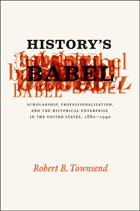 History's Babel: Scholarship, Professionalization, and the Historical Enterprise in the United States, 1880 - 1940
Robert B. Townsend
University of Chicago Press, 2012 From the late nineteenth century until World War II, competing spheres of professional identity and practice redrew the field of history, establishing fundamental differences between the roles of university historians, archivists, staff at historical societies, history teachers, and others. In History’s Babel, Robert B. Townsend takes us from the beginning of this professional shift—when the work of history included not just original research, but also teaching and the gathering of historical materials—to a state of microprofessionalization that continues to define the field today. Drawing on extensive research among the records of the American Historical Association and a multitude of other sources, Townsend traces the slow fragmentation of the field from 1880 to the divisions of the 1940s manifest today in the diverse professions of academia, teaching, and public history. By revealing how the founders of the contemporary historical enterprise envisioned the future of the discipline, he offers insight into our own historical moment and the way the discipline has adapted and changed over time. Townsend’s work will be of interest not only to historians but to all who care about how the professions of history emerged, how they might go forward, and the public role they still can play.
 History's Erratics: Irish Catholic Dissidents and the Transformation of American Capitalism, 1870-1930
David M. Emmons
University of Illinois Press, 2024 As Ice Age glaciers left behind erratics, so the external forces of history tumbled the Irish into America. Existing both out of time and out of space, a diverse range of these Roman-Catholic immigrants saw their new country in a much different way than did the Protestants who settled and claimed it. These erratics chose backward looking tradition and independence over assimilation and embraced a quintessentially Irish form of subversiveness that arose from their culture, faith, and working-class outlook. David M. Emmons draws on decades of research and thought to plumb the mismatch of values between Protestant Americans hostile to Roman Catholicism and the Catholic Irish strangers among them. Joining ethnicity and faith to social class, Emmons explores the unique form of dissidence that arose when Catholic Irish workers and their sympathizers rejected the beliefs and symbols of American capitalism. A vibrant and original tour de force, History’s Erratics explores the ancestral roots of Irish nonconformity and defiance in America.
 History's Memory: Writing America’s Past, 1880-1980
Ellen Fitzpatrick
Harvard University Press, 2004 Enthusiasts and critics both have looked to the political upheavals of the 1960s to explain recent transformations in historical study. But how new, in fact, are our contemporary approaches to the study and writing of American history? This question lies at the heart of History's Memory, Ellen Fitzpatrick's sweeping study of the past century of American historical writing.
Through careful examination of hundreds of historical essays and books, Fitzpatrick has uncovered striking continuities in the writing of American history. The contributions of earlier scholars, some of them outside the mainstream of the historical profession, reveal that interest in the history of women, African Americans, Native Americans, and the working class has been long-standing. Whether in the Progressive era's attention to issues of class, or in the renewed concern with Native Americans in the 1930s and 1940s, Fitzpatrick demonstrates that over the past century historians have frequently grappled with issues that we think of today as innovative.
This reinterpretation of a century of American historical writing challenges the notion that the politics of the recent past alone explains the politics of history. Fitzpatrick offers a wise historical perspective on today's heated debates, and reclaims the long line of historians who tilled the rich and diverse soil of our past.
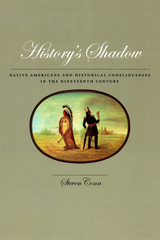 History's Shadow: Native Americans and Historical Consciousness in the Nineteenth Century
Steven Conn
University of Chicago Press, 2004 Who were the Native Americans? Where did they come from and how long ago? Did they have a history, and would they have a future? Questions such as these dominated intellectual life in the United States during the nineteenth century. And for many Americans, such questions about the original inhabitants of their homeland inspired a flurry of historical investigation, scientific inquiry, and heated political debate. History's Shadow traces the struggle of Americans trying to understand the people who originally occupied the continent claimed as their own. Steven Conn considers how the question of the Indian compelled Americans to abandon older explanatory frameworks for sovereignty like the Bible and classical literature and instead develop new ones. Through their engagement with Native American language and culture, American intellectuals helped shape and define the emerging fields of archaeology, ethnology, linguistics, and art. But more important, the questions posed by the presence of the Indian in the United States forced Americans to confront the meaning of history itself, both that of Native Americans and their own: how it should be studied, what drove its processes, and where it might ultimately lead. The encounter with Native Americans, Conn argues, helped give rise to a distinctly American historical consciousness. A work of enormous scope and intellect, History's Shadow will speak to anyone interested in Native Americans and their profound influence on our cultural imagination. “History’s Shadow is an intelligent and comprehensive look at the place of Native Americans in Euro-American’s intellectual history. . . . Examining literature, painting, photography, ethnology, and anthropology, Conn mines the written record to discover how non-Native Americans thought about Indians.” —Joy S. Kasson, Los Angeles Times
Histrionics: Three Plays
Thomas Bernhard
University of Chicago Press, 1990 Although he is best known in the United States as a novelist, Austrian writer Thomas Bernhard has been hailed in Europe as one of the most significant and controversial of contemporary playwrights. George Steiner has predicted that the current era in German-language literature will be recognized as the "Bernhard period"; John Updike compares Bernhard with Kafka, Grass, Handke, and Weiss. His dark, absurdist plays can be likened to those of Beckett and Pinter, but their cultural and political concerns are distinctly Bernhard's. While Austria's recent political history lends particular credibility to Bernhard's satire, his criticisms are directed at the modern world generally; his plays grapple with questions of totalitarianism and the subjection of the individual and with notions of reality and appearance.
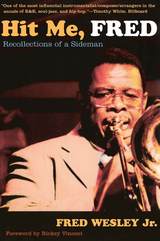 Hit Me, Fred: Recollections of a Sideman
Fred Wesley Jr.
Duke University Press, 2005 With Hit Me, Fred, sensational sideman Fred Wesley Jr. moves front and center to tell his life story. A legendary funk, soul, and jazz musician, Wesley is best known for his work in the late sixties and early seventies with James Brown and as the leader of Brown’s band, Fred Wesley and the JB’s. Having been the band’s music director, arranger, trombone player, and frequent composer, Wesley is one of the original architects of funk music. He describes what it was like working for the Godfather of Soul, revealing the struggle and sometimes stringent discipline behind Brown’s tight, raucous tunes. After leaving Brown and the JB’s, Wesley arranged the horn sections for Parliament, Funkadelic, and Bootsy’s Rubber Band, and led Fred Wesley and the Horny Horns. Adding his signature horn arrangements to the P-Funk mix, Wesley made funk music even funkier.
Wesley’s distinctive sound reverberates through rap and hip-hop music today. In Hit Me, Fred, he recalls the many musicians whose influence he absorbed, beginning with his grandmother and father—both music teachers—and including mentors in his southern Alabama hometown and members of the Army band. In addition to the skills he developed working with James Brown, George Clinton, Bootsy Collins, and the many talented musicians in their milieu, Wesley describes the evolution of his trombone playing through stints with the Ike and Tina Turner Revue, Hank Ballard, and Count Basie’s band. He also recounts his education in the music business, particularly through his work in Los Angeles recording sessions.
Wesley is a virtuoso storyteller, whether he's describing the electric rush of performances when the whole band is in the groove, the difficulties of trying to make a living as a rhythm and blues musician, or the frustrations often felt by sidemen. Hit Me, Fred is Wesley’s story of music-making in all its grit and glory.
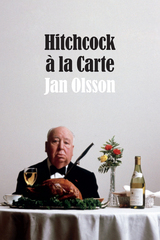 Hitchcock à la Carte
Jan Olsson
Duke University Press, 2015 Alfred Hitchcock: cultural icon, master film director, storyteller, television host, foodie. And as Jan Olsson argues in Hitchcock à la Carte, he was also an expert marketer who built his personal brand around his rotund figure and well-documented table indulgencies. Focusing on Hitchcock's television series Alfred Hitchcock Presents (1955-1962) and the The Alfred Hitchcock Hour (1962-1965), Olsson asserts that the success of Hitchcock's media empire depended on his deft manipulation of bodies and the food that sustained them. Hitchcock's strategies included frequently playing up his own girth, hiring body doubles, making numerous cameos, and using food—such as a frozen leg of lamb—to deliver scores of characters to their deaths. Constructing his brand enabled Hitchcock to maintain creative control, blend himself with his genre, and make himself the multi-million-dollar franchise's principal star. Olsson shows how Hitchcock's media brand management was a unique performance model that he used to mark his creative oeuvre as strictly his own.
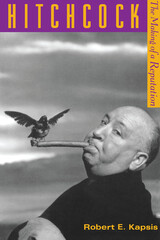 Hitchcock: The Making of a Reputation
Robert E. Kapsis
University of Chicago Press, 1992 From the beginning of his career, Alfred Hitchcock wanted to be considered an artist. Although his thrillers were immensely popular, and Hitchcock himself courted reviewers, he was, for many years, regarded as no more than a master craftsman. By the 1960s, though, critics began calling him an artist of unique vision and gifts. What happened to make Hitchcock's reputation as a true innovator and singular talent?
Through a close examination of Hitchcock's personal papers, scripts, production notes, publicity files, correspondence, and hundreds of British and American reviews, Robert Kapsis here traces Hitchcock's changing critical fortunes. Vertigo, for instance, was considered a flawed film when first released; today it is viewed by many as the signal achievement of a great director. According to Kapsis, this dramatic change occurred because the making of the Hitchcock legend was not solely dependent on the quality of his films. Rather, his elevation to artist was caused by a successful blending of self-promotion, sponsorship by prominent members of the film community, and, most important, changes in critical theory which for the first time allowed for the idea of director as auteur.
Kapsis also examines the careers of several other filmmakers who, like Hitchcock, have managed to cross the line that separates craftsman from artist, and shows how Hitchcock's legacy and reputation shed light on the way contemporary reputations are made. In a chapter about Brian De Palma, the most reknowned thriller director since Hitchcock, Kapsis explores how Hitchcock's legacy has affected contemporary work in—and criticism of—the thriller genre.
Filled with fascinating anecdotes and intriguing excerpts, and augmented by interviews with Hitchcock's associates, this thoroughly documented and engagingly written book will appeal to scholars and film enthusiasts alike.
"Required reading for Hitchcock scholars...scrupulously researched, invaluable material for those who continue to ask: what made the master tick?"—Anthony Perkins
 Hitchcock: The Murderous Gaze
William Rothman
Harvard University Press No reader of this challenging book will ever view a Hitchcock film (perhaps any film) in quite the same way again. By a close analysis of five representative works and documenting his readings with more than 600 frame enlargements, Rothman shows how Hitchcock composed his films—how each moment bears his imprint and his special demands on the viewer.
It is the seriousness of Hitchcock's reflections on the murderous power of the camera's gaze, and on the larger mysteries of love and murder, that makes him a monumental figure in the history of film. Rothman follows the course of these reflections from the gripping images of the silent film The Lodger (1926) to what he terms Hitchcock's final call for acknowledgment in Psycho (1960). The continuity is traced through Murder! (1930), the most ambitious of the early films; The Thirty-Nine Steps (1935), which established a new genre (the "Hitchcock thriller") and gave the world its sense of Hitchcock as the "master of suspense"; and Shadow of a Doubt (1943), the director's cunning demonstration to an American audience of what a Hitchcock film really is.
Rothman's readings immeasurably deepen our appreciation of Hitchcock's individual achievement. At the same time the book is a sustained meditation, philosophically scrupulous, on the medium and the art of film, on the conditions of authorship in film, and on the ways that serious films might be approached in acts of viewing and criticism.
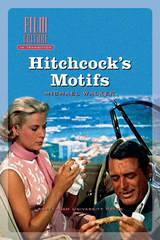 Hitchcock's Motifs
Michael Walker
Amsterdam University Press, 2006 Alfred Hitchcock’s films are renowned the world over, and a mountain of literature has detailed seemingly every facet of them. Yet remarkably few studies have solely focused on the recurring motifs in Hitchcock’s films. Michael Walker remedies this surprising gap in Hitchcock literature with an innovative and in-depth study of the sustained motifs and themes threaded through Hitchcock’s entire body of work.
Combing through all fifty-two extant feature films and representative episodes from Hitchcock’s television series, Walker traces over forty motifs that emerge in recurring objects, settings, character-types, and events. Whether the loaded meaning of staircases, the symbolic status of keys and handbags, homoeroticism, guilt and confession, or the role of art, Walker analyzes such elements to reveal a complex web of cross-references in Hitchcock’s art. He also gives full attention to the broader social contexts in which the motifs and themes are played out, arguing that these interwoven elements add new and richer depths to Hitchcock’s oeuvre. An invaluable, encyclopedic resource for the scholar and fan, Hitchcock’s Motifs is a fascinating study of one of the best-known and most admired film directors in history.
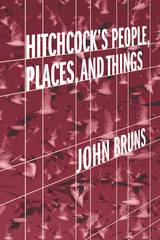 Hitchcock's People, Places, and Things
John Bruns
Northwestern University Press, 2019 Hitchcock’s People, Places, and Things argues that Alfred Hitchcock was as much a filmmaker of things and places as he was of people. Drawing on the thought of Bruno Latour, John Bruns traces the complex relations of human and nonhuman agents in Hitchcock’s films with the aim of mapping the Hitchcock landscape cognitively, affectively, and politically. Yet this book does not promise that such a map can or will cohere, for Hitchcock was just as adept at misdirection as he was at direction. Bearing this in mind and true to the Hitchcock spirit, Hitchcock’s People, Places, and Things anticipates that people will stumble into the wrong places at the wrong time, places will be made uncanny by things, and things exchanged between people will act as (not-so) secret agents that make up the perilous landscape of Hitchcock’s work.
This book offers new readings of well-known Hitchcock films, including The Lodger, Shadow of a Doubt, Psycho, The Birds, and Marnie, as well as insights into lesser-discussed films such as I Confess and Family Plot. Additional close readings of the original theatrical trailer for Psycho and a Hitchcock-directed episode of Alfred Hitchcock Presents expand the Hitchcock landscape beyond conventional critical borders. In tracing the network of relations in Hitchcock’s work, Bruns brings new Hitchcockian tropes to light. For students, scholars, and serious fans, the author promises a thrilling critical navigation of the Hitchcock landscape, with frequent “mental shake-ups” that Hitchcock promised his audience.
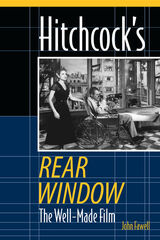 Hitchcock's Rear Window: The Well-Made Film
John Fawell
Southern Illinois University Press, 2004 In the process of providing the most extensive analysis of Alfred Hitchcock’s Rear Window to date, John Fawell also dismantles many myths and clichés about Hitchcock, particularly in regard to his attitude toward women. Although Rear Window masquerades quite successfully as a piece of light entertainment, Fawell demonstrates just how complex the film really is. It is a film in which Hitchcock, the consummate virtuoso, was in full command of his technique. One of Hitchcock’s favorite films, Rear Window offered the ideal venue for the great director to fully use the tricks and ideas he acquired over his previous three decades of filmmaking. Yet technique alone did not make this classic film great; one of Hitchcock’s most personal films, Rear Window is characterized by great depth of feeling. It offers glimpses of a sensibility at odds with the image Hitchcock created for himself—that of the grand ghoul of cinema who mocks his audience with a slick and sadistic style. Though Hitchcock is often labeled a misanthrope and misogynist, Fawell finds evidence in Rear Window of a sympathy for the loneliness that leads to voyeurism and crime, as well as an empathy for the film’s women. Fawell emphasizesa more feeling, humane spirit than either Hitchcock’s critics have granted him or Hitchcock himself admitted to, and does so in a manner of interest to film scholars and general readers alike.
 Hitler and His Generals: The Hidden Crisis, January-June 1938
Harold C. Deutsch
University of Minnesota Press, 1974 Hitler and His Generals was first published in 1974. Minnesota Archive Editions uses digital technology to make long-unavailable books once again accessible, and are published unaltered from the original University of Minnesota Press editions. The author, who told the story of second of four conspiratorial rounds in his earlier book The Conspiracy against Hitler in the Twilight War,describes here the situations and events leading up to the first round of conspiracy. The present volume deals with the virtual coup d'etat by which Hitler sought to establish ascendancy over the Wehrmacht early in 1938. The account focuses on sensational events centering about Hitler's successful efforts to oust Field Marshal Werner von Blomberg, the War Minister, and Colonel General Baron von Fritsch, the Army commander in chief, in order to consolidate control of the military in his own hands. Using as an excuse Blomberg's marriage to a woman with a discreditable past, he forced Blomberg's resignation. He accomplished Fritsch's resignation through charges of homosexuality which were trumped up by Himmler, Heydrich, and Goering. He then appointed Colonel General Walther von Brauchitsch, who was under personal obligation to him, as commander in chief. Through these moves, as Dr. Deutsch shows, Hitler closed the door to all means other than conspiracy for the active Opposition movement to express itself against his aggressive policies. The story of the first round of conspiracy will be the subject of another book by Professor Deutsch, to be published later.
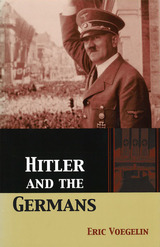 Hitler and the Germans
Eric Voegelin, Edited, Translated, & Intro by Detlev Clemens & Brendan Purcell
University of Missouri Press, 2003 Between 1933 and 1938, Eric Voegelin published four books that brought him into increasingly open opposition to the Hitler regime in Germany. As a result, he was forced to leave Austria in 1938, narrowly escaping arrest by the Gestapo as he fled to Switzerland and later to the United States. Twenty years later, he was invited to return to Germany as director of the new Institute of Political Science at Ludwig-Maximilian University in Munich. In 1964, Voegelin gave a series of memorable lectures on what he considered "the central German experiential problem" of his time: Adolf Hitler's rise to power, the reasons for it, and its consequences for post-Nazi Germany. For Voegelin, these issues demanded a scrutiny of the mentality of individual Germans and of the order of German society during and after the Nazi period. Hitler and the Germans offers Voegelin's most extensive and detailed critique of the Hitler era. While most of the lectures deal with what Voegelin called Germany’s "descent into the depths" of the moral and spiritual abyss of Nazism and its aftermath, they also point toward a restoration of order. His lecture "The Greatness of Max Weber" shows how Weber, while affected by the culture within which Hitler came to power, had already gone beyond it through his anguished recovery of the experience of transcendence. Hitler and the Germans provides a profound alternative approach to the topic of the individual German's entanglement in the Hitler regime and its continuing implications. This comprehensive critique of the Nazi period has yet to be matched.
Hitler in History
Eberhard Jäckel
Brandeis University Press, 2000 A leading interpreter of the Nazi period addresses crucial issues in modern European and contemporary history.
Hitler, My Father: A Novel of World War Two, Hitler's Unknown Lover, and Son.
Rodney Merten
Parkhurst Brothers, Inc., 2017 An adoring young woman encounters Adolph Hitler when her youth group sings for him. He demands her company in private, and she becomes pregnant, bearing his child but never being contacted by Hitler again. The plot follows her life as an outcast believed to be lying about the child’s parentage, and the life of her son told through her correspondence, diary entries, and from the point of view of a researcher who writes a generation later. Based on facts and documented history, author Ron Merten tells this tale with just enough creativity to make the story fascinating.
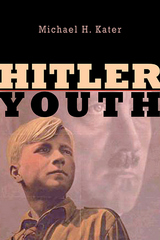 Hitler Youth
Michael H. Kater
Harvard University Press, 2004 In modern times, the recruitment of children into a political organization and ideology reached its boldest embodiment in the Hitler Youth, founded in 1933 soon after the Nazi Party assumed power in Germany. Determining that by age ten children's minds could be turned from play to politics, the regime inducted nearly all German juveniles between the ages of ten and eighteen into its state-run organization. The result was a potent tool for bending young minds and hearts to the will of Adolf Hitler.
Baldur von Schirach headed a strict chain of command whose goal was to shift the adolescents' sense of obedience from home and school to the racially defined Volk and the Third Reich. Luring boys and girls into Hitler Youth ranks by offering them status, uniforms, and weekend hikes, the Nazis turned campgrounds into premilitary training sites, air guns into machine guns, sing-alongs into marching drills, instruction into indoctrination, and children into Nazis. A few resisted for personal or political reasons, but the overwhelming majority enlisted.
Drawing on original reports, letters, diaries, and memoirs, Kater traces the history of the Hitler Youth, examining the means, degree, and impact of conversion, and the subsequent fate of young recruits. Millions of Hitler Youth joined the armed forces; thousands gleefully participated in the subjugation of foreign peoples and the obliteration of "racial aliens." Although young, they committed crimes against humanity for which they cannot escape judgment. Their story stands as a harsh reminder of the moral bankruptcy of regimes that make children complicit in crimes of the state.
 A Hitler Youth in Poland: The Nazi Children's Evacuation Program During World War II
Jost Hermand
Northwestern University Press, 1997 Jost Hermand's A Hitler Youth in Poland is an invaluable first-hand account of his experience in Nazi education camps for German children, four in Poland. An important addition to the growing record of the childhood experiences of so-called Kriegskinder (children of war) in Germany during the Nazi regime, A Hitler Youth in Poland is a memoir of Germany's Kinderlandverschickung (KLV) program, by which German children were evacuated from large cities to countryside camps designed to toughen and prepare them for future careers in the military.
During the Nazi era, millions of German children between the ages of seven and sixteen were taken from their homes and sent to Hitler Youth paramilitary camps to be toughened up and taught how to be "German." Separated from their families and sent to the far-flung corners of Europe, these children often endured incredible abuse by the adults in charge. In this memoir, Jost Hermand, a cultural critic and historian who spent much of his youth in five different camps, writes about his experiences as a small, unathletic boy thrown into a "wolf pack" governed by brutalization, dreary routine, and sadism.
Intelligent and persuasive, A Hitler Youth in Poland should be read by anyone interested in psychology or the history of everyday life in Hitler's Germany and the mental scars of adults born during the Nazi regime.
 Hitler’s Economy: Nazi Work Creation Programs, 1933–1936
Dan P. Silverman
Harvard University Press, 1998 When Hitler assumed the German chancellorship in January 1933, 34 percent of Germany’s work force was unemployed. By 1936, before Hitler’s rearmament program took hold of the economy, most of the jobless had disappeared from official unemployment statistics. How did the Nazis put Germany back to work? Was the recovery genuine? If so, how and why was it so much more successful than that of other industrialized nations? Hitler’s Economy addresses these questions and contributes to our understanding of the internal dynamics and power structure of the Nazi regime in the early years of the Third Reich.
Dan Silverman focuses on Nazi direct work creation programs, utilizing rich archival sources to trace the development and implementation of these programs at the regional and local level. He rigorously evaluates the validity of Nazi labor market statistics and reassesses the relative importance of road construction, housing, land reclamation, and resettlement in Germany’s economic recovery, while providing new insights into how these projects were financed. He illuminates the connection between work creation and Nazi race, agriculture, and resettlement policies. Capping his work is a comparative analysis of economic recovery during the 1930s in Germany, Britain, and the United States.
Silverman concludes that the recovery in Germany between 1933 and 1936 was real, not simply the product of statistical trickery and the stimulus of rearmament, and that Nazi work creation programs played a significant role. However, he argues, it was ultimately the workers themselves, toiling under inhumane conditions in labor camps, who paid the price for this recovery. Nazi propaganda glorifying the “dignity of work” masked the brutal reality of Hitler’s “economic miracle.”
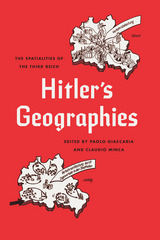 Hitler's Geographies: The Spatialities of the Third Reich
Edited by Paolo Giaccaria and Claudio Minca
University of Chicago Press, 2016 Lebensraum: the entitlement of “legitimate” Germans to living space. Entfernung: the expulsion of “undesirables” to create empty space for German resettlement. During his thirteen years leading Germany, Hitler developed and made use of a number of powerful geostrategical concepts such as these in order to justify his imperialist expansion, exploitation, and genocide. As his twisted manifestation of spatial theory grew in Nazi ideology, it created a new and violent relationship between people and space in Germany and beyond.
With Hitler’s Geographies, editors Paolo Giaccaria and Claudio Minca examine the variety of ways in which spatial theory evolved and was translated into real-world action under the Third Reich. They have gathered an outstanding collection by leading scholars, presenting key concepts and figures as well exploring the undeniable link between biopolitical power and spatial expansion and exclusion.
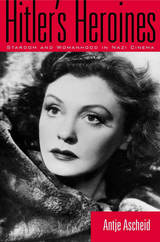 Hitler's Heroines: Stardom & Womanhood In Nazi Cinema
Antje Ascheid
Temple University Press, 2003 German film-goers flocked to see musicals and melodramas during the Nazi era. Although the Nazis seemed to require that every aspect of ordinary life advance the fascist project, even the most popular films depicted characters and desires that deviated from the politically correct ideal. Probing into the contradictory images of womanhood that surfaced in these films, Antje Ascheid shows how Nazi heroines negotiated the gender conflicts that confronted contemporary women.The careers of Kristina Soderbaum, Lilian Harvey, and Zarah Leander speak to the Nazis' need to address and contain the "woman question," to redirect female subjectivity and desires to self sacrifice for the common good (i.e., national socialism). Hollywood's new women and glamorous dames were out; the German wife and mother were in. The roles and star personas assigned to these actresses, though intended to entertain the public in a politically conformist way, point to the difficulty of yoking popular culture to ideology.
Hitler's Library
Ambrus Miskolczy
Central European University Press, 2003 The first book to present the so-called Hitler Library. It sheds new light on the readings of Hitler and on his techniques how to read a book. Hitler presented himself as an ideal reader of Schopenhauer, nevertheless his remarks destroy that image, particularly if we see how he read Ernst Jünger, Richard Wagner, or Paul de Lagarde, and how he reread Mein Kampf.The book describes the gnostic character of the phenomenon as an explication of the success of nazism and that of the Hitler myth and challenges the static views of traditional historiography.
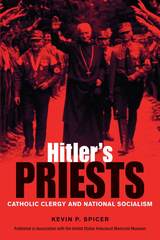 Hitler's Priests: Catholic Clergy and National Socialism
Kevin P. Spicer
Northern Illinois University Press, 2017
Shaken by military defeat and economic depression after War World I, Germans sought to restore their nation’s dignity and power. In this context the National Socialist Party, with its promise of a revivified Germany, drew supporters. Among the most zealous were a number of Catholic clergymen known as “brown priests” who volunteered as Nazi propagandists. In this insightful study, Spicer unearths a dark subchapter in Roman Catholic history, introduces the principal clergymen who participated in the Nazi movement, examines their motives, details their advocacy of National Socialism, and explores the consequences of their political activism.
Some brown priests, particularly war veterans, advocated National Socialism because it appealed to their patriotic ardor. Others had less laudatory motives: disaffection with clerical life, conflicts with Church superiors, or ambition for personal power and fame. Whatever their individual motives, they employed their skills as orators, writers, and teachers to proclaim the message of Nazism. Especially during the early 1930s, when the Church forbade membership in the party, these clergymen strove to prove that Catholicism was compatible with National Socialism, thereby justifying their support of Nazi ideology. Father Dr. Philipp Haeuser, a scholar and pastor, went so far as to promote antisemitism while deifying Adolf Hitler. The Führer’s antisemitism, Spicer argues, did not deter clergymen such as Haeuser because, although the Church officially rejected the Nazis’ extreme racism, Catholic teachings tolerated hostility toward Jews by blaming them for Christ’s crucifixion.
While a handful of brown priests enjoyed the forbearance of their bishops, others endured reprimand or even dismissal; a few found new vocations with the Third Reich. After the fall of the Reich, the most visible brown priests faced trial for their part in the crimes of National Socialism, a movement they had once so earnestly supported.
In addition to this intriguing history about clergymen trying to reconcile faith and politics, Spicer provides a master list—verified by extensive research in Church and government archives—of Catholic clergy who publicly supported National Socialism.
 Hitler’s Shadow Empire: Nazi Economics and the Spanish Civil War
Pierpaolo Barbieri
Harvard University Press, 2015 Pitting fascists and communists in a showdown for supremacy, the Spanish Civil War has long been seen as a grim dress rehearsal for World War II. Francisco Franco’s Nationalists prevailed with German and Italian military assistance—a clear instance, it seemed, of like-minded regimes joining forces in the fight against global Bolshevism. In Hitler’s Shadow Empire Pierpaolo Barbieri revises this standard account of Axis intervention in the Spanish Civil War, arguing that economic ambitions—not ideology—drove Hitler’s Iberian intervention. The Nazis hoped to establish an economic empire in Europe, and in Spain they tested the tactics intended for future subject territories.
“The Spanish Civil War is among the 20th-century military conflicts about which the most continues to be published…Hitler’s Shadow Empire is one of few recent studies offering fresh information, specifically describing German trade in the Franco-controlled zone. While it is typically assumed that Nazi Germany, like Stalinist Russia, became involved in the Spanish Civil War for ideological reasons, Pierpaolo Barbieri, an economic analyst, shows that the motives of the two main powers were quite different.
—Stephen Schwartz, Weekly Standard
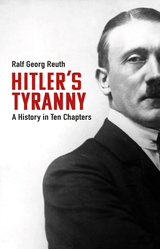 Hitler's Tyranny: A History in Ten Chapters
Ralf Georg Reuth
Haus Publishing, 2022 A fresh, stimulating look at Adolf Hitler and his dictatorship throughout the study of ten key aspects.
Hitler’s tyranny is still difficult to understand today. In this book, Ralf Georg Reuth examines ten aspects of this catastrophe. Among other things, he asks: Was anti-Semitism more pronounced in Germany than elsewhere? Was Versailles really responsible for Hitler’s rise and why did the Germans follow a racial fanatic like him? How did his war differ from all others before it? The disturbing answers provide an overall picture that shows Hitler was not the consequence of the depths of German history, but the result of chance, deception, and seduction.
This thought-provoking new study takes aim at several of the norms of Hitler scholarship from the past forty years. Reuth interrogates and challenges a range of orthodox views on such topics as how mainstream politicians facilitated Hitler’s rise to power, the Führer’s infamous pact with Stalin, and the complicity of ordinary Germans in his genocidal tyranny. Eschewing a conventional chronological approach in favor of a forensic analysis of Hitler’s mainsprings of action both as chancellor and military commander, Reuth portrays Hitler as the apotheosis of what he argues is a specifically German strain of militarism and imperialism, shifting the focus firmly back to the mindset and modus operandi of Hitler himself. The portrait that emerges is one of a murderous fantasist and political opportunist driven by an all-embracing ideology of racial superiority. Reuth’s account courts controversy on a number of points and offers a fascinating counterpoint to much recent scholarship.
Hitler’s World View: A Blueprint for Power
Eberhard Jäckel
Harvard University Press Even the demonic Hitler had a comprehensive philosophy, and Eberhard Jäckel probes deeply into the dictator’s mind to determine how he viewed the world.
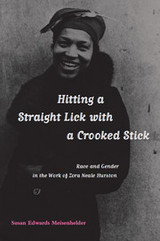 Hitting A Straight Lick with a Crooked Stick: Race and Gender in the Work of Zora Neale Hurston
Susan E Meisenhelder
University of Alabama Press, 2001 Hitting a Straight Lick with a Crooked Stick examines the ways Zora Neale Hurston circumvented the constraints of the white publishing world and a predominantly white readership to critique white culture and its effects on the black community. A number of critics have concluded that Hurston simply capitulated to external demands, writing stories white people wanted to hear. Susan Edwards Meisenhelder, however, argues that Hurston’s response to her situation is much more sophisticated than her detractors recognized. Meisenhelder suggests, in fact, that Hurston’s work, both fictional and anthropological, constitutes an extended critique of the values of white culture and a rejection of white models for black people. Repeatedly, Hurston’s work shows the diverse effects that traditional white values, including class divisions and gender imbalances, have on blacks.
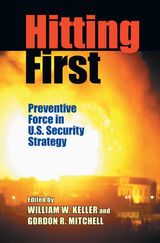 Hitting First: Preventive Force in U.S. Security Strategy
William W. Keller
University of Pittsburgh Press, 2006
The U.S. war in Iraq was not only an intelligence failure—it was a failure in democratic discourse. Hitting First offers a critical analysis of the political dialogue leading up to the American embrace of preventive war as national policy and as the rationale for the invasion and occupation of Iraq. Taking as its point of departure the important distinction between preemptive and preventive war, the contributors examine how the rhetoric of policy makers conflated these two very different concepts until the public could no longer effectively distinguish between a war of necessity and a war of choice.
Although the book focuses on recent events, Hitting First takes into consideration the broader historical, ethical, and legal context of current American policies. Precedents are examined for preventive military action based on conventional as well as nuclear, biological, and chemical weapons threats. The authors also consider recent examples of the rhetoric of “humanitarian intervention,” which have tended to undermine traditional notions of national sovereignty, making purportedly “morally justifiable” actions easier to entertain. Intelligence gathering and its use, manipulation, and distortion to suit policy agendas are also analyzed, as are the realities of the application of military force, military requirements to sustain a policy of preventive war, and post-conflict reconstruction.
Hitting First presents a timely and essential view of the lessons learned from the failures of the Iraqi conflict, and offers a framework for avoiding future policy breakdowns through a process of deliberative public and governmental debate within a free market of ideas. The critiques and prescriptions offered here provide a unique and valuable perspective on the challenges of formulating and conduct of national security policy while sustaining the principles and institutions of American democracy. This collection will appeal to students and scholars of American foreign policy, international relations, political communication, and ethics.
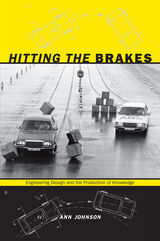 Hitting the Brakes: Engineering Design and the Production of Knowledge
Ann Johnson
Duke University Press, 2009 In Hitting the Brakes, Ann Johnson illuminates the complex social, historical, and cultural dynamics of engineering design, in which knowledge communities come together to produce new products and knowledge. Using the development of antilock braking systems for passenger cars as a case study, Johnson shows that the path to invention is neither linear nor top-down, but highly complicated and unpredictable. Individuals, corporations, university research centers, and government organizations informally coalesce around a design problem that is continually refined and redefined as paths of development are proposed and discarded, participants come and go, and information circulates within the knowledge community. Detours, dead ends, and failures feed back into the developmental process, so that the end design represents the convergence of multiple, diverse streams of knowledge. The development of antilock braking systems (ABS) provides an ideal case study for examining the process of engineering design because it presented an array of common difficulties faced by engineers in research and development. ABS did not develop predictably. Research and development took place in both the public and private sectors and involved individuals working in different disciplines, languages, institutions, and corporations. Johnson traces ABS development from its first patents in the 1930s to the successful 1978 market introduction of integrated ABS by Daimler and Bosch. She examines how a knowledge community first formed around understanding the phenomenon of skidding, before it turned its attention to building instruments to measure, model, and prevent cars’ wheels from locking up. While corporations’ accounts of ABS development often present a simple linear story, Hitting the Brakes describes the full social and cognitive complexity and context of engineering design.
 Hittite Diplomatic Texts
Gary M. Beckman
SBL Press, 1999 This work presents full translations of more than 50 documents from the files of the "foreign office" of the Hittite Empire: 21 treaties, 18 diplomatic letters, and 18 royal edicts and miscellaneous records concerning the relations of the Hittites with their Anatolian and Syrian vassals, as well as with other great powers such as Egypt, Assyria, and Babylonia. Originally composed in Hittite or in the Akkadian lingua franca of the day, many of these texts have never before appeared in English. A short introduction places each document in its historical and cultural context, and a general essay acquaints the reader with the diplomatic practice of the Late Bronze Age. This collection of documents is a major source book for historians of the Ancient Near East and for students of cuneiform and Biblical law. It will also prove useful for those investigating the relationship between Biblical covenant theology and its possible antecedents in older Near Eastern treaty patterns.
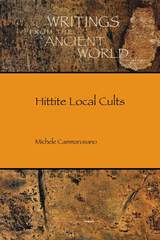 Hittite Local Cults
Michele Cammarosano
SBL Press, 2018 An innovative translation and analysis of Hittite local festivals and of their economic and social dimensions for students and scholars
This English translation of the Hittite cult inventories provides a vivid portrait of the religion, economy, and administration of Bronze Age provincial towns and villages of the Hittite Empire. These texts report the state of local shrines and festivals and document the interplay between the central power and provincial communities on religious affairs. Brief introductions to each text make the volume accessible to students and scholars alike.
Features: -
Critical editions of Hittite cult inventories, some of which are edited for the first time, with substantial improvements in readings and interpretations
- The first systematic study of the linguistic aspects of Hittite administrative jargon
- An up-to-date study of Hittite cult images and iconography of the gods
Michele Cammarosano currently leads a Deutsche Forschungsgemeinschaft-funded project on Hittite cultic administration at Julius-Maximilians-Universität Würzburg. His research interests focus on cuneiform palaeography and Hittite religion.
Hittite Myths, Second Edition
Harry A. Hoffner
SBL Press, 1998 This work contains the first English translations of a collection of Hittite myths. The translations are based on the original tablets on which the myths were written and take into account recent textual discoveries and published studies on the texts. Revised and corrected, this second edition includes an additional newly published Hurrian myth. In addition to translations, the volume includes a series of brief introductions to the myths, a glossary of names and technical terms, and indexes of proper names and topics/subjects. Accessible to nonspecialists, the translations also preserve column and line count for the convenience of scholars.
The Hittites and Their World
Billie Jean Collins
SBL Press, 2007 Lost to history for millennia, the Hittites have regained their position among the great civilizations of the Late Bronze Age Near East, thanks to a century of archaeological discovery and philological investigation. The Hittites and Their World provides a concise, current, and engaging introduction to the history, society, and religion of this Anatolian empire, taking the reader from its beginnings in the period of the Assyrian Colonies in the nineteenth century B.C.E. to the eclipse of the Neo-Hittite cities at the end of the eighth century B.C.E. The numerous analogues with the biblical world featured throughout the volume together represent a comprehensive and up-to-date survey of the varied and significant contributions of Hittite studies to biblical interpretation.
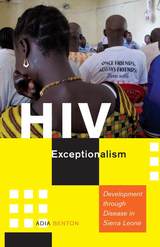 HIV Exceptionalism: Development through Disease in Sierra Leone
Adia Benton
University of Minnesota Press, 2015 WINNER, 2017 RACHEL CARSON PRIZE, SOCIETY FOR THE SOCIAL STUDIES OF SCIENCE
In 2002, Sierra Leone emerged from a decadelong civil war. Seeking international attention and development aid, its government faced a dilemma. Though devastated by conflict, Sierra Leone had a low prevalence of HIV. However, like most African countries, it stood to benefit from a large influx of foreign funds specifically targeted at HIV/AIDS prevention and care. What Adia Benton chronicles in this ethnographically rich and often moving book is how one war-ravaged nation reoriented itself as a country suffering from HIV at the expense of other, more pressing health concerns. During her fieldwork in the capital, Freetown, a city of one million people, at least thirty NGOs administered internationally funded programs that included HIV/AIDS prevention and care. Benton probes why HIV exceptionalism—the idea that HIV is an exceptional disease requiring an exceptional response—continues to guide approaches to the epidemic worldwide and especially in Africa, even in low-prevalence settings. In the fourth decade since the emergence of HIV/AIDS, many today are questioning whether the effort and money spent on this health crisis has in fact helped or exacerbated the problem. HIV Exceptionalism does this and more, asking, what are the unanticipated consequences that HIV/AIDS development programs engender?
Hive
Christina Stoddard
University of Wisconsin Press, 2015 Hive is a remarkable debut collection of poems about brutality, exaltation, rebellion, and allegiance. Written in the voice of a teenage Mormon girl, these poems chronicle an inheritance of daily violence and closely guarded secrets. A conflicting cast of recurring characters—best friends, sisters, serial killers, and the ominous Elders—move through these poems as the speaker begins to struggle with the widening gulf between her impulse toward faith and her growing doubts about the people who claim to know God’s will. Ultimately she must confront what it means to believe and what it costs to save ourselves.
Winner, Poetry, Association for Mormon Letters Awards
Finalist, da Vinci Eye Book Design Award
Finalist, Washington State Book Award for Poetry, Washington Center for the Book
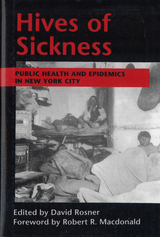 Hives of Sickness: Public Health and Epidemics in New York City
Rosner, David
Rutgers University Press, 1995 An 1865 report on public health in New York painted a grim picture of "high brick blocks and closely-packed houses . . . literally hives of sickness" propagating epidemics of cholera, smallpox, typhoid, typhus, and yellow fever, which swept through the whole city. In this stimulating collection of essays, nine historians of American medicine explore New York's responses to its public health crises from colonial times to the present. The essays illustrate the relationship between the disease environment of New York and changes in housing, population, social conditions, and the success of medical science, linking such factors to New York's experiences with smallpox, polio, and AIDS.
The volume is essential reading for anyone interested in American public health and the social history of New York.
The contributors are Ronald Bayer, Elizabeth Blackmar, Gretchen A. Condran, Elizabeth Fee, Daniel M. Fox, Evelynn M. Hammonds, Alan M. Kraut, Judith Walzer Leavitt, and Naomi Rogers. David Rosner is a professor of history at Baruch College and The Graduate School of the City University of New York. Robert R. Macdonald is the director of the Museum of the City of New York.
A publication of the Museum of the City of New York
Choice Reviews 1995 November
This is one of a series of books focusing on the impact of disease intended to enhance the understanding of both past and present regarding reactions to periodic epidemics. Robert B. Macdonald, director of the Museum of the City of New York, which supports this series, states: "The individual and collective responses to widespread sickness are mirrors to the cultural, religious, economic, political, and social histories of cities and nations." Rosner selected eight renowned and respected individuals to describe the reactions and responses to smallpox, polio, and AIDS epidemics in New York City since 1860, and the efforts of officials and professionals to deal with the impact of disease. Essayists present disease broadly from economic, social, political, and health perspectives. Causes of epidemics include the expected and usual: thousands of immigrants pouring into the city, inadequate water and food supplies, lack of sewage disposal, unemployment leading to poverty. An unexpected cause was the avarice of real estate investors, inexorably driving up housing costs. Highly recommended for all students of history, public health, health policy, and sociology. Upper-division undergraduate through professional. Copyright 1999 American Library Association
 Hizbu'llah: Politics and Religion
Amal Saad-Ghorayeb
Pluto Press, 2001 Hizbu’llah is the largest and most prominent political party in Lebanon, and one of the most renowned Islamist movements in the world. In this book, Amal Saad-Ghorayeb examines the organisation’s understanding of jihad and how this, together with its belief in martyrdom, brought about the withdrawal of Israeli occupation forces from Lebanon in May 2000.
Saad-Ghorayeb explores the nature of the party’s struggle against the West by studying its views on the use of violence against Westerners. Crucially, she also addresses the question of whether Hizbu’llah depicts this struggle in purely political or civilisational terms. The existential nature of the movement’s conflict with Israel is analysed and the Islamic roots of its anti-Judaism is unearthed.
The author explores the mechanics and rationale behind the party’s integration into the Lebanese political system, and sheds light on how it has reconciled its national idenitity with its solidarity with the Muslim umma.
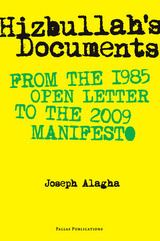 Hizbullah's Documents: From the 1985 Open Letter to the 2009 Manifesto
Joseph Alagha
Amsterdam University Press, 2011 Despite the controversial reputation of Hizbullah in the West, and the significant role this powerful Islamist organization plays in Lebanese politics, there are few reliable, published English translations of the party’s primary documents. With this extensive work, Joseph Alagha seeks to remedy this problem and rectify the distortions and misrepresentations that have resulted from inaccurate translations.
Through privileged access to the party, Alagha was able to compile and meticulously translate a host of original primary documents, from the party’s 1985 Open Letter; through its eight clandestine conclaves from 1989 to 2009; to all of its election programs from 1992 to 2010, as well as all of the agreements, understandings, and pacts the party has ratified over the years; ending with the 2009 Political Manifesto. This firsthand portrait of Hizbullah’s metamorphosis, especially in the past decade, is complete with thorough footnotes, commentary, background information, chronology, and a detailed introductory chapter that maps the party’s transformation by analytically comparing the Open Letter with the 2009 Manifesto. This volume will be an invaluable companion for both scholars and policy makers.
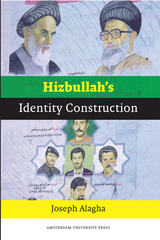 Hizbullah's Identity Construction
Joseph Alagha
Amsterdam University Press, 2011 As the dominant political force in Lebanon and one of the most powerful post-Islamist organizations in the world, Hizbullah is a source of great controversy and uncertainty in the West. Despite the significant attention paid to this group by the media, the details of Hizbullah’s evolution have frequently confounded politicians—and even scholars. In this important study, Joseph Alagha, a scholar with unprecedented access to the organization, exhaustively and objectively analyzes Hizbullah’s historical evolution and offers a revolutionary new perspective on the political phenomenon of the organization.
Hizbullah’s Identity Construction is a timely examination of one of the world’s most turbulent regions; a major contribution to the study of contemporary Islamic political movements in the Middle East; and a refreshing departure from the bland hagiographies and ad hominem attacks that are all too common in studies of Hizbullah’s murky history. Superbly documented and argued, and rooted in broad knowledge of contemporary Islamist political thought, this study brings much-needed clarity to a hot-button subject.
“Joseph Alagha remains one of the most thorough and careful analysts of Hizbullah’s political ideology and practice. Scholars, analysts, and policy makers will find in this work a veritable treasure trove of research and insights into this complex organization.”—Michaelle Browers, Wake Forest University
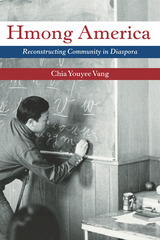 Hmong America: Reconstructing Community in Diaspora
Chia Youyee Vang
University of Illinois Press, 2010 The first scholarly work to come from inside the Hmong community, Hmong America documents Chia Youyee Vang's own migration from Laos to Minnesota at age nine and the transformations she has witnessed in Hmong communities throughout the migration and settlement processes. Vang depicts Hmong experiences in Asia and examines aspects of community building in America to reveal how new Hmong identities have been formed and how they have challenged popular assumptions about race and ethnicity in multicultural America. Combining participant observation and archival research with personal experience, Vang constructs a nuanced and complex portrait of the more than 130,000 Hmong people who came to the United States as political refugees beginning in the mid-1970s. Her critique of previous representations of the Hmong community provides the sociological underpinnings for a bold reassessment of Hmong history in the greater context of globalization. This new understanding redefines concepts of Hmong homogeneity and characterizes ordinary Hmong migrants not as passive victims but as dynamic actors who have exercised much power over their political and social destinies.
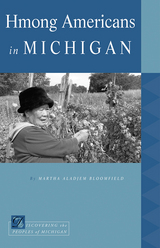 Hmong Americans in Michigan
Martha Aladjem Bloomfield
Michigan State University Press, 2014 The Hmong people, originating from the mountainous regions of China, Vietnam, Thailand, and Laos, are unique among American immigrants because of their extraordinary history of migration; loyalty to one another; prolonged abuse, trauma, and suffering at the hands of those who dominated them; profound loss; and independence, as well as their amazing capacity to adapt and remain resilient over centuries. This introduction to their experience in Michigan discusses Hmong American history, culture, and more specifically how they left homelands filled with brutality and warfare to come to the United States since the mid-1970s. More than five thousand Hmong Americans live in Michigan, and many of them have faced numerous challenges as they have settled in the Midwest. How did these brave and innovative people adapt to strange new lives thousands of miles away from their homelands? How have they preserved their past through time and place, advanced their goals, and cultivated plans for their children and education? What are their lives like in the diaspora? As this book documents via personal interviews and extensive research, despite the tremendous losses they have suffered for many years, the Hmong people in Michigan continue to demonstrate courage and profound resilience.
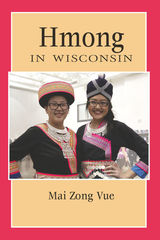 Hmong in Wisconsin
Mai Zong Vue
Wisconsin Historical Society Press, 2020 Unknown to many Americans at the time, the Hmong helped the US government fight Communists in Laos during the Secret War of the 1960s and 1970s, a parallel conflict to the Vietnam War. When Saigon fell and allies withdrew, the surviving Hmong fled for their lives, spending years in Thai refugee camps before being relocated to the United States and other countries.
Many of these families found homes in Wisconsin, which now has the third largest Hmong population in the country, following California and Minnesota. As one of the most recent cultural groups to arrive in the Badger State, the Hmong have worked hard to establish a new life here, building support systems to preserve traditions and to help one another as they enrolled in schools, started businesses, and strived for independence.
Told with a mixture of scholarly research, interviews, and personal experience of the author, this latest addition to the popular People of Wisconsin series shares the Hmong’s varied stories of survival and hope as they have become an important part of Wisconsin communities.
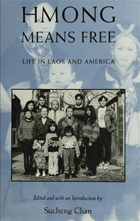 Hmong Means Free: Life in Laos and America
Sucheng Chan
Temple University Press, 1994 This collection of evocative personal testimonies by three generations of Hmong refugees is the first to describe their lives in Laos as slash-and-burn farmers, as refugees after a Communist government came to power in 1975, and as immigrants in the United States. Reflecting on the homes left behind, their narratives chronicle the difficulties of forging a new identity. From Jou Yee Xiong's Life Story:
"I stopped teaching my sons many of the Hmong ways because I felt my ancestors and I had suffered enough already. I thought that teaching my children the old ways would only place a burden on them." From Ka Pao Xiong's (Jou Yee Xiong's son) Life Story:
"It has been very difficult for us to adapt because we had no professions or trades and we suffered from culture shock. Here in America, both the husband and wife must work simultaneously to earn enough money to live on. Many of our children are ignorant of the Hmong way of life…. Even the old people are forgetting about their life in Laos, as they enjoy the prosperity and good life in America." From Xang Mao Xiong's Life Story:
"When the Communists took over Laos and General Vang Pao fled with his family, we, too, decided to leave. Not only my family, but thousands of Hmong tried to flee. I rented a car for thirty thousand Laotian dollars, and it took us to Nasu…. We felt compelled to leave because many of us had been connected to the CIA…. Thousands of Hmong were traveling on foot. Along the way, many of them were shot and killed by Communist soldiers. We witnessed a bloody massacre of civilians." From Vue Vang's Life Story:
"Life was so hard in the [Thai refugee] camp that when we found out we could go to the United States, we did not hesitate to grasp the chance. We knew that were we to remain in the camp, there would be no hope for a better future. We would not be able to offer our children anything better than a life of perpetual poverty and anguish."
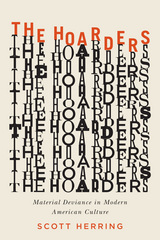 The Hoarders: Material Deviance in Modern American Culture
Scott Herring
University of Chicago Press, 2014 The verb “declutter” has not yet made it into the Oxford English Dictionary, but its ever-increasing usage suggests that it’s only a matter of time. Articles containing tips and tricks on how to get organized cover magazine pages and pop up in TV programs and commercials, while clutter professionals and specialists referred to as “clutterologists” are just a phone call away. Everywhere the sentiment is the same: clutter is bad.
In The Hoarders, Scott Herring provides an in-depth examination of how modern hoarders came into being, from their onset in the late 1930s to the present day. He finds that both the idea of organization and the role of the clutterologist are deeply ingrained in our culture, and that there is a fine line between clutter and deviance in America. Herring introduces us to Jill, whose countertops are piled high with decaying food and whose cabinets are overrun with purchases, while the fly strips hanging from her ceiling are arguably more fly than strip. When Jill spots a decomposing pumpkin about to be jettisoned, she stops, seeing in the rotting, squalid vegetable a special treasure. “I’ve never seen one quite like this before,” she says, and looks to see if any seeds remain. It is from moments like these that Herring builds his questions: What counts as an acceptable material life—and who decides? Is hoarding some sort of inherent deviation of the mind, or a recent historical phenomenon grounded in changing material cultures? Herring opts for the latter, explaining that hoarders attract attention not because they are mentally ill but because they challenge normal modes of material relations. Piled high with detailed and, at times, disturbing descriptions of uncleanliness, The Hoarders delivers a sweeping and fascinating history of hoarding that will cause us all to reconsider how we view these accumulators of clutter.
 Hoaxes and Other Stories
Brian DiNuzzo
University of Wisconsin Press, 2022 A small-time celebrity keeps dying. A Bigfoot hunter and his grandson give presentations on the elusive beast. A disgruntled office drone reaches his breaking point and quits, in the middle of a zip-line trust fall.
The characters populating Brian DiNuzzo’s debut short story collection may be eccentrics, but at their core they are struggling to get through life, dealing with unmanageable bosses and tedious jobs, and trying to maintain their interpersonal and romantic relationships. These are people seeking to improve their circumstances, people striving for utopia but willing to accept much less. Frustrated and weary, downtrodden and misguided, they still hold out for the dim light of hope.
DiNuzzo navigates ordinary settings—Southern California, South Philadelphia, suburban and city streets, office buildings, derelict apartment complexes, the public library, the airport, the shopping mall—with quirky characters and odd situations. These stories ask us to wonder how falsehoods pervade private life. Through his twelve distinct tales, DiNuzzo asks: What’s real? What’s fake? Does it matter?
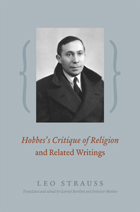 Hobbes's Critique of Religion and Related Writings
Leo Strauss
University of Chicago Press, 2011 Leo Strauss’s The Political Philosophy of Hobbes deservedly ranks among his most widely acclaimed works. In it Strauss argues that the basis for Hobbes’s natural and political science is his interest in “self-knowledge of man as he really is.” The writings collected in this book, each written prior to that classic volume, complement that account. Thus at long last, this book allows us to have a complete picture of Strauss’s interpretation of Hobbes, the thinker pivotal to the fundamental theme of his life’s work: the conflicting demands of philosophy and revelation, or as he termed it, “the theologico-political problem.”
It is no exaggeration to say that Strauss’s work on Hobbes’s critique of religion is essential to his analysis of Hobbes’s political philosophy, and vice versa. This volume will spark new interest in Hobbes’s explication of the Bible and in his understanding of religion by revealing previously neglected dimensions and motives of Hobbes’s “theology.” At the same time, scholars interested in the intellectual development of Leo Strauss will find in these writings the missing link, as it were, between his two early books,Spinoza’s Critique of Religion and The Political Philosophy of Hobbes.
In addition, this volume makes available for the first time in English a letter, a book outline, an extended review, an engagement with legal positivism, and an account of Strauss’s work on Hobbes by Heinrich Meier, all of which shed light on Strauss’s concerns and his approach to Hobbes in particular, as well as to modern political thought and life.
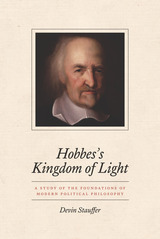 Hobbes's Kingdom of Light: A Study of the Foundations of Modern Political Philosophy
Devin Stauffer
University of Chicago Press, 2018 Was Hobbes the first great architect of modern political philosophy? Highly critical of the classical tradition in philosophy, particularly Aristotle, Hobbes thought that he had established a new science of morality and politics. Devin Stauffer here delves into Hobbes’s critique of the classical tradition, making this oft-neglected aspect of the philosopher’s thought the basis of a new, comprehensive interpretation of his political philosophy.
In Hobbes’s Kingdom of Light, Stauffer argues that Hobbes was engaged in a struggle on multiple fronts against forces, both philosophic and religious, that he thought had long distorted philosophy and destroyed the prospects of a lasting peace in politics. By exploring the twists and turns of Hobbes’s arguments, not only in his famous Leviathan but throughout his corpus, Stauffer uncovers the details of Hobbes’s critique of an older outlook, rooted in classical philosophy and Christian theology, and reveals the complexity of Hobbes’s war against the “Kingdom of Darkness.” He also describes the key features of the new outlook—the “Kingdom of Light”—that Hobbes sought to put in its place. Hobbes’s venture helped to prepare the way for the later emergence of modern liberalism and modern secularism. Hobbes’s Kingdom of Light is a wide-ranging and ambitious exploration of Hobbes’s thought.
Hobomok and Other Writings on Indians
Karcher, Carolyn L
Rutgers University Press, 1986 Hobomok, A Tale of Early Times is the provocative story of an upperclass white woman who marries an Indian chief, has a child, then leaves him--with the child--for another man. This novel, originally published in 1824, is a powerful first among antipatriarchal and antiracist novels in American literature. In addition, this collection contains seven remarkable short stories; an extract on Indian women from Child's groundbreaking History of the Condition of Women in Various Ages and Nations (1835); a selection from her best-selling volume of journalistic sketches, Letters from New-York (1843); and her eloquent Appeal for Indians (1868). This revised edition of "Hobomok" and Other Writings on Indians includes three new stories: "The Church in the Wilderness," "Willie Wharton," and "The Indians"--as well as explanatory notes and an updated bibliography.
 Hobsbawm: History and Politics
Gregory Elliott
Pluto Press, 2010 Historian Eric Hobsbawm is possibly the foremost chronicler of the modern age. His panoramic studies of the nineteenth and twentieth centuries, stretching from the French Revolution to the fall of Soviet communism, have informed the historical consciousness of scholars and general readers alike. At the same time, his writings on labour movements and socialist politics have occupied a central place in left-wing debates. Despite this, no extended study of Hobsbawm's work has yet been attempted Gregory Elliott fills this gap in exemplary fashion.
Elliott analyses both the scholarly record of Hobsbawm and the intellectual and political journey that his life represents. In doing so, he seeks to situate Hobsbawm's thought within the context of a generalised crisis of confidence on the Left after the fall of the Berlin Wall.
Rich in content and written in Elliott's authoritative and highly readable style, this book is a must for anyone with an interest in Hobsbawm and the crisis of the Left.
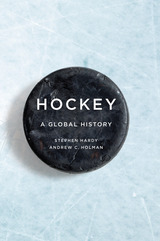 Hockey: A Global History
Stephen H. Hardy, Andrew C. Holman
University of Illinois Press, 2018 Long considered Canadian, ice hockey is in truth a worldwide phenomenon--and has been for centuries. In Hockey: A Global History, Stephen Hardy and Andrew C. Holman draw on twenty-five years of research to present THE monumental end-to-end history of the sport. Here is the story of on-ice stars and organizational visionaries, venues and classic games, the evolution of rules and advances in equipment, and the ascendance of corporations and instances of bureaucratic chicanery. Hardy and Holman chart modern hockey's "birthing" in Montreal and follow its migration from Canada south to the United States and east to Europe. The story then shifts from the sport's emergence as a nationalist battlefront to the movement of talent across international borders to the game of today, where men and women at all levels of play lace 'em up on the shinny ponds of Saskatchewan, the wide ice of the Olympics, and across the breadth of Asia. Sweeping in scope and vivid with detail, Hockey: A Global History is the saga of how the coolest game changed the world--and vice versa.
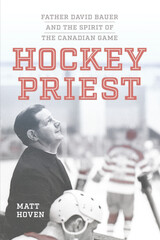 Hockey Priest: Father David Bauer and the Spirit of the Canadian Game
Matt Hoven
Catholic University of America Press, 2024 Born in Waterloo, Ontario, in 1924, to a prominent family, David Bauer attended St. Michael’s College-School run by the Basilian Fathers of Toronto. After serving in World War II, Bauer joined the religious community and coached its St. Michael’s Majors to a national championship in 1961. Influenced by philosophers like Jacques Maritain, Bauer tried to find solutions to problems created within elite hockey and thus founded Canada’s first ever National Team program. This team countered the cutthroat ideals of hockey’s powerbrokers and set out to return Canada to international glory. The team represented the nation at several global tournaments and three Winter Olympic Games. Bauer was posthumously inducted into the Hockey Hall of Fame in 1989.
Hockey Priest looks past simply understanding Bauer as a do-gooder or hockey innovator. It shows how he attempted to create a different stream of hockey that could better support youth and so build up the nation. Archival research for the book uncovered Bauer-written hockey reports, speeches, and notes that detail his thinking about the game and his politicking to bring about change in it. Interviews with dozens of associates and family members told the story of his bold efforts to take on the National Hockey League. Despite his work being undermined by some supporters of the corporate game, Bauer offered a vision for Canada’s sport that remains an important counterpoint in the sport’s history and its ongoing challenges.
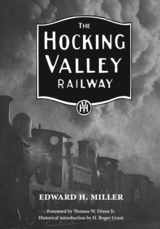 The Hocking Valley Railway
Edward H. Miller
Ohio University Press, 2024 The Hocking Valley Railway was once Ohio’s longest intrastate rail line, filled with a seemingly endless string of coal trains. Although coal was the main business, the railroad also carried iron and salt. Despite the fact that the Hocking Valley was such a large railroad, with a huge economic and social impact, very little is known about it. The Hocking Valley Railway traces the journey of a company that began in 1867 as the Columbus & Hocking Valley, built to haul coal from Athens to Columbus. Extensions of the line and consolidation of several branches ultimately created the Columbus, Hocking Valley & Toledo. This was a 345-mile railway, extending from the Lake Erie port of Toledo through Columbus and on to the Ohio River port of Pomeroy. The history of the Hocking Valley, like that of other railroads, is one of boom times and depression. By the 1920s, the Hocking coalfields were largely depleted, and the mass of track south of Columbus became a backwater, while the Toledo Division boomed. The corporate name has been gone for more than three-quarters of a century, but the Hocking Valley lives on as an integral part of railroad successor CSX. The Hocking Valley Railway, complete with 150 photographs and illustrations, also documents a historic transformation in midwestern transportation from slow canalboats to fast passenger trains. Historians and railroad enthusiasts will find much to savor in the story of this ever-changing company and the managers who ran it.
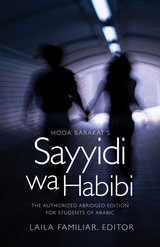 Hoda Barakat's Sayyidi wa Habibi: The Authorized Abridged Edition for Students of Arabic, Abridged Edition
Laila Familiar, Editor. Hoda Barakat
Georgetown University Press, 2013 Sayyidi wa Habibi (My Master and My Love) is a novel by acclaimed Lebanese author Hoda Barakat, abridged in the original Arabic in this volume for learners of Arabic at the advanced low proficiency level. Designed as a supplementary text that adds variety and fun to a regular course on Arabic, it is complete with exercises that guide learners through the story and help them improve their Arabic skills, introducing learners of the language to the world of contemporary Arabic literature and improving their knowledge of Arabic culture. Set against the backdrop of the Lebanese Civil War, this intriguing novel relates the struggles of Wadie, a young man who leaves school and becomes corrupted by crime, and his wife, Samia, who flees with him to Cyprus. Universal questions of existence are masterfully portrayed through eloquent prose that keeps readers engaged until the last line. Laila Familiar provides introductory materials, a short biography of the author, and exercises that develop linguistic and cultural competencies. Audio files of Barakat reading five passages from the work, along with a recorded interview, are available free on the press website in order to help students improve their listening skills. This authorized version of the abridged text of Sayyidi wa Habibi will be warmly embraced by college and university students of Arabic as well as by independent learners.
The Hodayot (Thanksgiving Psalms): A Study Edition of 1QHa
Eileen M. Schuller
SBL Press, 2012 1QHodayota is recognized as one of the most important of the Dead Sea Scrolls and key to understanding the specific worldview and piety of the Qumran community. It contains a collection of psalms giving thanks for deliverance, salvation, knowledge, and divine mercy. This volume contains the text of the reconstructed scroll of 1QHodayota published in Discoveries in the Judaean Desert volume 40 and the English translation from that volume, lightly revised. It provides the most up-to-date, accessible, and inexpensive access to the text, translation, and official numbering of the columns and lines of 1QHa.
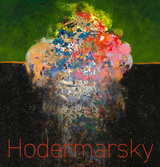 Hodermarsky
Duncan Christy
The Artist Book Foundation, 2024 Daniel Hodermarsky (1924–1999) was the son of Slovak immigrants who emigrated from Hačava to settle and work in the coal fields of Pennsylvania and later in the auto-manufacturing industries of Ohio. He served in World War II on the Western front and was awarded two presidential citations, two Croix de Guerre, and one combat star. He returned home with severe and persistent posttraumatic stress disorder that left an indelible mark on his life and art.
Hodermarsky had a distinguished teaching career at the Cleveland Institute of Art from 1957 to 1969. Throughout the 1960s, he taught in Cleveland's public schools and started an art program for inner-city youth under the Federal Title 3 Act to promote integration through arts education. From 1969 to 1989 he taught at Deerfield Academy in western Massachusetts, founding its art department and serving for several years as department chair and director of the school's Hilson Gallery (now the von Auersperg Gallery). He mentored notable artists, including Stephen Hannock and Michael Tracy.
Throughout his career, Hodermarsky's work embraced both the representational and the abstract. His early works experimented with new media (such as Dayglo paint) and new styles such as Op Art and performance. In the 1970s and beyond, he engaged landscape—rural, urban, and imaginary—wherein he explored the interplay of terrain (land or water, horizon, and sky). The human figure—Slovak farmers, wounded or dismembered soldiers, and mythical and historical figures—were among his favorite subjects. He was fascinated by how age, human nature, and personality combine to create the physical form. His eclectic themes mirror his own unique complexities and experiences. Later in his career, he focused on abstract works that reflect the intricate spaces of both his psyche and shared human experience.
A deeply spiritual man with a strong religious faith, Hodermarsky's abstract paintings ask the existential questions that have challenged humankind across millennia. By showing us his own experience of these great mysteries, his art underscores life's abiding beauty. Over his long career of interpreting the world in which he lived, Hodermarsky invites us to inhabit a realm filled with joy, reverence, and passion.
The Hodges Ruin: A Hohokam Community in the Tucson Basin
Isabel Kelly, James E. Officer, and Emil W. Haury
University of Arizona Press, 1977 The Anthropological Papers of the University of Arizona is a peer-reviewed monograph series sponsored by the School of Anthropology. Established in 1959, the series publishes archaeological and ethnographic papers that use contemporary method and theory to investigate problems of anthropological importance in the southwestern United States, Mexico, and related areas.
Hodgkin's Disease: Second Edition
Henry S. Kaplan
Harvard University Press, 1980 Dr. Kaplan, winner of $100,000 Kettering Prize for cancer research, has now updated and enlarged his authoritative reference, once again drawing heavily upon the uniquely comprehensive and coherent Stanford data garnered over a twenty-year period. This edition incorporates discussion of the newer radionuclides, computed tomography and ultrasound, as well as such recent developments as the transmissibility controversy.
Major sections have been added on cell culture, surface marker characterization, and cytogenetics. The material on cell-mediated immunity has been doubled, and an entirely new chapter has been included on chemotherapy, offering an analysis of evidence bearing on the selection of optimal treatment.
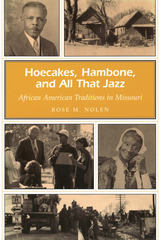 Hoecakes, Hambone, and All That Jazz: African American Traditions in Missouri
Rose M. Nolen
University of Missouri Press, 2003 Many African Americans in Missouri are the descendants of slaves brought by the French or the Spanish to the Louisiana Territory in the 1700s or by Americans who moved from slave states after the Louisiana Purchase in the 1800s. In Hoecakes, Hambone, and All That Jazz, Rose M. Nolen explores the ways in which those Missouri “immigrants with a difference”—along with other Africans brought to America against their will—developed cultural, musical, and religious traditions that allowed them to retain customs from their past while adapting to the circumstances of the present.
Nolen writes, “Instead of the bond of common ancestors and a common language, which families had shared in Africa, the enslaved in the United States were bound together by skin color, hair texture, and condition of bondage. Out of this experience a strong sense of community was born.” Nolen traces the cultural traditions shaped by African Americans in Missouri from the early colonial period through the Civil War and Reconstruction and shows how those traditions were reshaped through the struggles of the civil rights movement and integration. Nolen demonstrates how the strong sense of community built on these traditions has sustained African Americans throughout their history.
Nolen focuses on some of the extraordinary Missourians produced by that community, among them William Wells Brown, “the first black man born in America to write plays, a novel, and accounts of his travels in Europe, as well as a ‘slave narrative’”; John Berry Meachum, a former slave who founded a “floating school,” anchored in the Mississippi River and thus exempt from state law, where blacks could be educated; J. W. “Blind” Boone, the celebrated composer and concert pianist; Elizabeth Keckley, who purchased her freedom, started her own business, and became dress designer and confidante to Mary Todd Lincoln; and Lucinda Lewis Haskell, daughter of a former slave, who helped establish the St. Louis Colored Orphan’s Home.
Hoecakes, Hambone, and All That Jazz recalls the many advances African Americans have made throughout Missouri’s history and uses the accomplishments of individuals to demonstrate the considerable contribution of African American culture to Missouri and all of the United States.
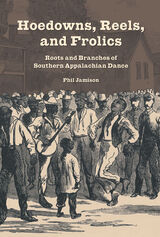 Hoedowns, Reels, and Frolics: Roots and Branches of Southern Appalachian Dance
Phil Jamison
University of Illinois Press, 2015 In Hoedowns, Reels, and Frolics, old-time musician and flatfoot dancer Philip Jamison journeys into the past and surveys the present to tell the story behind the square dances, step dances, reels, and other forms of dance practiced in southern Appalachia.
These distinctive folk dances, Jamison argues, are not the unaltered jigs and reels brought by early British settlers, but hybrids that developed over time by adopting and incorporating elements from other popular forms. He traces the forms from their European, African American, and Native American roots to the modern day. On the way he explores the powerful influence of black culture, showing how practices such as calling dances as well as specific kinds of steps combined with white European forms to create distinctly "American" dances.
From cakewalks to clogging, and from the Shoo-fly Swing to the Virginia Reel, Hoedowns, Reels, and Frolics reinterprets an essential aspect of Appalachian culture.
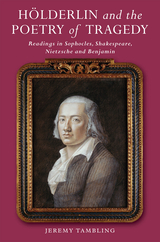 Hoelderlin and the Poetry of Tragedy: Readings in Sophocles, Shakespeare, Nietzsche and Benjamin
Jeremy Tambling
Sussex Academic Press, 2022 Hoelderlin (1770-1843) is the magnificent writer whom Nietzsche called 'my favourite poet'. His writings and poetry have been formative throughout the twentieth century, and as influential as those of Hegel, his friend. At the same time, his madness has made his poetry infinitely complex as it engages with tragedy, and irreconcilable breakdown, both political and personal, with anger and with mourning. This study gives a detailed approach to Hoelderlin's writings on Greek tragedy, especially Sophocles, whom he translated into German, and gives close attention to his poetry, which is never far from an engagement with tragedy. Hoelderlin's writings, always fascinating, enable a consideration of the various meanings of tragedy, and provide a new reading of Shakespeare, particularly Julius Caesar, Hamlet and Macbeth; the work proceeds by opening into discussion of Nietzsche, especially The Birth of Tragedy. Since Hoelderlin was such a decisive figure for Modernism, to say nothing of modern Germany, he matters intensely to such differing theorists and philosophers as Walter Benjamin, Theodor Adorno, Martin Heidegger, Maurice Blanchot and Jacques Derrida, all of whose views are discussed herein. Drawing upon the insights of Hegelian philosophy and psychoanalysis, this book gives the English-speaking reader ready access to a magnificent body of poetry and to the poet as a theorist of tragedy and of madness. Hoelderlin's poetry is quoted freely, with translations and commentary provided. This book is the first major account of Hoelderlin in English to offer the student and general reader a critical account of a vital body of work which matters to any study of poetry and to all who are interested in poetry's relationships to madness. It is essential reading in the understanding of how tragedy pervades literature and politics, and how tragedy has been regarded and written about, from Hegel to Walter Benjamin.
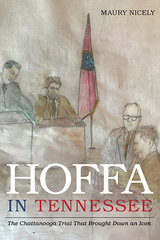 Hoffa in Tennessee: The Chattanooga Trial That Brought Down an Icon
Maury Nicely
University of Tennessee Press, 2019
By the early 1960s, Jimmy Hoffa had a stranglehold on the presidency of the Teamsters Union. However, his nemesis, Attorney General Robert F. Kennedy, was convinced that Hoffa was a corrupt force whose heavy-handed influence over the union threatened the nation. As Attorney General, Kennedy established a “Get Hoffa Squad” that set out to unearth criminal wrongdoing by the labor leader in order to remove him from power. A number of criminal trials in the 1950s and early 1960s resulted in not-guilty verdicts for Hoffa. Matters would finally come to head in Chattanooga, Tennessee, in a climatic, but often overlooked, historical moment chronicled by Maury Nicely in this engrossing book.
After a Christmastime 1962 acquittal in Nashville of charges that Hoffa had illegally received funds from a trucking company in exchange for settling a costly strike, it was discovered that several attempts had been made to bribe jurors. Fresh charges of jury tampering in that case were quickly filed against Hoffa and five others. Moved to Chattanooga, the new trial was held before a young, relatively untested federal judge named Frank Wilson. The six-week courtroom conflict would devolve into a virtual slugfest in which the defense team felt was necessary to turn its ire against Wilson, hoping to provoke an error and cause a mistrial. As Nicely shows in vivid detail, Hoffa’s Chattanooga trial became the story of a lone, embattled judge struggling mightily to control a legal proceeding that teetered on the edge of bedlam, threatening to spin out of control. In the end, Hoffa was convicted-an extraordinary change of fortune that presaged his downfall and mysterious disappearance a decade later.
In examining how justice prevailed in the face of a battering assault on the judicial system, Hoffa in Tennessee demonstrates how a Chattanooga courtroom became a crucial tipping point in Jimmy Hoffa’s career, the beginning of the end for a man long perceived as indomitable.
Hog Butcher: A Novel
Ronald L. Fair
Northwestern University Press, 2014 It’s summer on the South Side of Chicago, and ten-year-old boys Earl and Wilford are frequently courtside watching their role model Nathaniel “Cornbread” Hamilton as he prepares to leave for college on a basketball scholarship. Their world comes crashing down in an alley when two cops—one white, one black—mistake Cornbread for a fleeing burglary suspect. What follows threatens to tear apart the community. Earl and Wilford know what happened, but will they stand up for their hero in a city in which power trumps justice, and each player must decide whether to fold to the system, or risk losing it all? Instantly recognized as a gritty classic when it was first published in 1966, Hog Butcher was later adapted for the 1975 film Cornbread, Earl and Me. This new edition brings back into print Fair’s startlingly relevant indictment of Chicago’s inequalities.
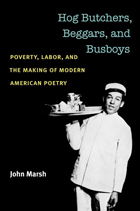 Hog Butchers, Beggars, and Busboys: Poverty, Labor, and the Making of Modern American Poetry
John Marsh
University of Michigan Press, 2011 "Impressive—Marsh successfully rewrites the founding moment of American Modernist poetry."
---Mark Van Wienen, Northern Illinois University "Cogently argued, instructive, and sensitive, Marsh’s revisionist reading opens new insights that will elicit lively comment and critical response."
---Douglas Wixson, University of Missouri–Rolla Between 1909 and 1922, the genre of poetry was remade. Literary scholars have long debated why modern American poetry emerged when and how it did. While earlier poetry had rhymed, scanned, and dealt with conventional subjects such as love and nature, modern poetry looked and sounded very different and considered new areas of experience. Hog Butchers, Beggars, and Busboys: Poverty, Labor, and the Making of Modern American Poetry argues that this change was partially the result of modern poets writing into their verse what other poetry had suppressed: the gritty realities of modern life, including the problems of the poor and working class. A closer look at the early works of the 20th century's best known poets (William Carlos Williams, T. S. Eliot, Edna St. Vincent Millay, Claude McKay, Langston Hughes, and Carl Sandburg) reveals the long-neglected role the labor problem—including sweatshops, strikes, unemployment, woman and child labor, and immigration---played in the formation of canonical modern American poetry. A revisionary history of literary modernism and exploration into how poets uniquely made the labor problem their own, this book will appeal to modernists in the fields of American and British literature as well as scholars in American studies and the growing field of working-class literature.
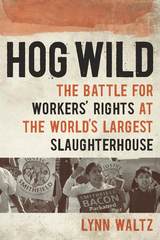 Hog Wild: The Battle for Workers' Rights at the World's Largest Slaughterhouse
Lynn Waltz
University of Iowa Press, 2018 When Smithfield Foods opened its pork processing plant in Tar Heel, North Carolina, in 1992, workers in the rural area were thrilled to have jobs at what was billed as “the largest slaughterhouse in the world.” However, they soon left in droves because of the fast, unrelenting line speed and high rate of injury. Those who stayed wanted higher wages and safer working conditions, but every time they tried to form a union, the company quickly cracked down, firing union leaders, assaulting organizers, and setting minority groups against each other.
Author and journalist Lynn Waltz reveals how these aggressive tactics went unchecked for years until Sherri Buffkin, a higher-up manager at Smithfield, blew the lid off the company’s corrupt practices. Through meticulous reporting, in-depth interviews with key players, and a mind for labor and environmental histories, Waltz weaves a fascinating tale of the nearly two-decade struggle that eventually brought justice to the workers and accountability to the food giant, pitting the world’s largest slaughterhouse against the world’s largest meatpacking union.
Following in a long tradition of books that expose the horrors of the meatpacking industry—from Upton Sinclair’s The Jungle to Eric Schlosser’s Fast Food Nation—Hog Wild uncovers rampant corporate environmental hooliganism, labor exploitation, and union-busting by one of the nation’s largest meat producers. Waltz’s eye-opening examination sheds new light on the challenges workers face not just in meatpacking, but everywhere workers have lost their power to collectively bargain with powerful corporations.
 Hogarth’s Literary Relationships
Robert Etheridge Moore
University of Minnesota Press, 1948 Hogarth's Literary Relationships was first published in 1948. Minnesota Archive Editions uses digital technology to make long-unavailable books once again accessible, and are published unaltered from the original University of Minnesota Press editions. Hogarth's narrative drawings—A Harlot's Progress, A Rake's Progress, Marriage a la Mode — have long been the delight of devotees of the eighteenth century. Although the relationship between Hogarth and the writers of the period has not passed unnoticed, it has never been analyzed in detail before. In this engaging book Mr. Moore points out specific instances of the "manifest obligations" owed by Fielding and Smollett (and several minor contemporary novelists and dramatists) to Hogarth. He amply proves his two theses: that Hogarth was a fountain of literary inspiration and that appreciation of the artist as a satirist is essential to an understanding of eighteenth-century literature. From the beginning of his career Hogarth was constantly imitated and plagiarized, and the illustrations in this volume include some of the more famous plagiaries. Hogarth's own work is too little known to present generation—no complete collection has been available for some hundred years — and the drawings reproduced in this book add greatly to its value.
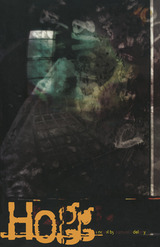 Hogg: A Novel
Samuel R. Delany
University of Alabama Press, 2004 "There is no question that Hogg by Samuel R. Delany is a serious book with literary merit." —Norman Mailer
First written thirty-five years ago and completed days before the Stonewall riots in New York, award-winning author Samuel R. Delany’s Hogg is one of America’s most famous “unpublishable” novels. It recounts three days in 1969 in the life of truck driver and rapist-for-hire, Franklin Hargus. Narrated by his young accomplice, Delaney’s novel portrays an exploration of erotic depravity, a capacious landscape of sexuality that transgresses social and erotic boundaries.
While testing readers’ tolerance, what transfigures the novel into a work of literature is Delany’s refusal, faced with moral anxieties and revulsion, to mutilate or disown his creation. Hogg’s characters wear recognizable human faces, possessing intense loyalty, perverse admiration, and a kind of integrity. Hargus fascinates. He is the embodiment of what society can turn people into, the decaying condition of the human soul.
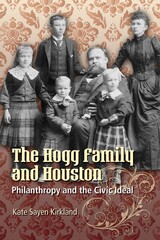 The Hogg Family and Houston: Philanthropy and the Civic Ideal
By Kate Sayen Kirkland
University of Texas Press, 2009 Progressive former governor James Stephen Hogg moved his business headquarters to Houston in 1905. For seven decades, his children Will, Ima, and Mike Hogg used their political ties, social position, and family fortune to improve the lives of fellow Houstonians. As civic activists, they espoused contested causes like city planning and mental health care. As volunteers, they inspired others to support social service, educational, and cultural programs. As philanthropic entrepreneurs, they built institutions that have long outlived them: the Houston Symphony, the Museum of Fine Arts, Memorial Park, and the Hogg Foundation. The Hoggs had a vision of Houston as a great city—a place that supports access to parklands, music, and art; nurtures knowledge of the "American heritage which unites us"; and provides social service and mental health care assistance. This vision links them to generations of American idealists who advanced a moral response to change. Based on extensive archival sources, The Hogg Family and Houston explains the impact of Hogg family philanthropy for the first time. This study explores how individual ideals and actions influence community development and nurture humanitarian values. It examines how philanthropists and volunteers mold Houston's traditions and mobilize allies to meet civic goals. It argues that Houston's generous citizens have long believed that innovative cultural achievement must balance aggressive economic expansion.
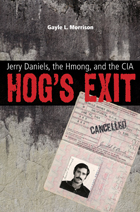 Hog’s Exit: Jerry Daniels, the Hmong, and the CIA
Gayle L. Morrison
Texas Tech University Press, 2013
It just didn’t sit right. Not with his friends, not with his coworkers, not with his hunting and fishing buddies, and certainly not with his family. The American Embassy in Bangkok had reported the accidental death of Jerry “Hog” Daniels by carbon monoxide poisoning. Three decades later, his family and most of his friends remain unconvinced that the U.S. government told them the truth about his death.
As a former CIA case officer to legendary Hmong leader General Vang Pao during the “secret war” in Laos, Jerry Daniels was experienced, smart, and careful. Those who knew him well said he wasn’t the type to die as reported. Raising even more doubts, his casket was “Permanently Sealed” by the U.S. State Department before being shipped home to Missoula, Montana, where he was honored with a three-day funeral ceremony organized by his former comrades-in-arms, the Hmong hilltribe warriors from Laos.
This book examines the unique personality and reported death of a man who was a pivotal agent in U.S./Hmong history. Friends and family share their memories of Daniels growing up in Montana, cheating death in Laos, and carousing in the bars and brothels of Thailand. First-person accounts from Americans and Hmong, ranchers and refugees, State Department officials and smokejumpers capture both human and historical stories about the life of this dedicated and irreverent individual and offer speculation on the unsettling circumstances of his death. Equally important, Hog’s Exit is the first complete account in English to document the drama and beauty of the Hmong funeral process.
Hog’s Exit provides a fascinating view of a man and the two very different cultures in which he lived.
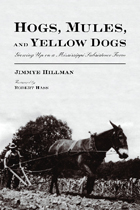 Hogs, Mules, and Yellow Dogs: Growing Up on a Mississippi Subsistence Farm
Jimmye Hillman; Foreword by Robert Hass
University of Arizona Press, 2012 "It's in the nature of things that whole worlds disappear," writes the poet Robert Hass in the foreword to Jimmye Hillman's insightful memoir. "Their vanishings, more often than not, go unrecorded or pass into myth, just as they slip from the memory of the living." To ensure that the world of Jimmye Hillman's childhood in Greene County, Mississippi during the Great Depression doesn't slip away, he has gathered together accounts of his family and the other people of Old Washington village. There are humorous stories of hog hunting and heart-wrenching tales of poverty set against a rural backdrop shaded by the local social, religious, and political climate of the time. Jimmye and his family were subsistence farmers out of bare-bones necessity, decades before discussions about sustainability made such practices laudable. More than just childhood memories and a family saga, though, this book serves as a snapshot of the natural, historical, and linguistic details of the time and place. It is a remarkable record of Southern life. Observations loaded with detail uncover broader themes of work, family loyalty, and the politics of changing times. Hillman, now eighty-eight, went on to a distinguished career as an economist specializing in agriculture. He realizes the importance of his story as an example of the cultural history of the Deep South but allows readers to discover the significance on their own by witnessing the lives of a colorful cast of characters. Hogs, Mules, and Yellow Dogs is unique, a blend of humor and reflection, wisdom and sympathy—but it's also a hard-nosed look at the realities of living on a dirt farm in a vanished world.
HOH vol 1 num 1
The University of Chicago Press
University of Chicago Press Journals, 2016
HOH vol 1 num 2
The University of Chicago Press
University of Chicago Press Journals, 2016
HOH vol 2 num 1
The University of Chicago Press
University of Chicago Press Journals, 2017
HOH vol 2 num 2
The University of Chicago Press
University of Chicago Press Journals, 2017
HOH vol 3 num 1
The University of Chicago Press
University of Chicago Press Journals, 2018
HOH vol 3 num 2
The University of Chicago Press
University of Chicago Press Journals, 2018
HOH vol 4 num 1
The University of Chicago Press
University of Chicago Press Journals, 2019
HOH vol 4 num 2
The University of Chicago Press
University of Chicago Press Journals, 2019
HOH vol 5 num 1
The University of Chicago Press
University of Chicago Press Journals, 2020
HOH vol 5 num 2
The University of Chicago Press
University of Chicago Press Journals, 2020
 The Hohokam and Their World: An Exploration of Art and Iconography
Linda M. Gregonis and Victoria R. Evans
University of Arizona Press, 2025 People traveling around the Sonoran Desert will see the traces of an ancient society, the Hohokam, through the material that they left behind—pottery, shell ornaments, carved stone, and rock imagery.
The Hohokam and Their World offers readers the opportunity to explore how these various images and objects may have been used by the Hohokam, and what the icons and objects may have meant, including how the Hohokam conveyed ideas about water, the Sonoran Desert, the ocean, travel, ancestors, and the cosmos.
Authors Linda M. Gregonis and Victoria R. Evans discuss how artists drew inspiration from their Sonoran Desert homeland and were also influenced by the cultures of western Mexico, the hunter-gatherers of the western desert, the Mogollon to the east, and the Pueblo cultures of the northern Southwest. Unlike traditional archaeological texts, this book takes a holistic approach by examining a diverse range of artistic expressions used by the Hohokam. From intricately crafted pottery to mesmerizing carvings in rock, each medium offers a unique glimpse into the Hohokam’s relationship with their environment and the wider world.
Whether you’re planning a visit to national parks or museums in the Southwest or simply intrigued by ancient civilizations, The Hohokam and Their World is a must-read. The work includes a glossary of key archaeological and anthropological terms, as well as endnotes and an extensive list of references for those who want to dig deeper.
The Hohokam: Desert Farmers and Craftsmen, Excavations at Snaketown, 1964–1965
Emil W. Haury
University of Arizona Press, 1976 "For a calculated 1,400 years, Snaketown was a viable village, but unlike so many tells in the Near East, the people remained the same while their culture changed. The smoothly graded typological sequences for most attributes suggest to me that the ethnic identity of the inhabitants was not interrupted, that they were one and the same people experiencing normal internal evolutionary cultural modifications wtih occasional boosts of features and ideas newly arrived from the outside." —Emil W. Haury
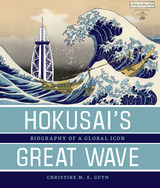 Hokusai’s Great Wave: Biography of a Global Icon
Christine M. E. Guth
University of Hawaii Press, 2015 Hokusai’s “Great Wave,” as it is commonly known today, is arguably one of Japan’s most successful exports, its commanding cresting profile instantly recognizable no matter how different its representations in media and style. In this richly illustrated and highly original study, Guth examines the iconic wave from its first publication in 1831 through the remarkable range of its articulations, arguing that it has been a site where the tensions, contradictions, and, especially, the productive creativities of the local and the global have been negotiated and expressed. She follows the wave’s trajectory across geographies, linking its movements with larger political, economic, technological, and sociocultural developments. Adopting a case study approach, Guth explores issues that map the social life of the iconic wave across time and place, from the initial reception of the woodblock print in Japan, to the image’s adaptations as part of “international nationalism,” its place in American perceptions of Japan, its commercial adoption for lifestyle branding, and finally to its identification as a tsunami, bringing not culture but disaster in its wake.
Wide ranging in scope yet grounded in close readings of disparate iterations of the wave, multidisciplinary and theoretically informed in its approach, Hokusai’s Great Wave will change both how we look at this global icon and the way we study the circulation of Japanese prints. This accessible and engagingly written work moves beyond the standard hagiographical approach to recognize, as categories of analysis, historical and geographic contingency as well as visual and technical brilliance. It is a book that will interest students of Japan and its culture and more generally those seeking fresh perspectives on the dynamics of cultural globalization.
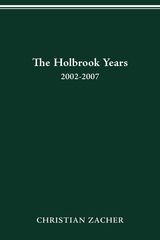 The Holbrook Years: 2002–2007
Christian Zacher
Ohio State University Press, 2012 The Holbrook Years 2002–2007 chronicles the tenure of Karen A. Holbrook, thirteenth president of The Ohio State University, from the extensive search process to her departure. As the thirteenth volume of history of presidents of The Ohio State University, it includes the personal and public life Holbrook, the first woman and research scientist to lead The Ohio State University. The OSU Board of Trustees and its presidential search committee found in Holbrook’s experience many reasons to invite her to lead Ohio’s flagship institution of higher education. Foremost among them was her familiarity with academic medicine, which they thought would give her a special understanding of OSU’s growing medical center. She was particularly interested in fostering multi-disciplinary programs and emphasizing outreach via pre-collegiate programs to broaden the pipeline for students who saw The Ohio State University as a goal.
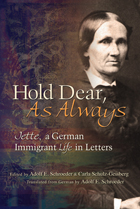 Hold Dear, As Always: Jette, a German Immigrant Life in Letters
Adolf E. Schroeder and Carla Schulz-Geisberg
University of Missouri Press, 1988 Henriette Geisberg Bruns was twenty-three when she arrived in 1836 at the isolated Westphalia Settlement in central Missouri with her husband, baby son, two brothers, and a maid. Jette, as she was known to her family and friends, had not come to America by inclination, but from duty. Her husband Bernhard, a physician, had fallen victim to the emigration fever sweeping Germany in the 1830s and was convinced that he could provide a better life for his family in the American Free States where land was plentiful, the soil was fertile, and taxes were low. Born into a large, prosperous, closely knit family, Jette had set out for the New World reluctantly; but once in Missouri, she was determined not to give up and go back home, as a neighboring family did. Although she maintained her resolve, this collection of letters written to her family in Germany shows that her life in America was often beset by deprivation, disease, and loneliness. Jette had been persuaded to emigrate for the sake of her children’s future; however, of the ten born in central Missouri, five died in childhood, three within three weeks in September and October 1841.Despite the family responsibilities and the hardships she faced in Missouri, Jette maintained a lively interest in American political and social life. For fifteen years in Westphalia and almost fifty in Jefferson City and St. Louis, she observed and offered astute—if sometimes acerbic—commentary on the historic as well as the daily events of nineteenth-century life. Left destitute by the death of her husband, who had served as mayor of Jefferson City during the Civil War, she opened a boarding-house in her home across from the state capitol to support her own children and those of her brother. There the German radicals in state government gathered to argue and debate. This rare collection of personal family letters, combined with an autobiographical sketch Jette wrote after the Civil War, illuminates the experience of one immigrant woman in a land that was always foreign to her.
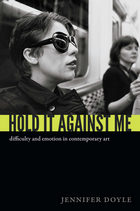 Hold It Against Me: Difficulty and Emotion in Contemporary Art
Jennifer Doyle
Duke University Press, 2013 In Hold It Against Me, Jennifer Doyle explores the relationship between difficulty and emotion in contemporary art, treating emotion as an artist's medium. She encourages readers to examine the ways in which works of art challenge how we experience not only the artist's feelings, but our own. Discussing performance art, painting, and photography, Doyle provides new perspectives on artists including Ron Athey, Aliza Shvarts, Thomas Eakins, James Luna, Carrie Mae Weems, and David Wojnarowicz. Confronting the challenge of writing about difficult works of art, she shows how these artists work with feelings as a means to question our assumptions about identity, intimacy, and expression. They deploy the complexity of emotion to measure the weight of history, and to deepen our sense of where and how politics happens in contemporary art. Doyle explores ideologies of emotion and how emotion circulates in and around art. Throughout, she gives readers welcoming points of entry into artworks that they may at first find off-putting or confrontational. Doyle offers new insight into how the discourse of controversy serves to shut down discussion about this side of contemporary art practice, and counters with a critical language that allows the reader to accept emotional intensity in order to learn from it.
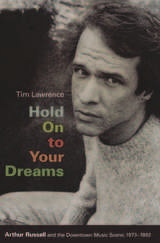 Hold On to Your Dreams: Arthur Russell and the Downtown Music Scene, 1973-1992
Tim Lawrence
Duke University Press, 2009 Hold On to Your Dreams is the first biography of the musician and composer Arthur Russell, one of the most important but least known contributors to New York's downtown music scene during the 1970s and 1980s. With the exception of a few dance recordings, including "Is It All Over My Face?" and "Go Bang! #5", Russell's pioneering music was largely forgotten until 2004, when the posthumous release of two albums brought new attention to the artist. This revival of interest gained momentum with the issue of additional albums and the documentary film Wild Combination. Based on interviews with more than seventy of his collaborators, family members, and friends, Hold On to Your Dreams provides vital new information about this singular, eccentric musician and his role in the boundary-breaking downtown music scene. Tim Lawrence traces Russell's odyssey from his hometown of Oskaloosa, Iowa, to countercultural San Francisco, and eventually to New York, where he lived from 1973 until his death from AIDS-related complications in 1992. Resisting definition while dreaming of commercial success, Russell wrote and performed new wave and disco as well as quirky rock, twisted folk, voice-cello dub, and hip-hop-inflected pop. “He was way ahead of other people in understanding that the walls between concert music and popular music and avant-garde music were illusory,” comments the composer Philip Glass. "He lived in a world in which those walls weren't there." Lawrence follows Russell across musical genres and through such vital downtown music spaces as the Kitchen, the Loft, the Gallery, the Paradise Garage, and the Experimental Intermedia Foundation. Along the way, he captures Russell's openness to sound, his commitment to collaboration, and his uncompromising idealism.
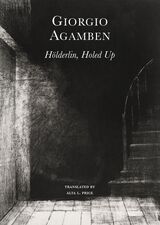 Hölderlin’s Madness: Chronicle of a Dwelling Life, 1806–1843
Giorgio Agamben
Seagull Books, 2023 One of Europe’s greatest living philosophers, Giorgio Agamben, analyzes the life and work of one of Europe’s greatest poets, Friedrich Hölderlin.
What does it mean to inhabit a place or a self? What is a habit? And, for human beings, doesn’t living mean—first and foremost—inhabiting? Pairing a detailed chronology of German poet Friedrich Hölderlin’s years of purported madness with a new examination of texts often considered unreadable, Giorgio Agamben's new book aims to describe and comprehend a life that the poet himself called habitual and inhabited.
Hölderlin’s life was split neatly in two: his first 36 years, from 1770 to 1806; and the 36 years from 1807 to 1843, which he spent as a madman holed up in the home of Ernst Zimmer, a carpenter. The poet lived the first half of his existence out and about in the broader world, relatively engaged with current events, only to then spend the second half entirely cut off from the outside world. Despite occasional visitors, it was as if a wall separated him from all external events and relationships. For reasons that may well eventually become clear, Hölderlin chose to expunge all character—historical, social, or otherwise—from the actions and gestures of his daily life. According to his earliest biographer, he often stubbornly repeated, “nothing happens to me.” Such a life can only be the subject of a chronology—not a biography, much less a clinical or psychological analysis. Nevertheless, this book suggests that this is precisely how Hölderlin offers humanity an entirely other notion of what it means to live. Although we have yet to grasp the political significance of his unprecedented way of life, it now clearly speaks directly to our own.
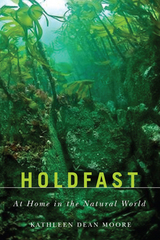 Holdfast: At Home in the Natural World
Kathleen Dean Moore
Oregon State University Press, 2013 Naturalist and philosopher Kathleen Dean Moore meditates on connection and separation in these twenty-one elegant, probing essays. Using the metaphor of holdfasts—the structures that attach seaweed to rocks with a grip strong enough to withstand winter gales—she examines our connections to our own bedrock. “When people lock themselves in their houses at night and seal the windows shut to keep out storms, it is possible to forget, sometimes for years and years, that human beings are part of the natural world,” she writes. Holdfast passionately reclaims an awareness of the natural world, exploring the sense of belonging fostered by the communal howls of wolves; the inevitability of losing children to their own lives; the fear of bears and love of storms; the sublimity of life and longing in the creatures of the sea; her agonizing decision when facing her father’s bone-deep pain. As Moore travels philosophically and geographically—from Oregon’s shores to Alaska’s islands—she leaves no doubt of her virtuosity and range. The new afterword is an important statement on the new responsibilities of nature writers as the world faces the consequences of climate change.
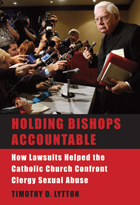 Holding Bishops Accountable: How Lawsuits Helped the Catholic Church Confront Clergy Sexual Abuse
Timothy D. Lytton
Harvard University Press, 2008 The sexual abuse of children by Catholic clergy is arguably the most acute crisis Catholicism has faced since the Reformation. The prevalence of clergy sexual abuse and its shocking cover-up by church officials have obscured the largely untold story of the tort system’s remarkable success in bringing the scandal to light, focusing attention on the need for institutional reform, and spurring church leaders and public officials into action.
Stories of the tort system as an engine of social justice are rare. Holding Bishops Accountable tells one such story by revealing how pleadings, discovery documents, and depositions fueled media coverage of the scandal. Timothy Lytton shows how the litigation strategy of plaintiffs’ lawyers gave rise to a widespread belief that the real problem was not the actions of individual priests but rather the church’s massive institutional failure. The book documents how church and government policymakers responded to the problem of clergy sexual abuse only under the pressure of private lawsuits.
As Lytton deftly demonstrates, the lessons of clergy sexual abuse litigation give us reason to reconsider the case for tort reform and to look more closely at how tort litigation can enhance the performance of public and private policymaking institutions.
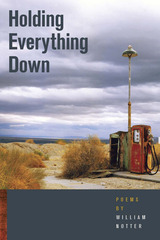 Holding Everything Down
William Notter
Southern Illinois University Press, 2009 William Notter’s stunning collection Holding Everything Down explores the everyday struggles, triumphs, and desires of rural Americans. With disarming humor and remarkable honesty, Notter delves into the most personal longings of those who inhabit America’s countrysides: places bound by secrets and ghosts, where joy is discovered in the most unlikely of locations, and even the land itself has a story to tell. These highly accessible poems traverse the world of weekend rodeos, lonely highways, and windswept battlefields; they follow the twin paths of addiction and obsession, and the trials of newfound sobriety. Connections are forged beneath weathered ceilings, and love can be found over a plate of barbecue. Also explored are the depths of humanity’s relationship with nature and freedom, be it the smell of freshly threshed wheat, the purple thunderheads of an approaching storm, or a sunset viewed from Mississippi’s highest peak. From the muddy deltas of the deep South to the crags of the Big Horn Mountains, Notter’s deeply candid portraits transcend stereotypes to expose an often unseen side of Americana. Hairdresser or handyman, rodeo rider or rancher’s wife, each voice ultimately echoes with the most human of experiences, unveiling the common threads that bind us to our world and to each other.
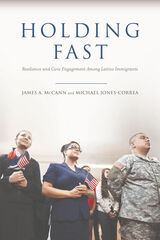 Holding Fast: Resilience and Civic Engagement Among Latino Immigrants
James A. McCann
Russell Sage Foundation, 2020 The fight over immigration reform and immigrants’ rights in the U.S. has been marked by sharp swings in both public sentiment and official enforcement. In 2006, millions of Latino immigrants joined protests for immigration reform. Deferred Action for Childhood Arrivals, a policy granting work permits and protection from deportation to undocumented immigrants who entered the country before age 16, was enacted in 2012, despite a sharp increase in deportations during the Bush and Obama administrations. The 2016 election of Donald J. Trump prompted a surge in anti-immigrant sentiment which threatened DACA and other progressive immigration policies. In Holding Fast, political scientists James McCann and Michael Jones-Correa investigate whether and how these recent shifts have affected political attitudes and civic participation among Latino immigrants.
Holding Fast draws largely from a yearlong survey of Latino immigrants, including both citizens and noncitizens, conducted before and after the 2016 election. The survey gauges immigrants’ attitudes about the direction of the country and the emotional underpinnings of their political involvement. While survey respondents expressed pessimism about the direction of the United States following the 2016 election, there was no evidence of their withdrawal from civic life. Instead, immigrants demonstrated remarkable resilience in their political engagement, and their ties to America remained robust.
McCann and Jones-Correa examine Latino immigrants’ trust in government as well as their economic concerns and fears surrounding possible deportations of family members and friends. They find that Latino immigrants who were concerned about the likelihood of deportation were more likely to express a lack of trust in government. Concerns about personal finances were less salient. Disenchantment with the U.S. government did not differ based on citizenship status, length of stay in America, or residence in immigrant-friendly states. Foreign-born Latinos who are naturalized citizens shared similar sentiments to those with fewer political rights, and immigrants in California, for example, express views similar to those in Texas.
Addressing the potential influence immigrant voters may wield in in the coming election, the authors point to signs that the turnout rate for naturalized Latino immigrant may be higher than that for Latinos born in the United States. The authors further underscore the importance of the parties' platforms and policies, noting the still-tenuous nature of Latino immigrants’ affiliations with the Democratic Party.
Holding Fast outlines the complex political situation in which Latino immigrants find themselves today. Despite well-founded feelings of anger, fear, and skepticism, in general they maintain an abiding faith in the promise of American democracy. This book provides a comprehensive account of Latino immigrants’ political opinions and a nuanced, thoughtful outlook on the future of Latino civic participation. It will be an important contribution to scholarly work on civic engagement and immigrant integration.
Holding Ground
Bruce Willard
Four Way Books, 2013 Often rooted in nature, the poems in Holding Ground are written from a precipice, in the space of a quiet whisper before the howl of the approaching storm: “Let’s look for shelter,” he says. The effect is an atmosphere of yearning, and of searching to understand the simple as well as the difficult moments in a life.
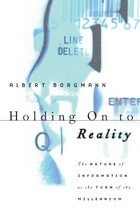 Holding On to Reality: The Nature of Information at the Turn of the Millennium
Albert Borgmann
University of Chicago Press, 1999 Holding On to Reality is a brilliant history of information, from its inception in the natural world to its role in the transformation of culture to the current Internet mania and is attendant assets and liabilities. Drawing on the history of ideas, the details of information technology, and the boundaries of the human condition, Borgmann illuminates the relationship between things and signs, between reality and information.
"[Borgmann] has offered a stunningly clear definition of information in Holding On to Reality. . . . He leaves room for little argument, unless one wants to pose the now vogue objection: I guess it depends on what you mean by nothing."—Paul Bennett, Wired
"A superb anecdotal analysis of information for a hype-addled age."—New Scientist
"This insightful and poetic reflection on the changing nature of information is a wonderful antidote to much of the current hype about the 'information revolution.' Borgmann reminds us that whatever the reality of our time, we need 'a balance of signs and things' in our lives."—Margaret Wertheim, LA Weekly
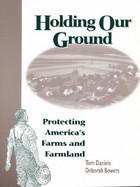 Holding Our Ground: Protecting America's Farms And Farmland
Tom Daniels and Deborah Bowers
Island Press, 1997 Farmers, who own or rent most of the private land in America, hold the key not only to the nation's food supply, but also to managing community growth, maintaining an attractive landscape, and protecting water and wildlife resources. While the issue of protecting farmland and open space is not new, the intensity of the challenge has increased. Farmers are harder pressed to make a living, and rural and suburban communities are struggling to accommodate increasing populations and the development that comes with them. Holding Our Ground can help landowners and communities devise and implement effective strategies for protecting farmland. The book: - discusses the reasons for protecting farmland and how to make those reasons widely known and understood
- describes the business of farming, federal government farm programs, and the role of land in farmers's decisions
- analyzes federal, state, and local farmland protection efforts and techniques
- explores a variety of land protection options including purchase of development rights; transfer of development rights; private land trusts; and financial, tax, and estate planning
- reviews the strengths and weaknesses of the farmland protection tools available
The authors describe the many challenges involved in protecting farmland and explain how to create a package of techniques that can meet those challenges. In addition, they offer appendixes with model zoning ordinances, nuisance disclaimers, conservation easements, and other documents that individuals and communities need to carry out the programs discussed. Holding Our Ground provides citizens, elected officials, planners, and landowners with a solid basis for understanding the issues behind farmland protection, and will be an invaluable resource in developing techniques and programs for achieving long-term protection goals.
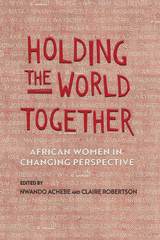 Holding the World Together: African Women in Changing Perspective
Edited by Nwando Achebe and Claire Robertson
University of Wisconsin Press, 2021 Featuring contributions from some of the most accomplished scholars on the topic, Holding the World Together explores the rich and varied ways in which women have wielded power across the African continent, from the precolonial period to the present. Suitable for classroom use, this comprehensive volume considers such topics as the representation of African women, their role in national liberation movements, their experiences of religious fundamentalism (both Christian and Muslim), their incorporation into the world economy, changing family and marriage systems, impacts of the world economy on their lives and livelihoods, and the unique challenges they face in the areas of health and disease.
Contributors: Nwando Achebe, Ousseina Alidou, Signe Arnfred, Andrea L. Arrington-Sirois, Henryatta Ballah, Teresa Barnes, Josephine Beoku-Betts, Emily Burril, Abena P. A. Busia, Gracia Clark, Alicia Decker, Karen Flint, December Green, Cajetan Iheka, Rachel Jean-Baptiste, Elizabeth M. Perego, Claire Robertson, Kathleen Sheldon, Aili Mari Tripp, Cassandra Veney
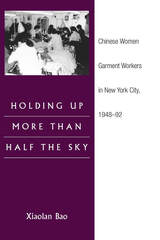 Holding Up More Than Half the Sky: Chinese Women Garment Workers in New York City, 1948-92
Xiaolan Bao
University of Illinois Press, 2001 In 1982, 20,000 Chinese-American garment workers—most of them women—went on strike in New York City. Every Chinese garment industry employer in the city soon signed a union contract. The successful action reflected the ways women's changing positions within their families and within the workplace galvanized them to stand up for themselves. Xiaolan Bao's now-classic study penetrates to the heart of Chinese American society to explain how this militancy and organized protest, seemingly so at odds with traditional Chinese female behavior, came about. Drawing on more than one hundred interviews, Bao blends the poignant personal stories of Chinese immigrant workers with the interwoven history of the garment industry and the city's Chinese community. Bao shows how the high rate of married women employed outside the home profoundly transformed family culture and with it the image and empowerment of Chinese American women. At the same time, she offers a complex and subtle discussion of the interplay of ethnic and class factors within New York's garment industry. Passionately told and prodigiously documented, Holding Up More Than Half the Sky examines the journey of a community's women through an era of change in the home, on the shop floor, and walking the picket line.
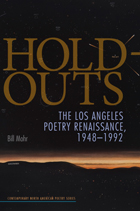 Hold-Outs: The Los Angeles Poetry Renaissance, 1948-1992
Bill Mohr
University of Iowa Press, 2011 In Hold-Outs, Bill Mohr, long a figure on the Los Angeles poetry scene, reveals the complicated evolution of the literary landscape in a city famous for its production of corporate culture. Mohr’s multigenerational account of the role of the poet-editor-publisher in Los Angeles community formation is nothing less than a radiant mosaic of previously little-known details about an important center of American poetry. While explaining the important role of L.A. in contemporary American poetry, Mohr also explores the ideals and perils of the small press movement in the twentieth century, providing a new generation of literary activists with the knowledge that is needed to inspire their own redefinitions of the social value of alternative artistic practices. Drawing on extensive archival research of original documents, Mohr argues that West Coast poets in general (and Los Angeles poets in particular) have been part of what can be called not so much a haven of more imaginatively inspired artists but, rather, a site of revisionist creativity. Revealed here are the personalities (including Stuart Perkoff, Wanda Coleman, Leland Hickman, Paul Vangelisti, Don Gordon, Suzanne Lummis, John Thomas, Ron Koertge, and Charles Bukowski, among others), the institutions, the publications, and the informal poetry groups that together formed a matrix that encouraged poetry to be written, performed, published, and acknowledged. Hold-Outs is a stunning roadmap of the interwoven contexts of an ongoing cultural debate whose most important witnesses are finally being heard.
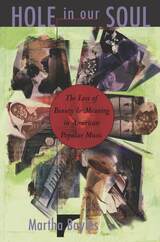 Hole in Our Soul: The Loss of Beauty and Meaning in American Popular Music
Martha Bayles
University of Chicago Press, 1996 From Queen Latifa to Count Basie, Madonna to Monk, Hole in Our Soul: The Loss of Beauty and Meaning in American Popular Music traces popular music back to its roots in jazz, blues, country, and gospel through the rise in rock 'n' roll and the emergence of heavy metal, punk, and rap. Yet despite the vigor and balance of these musical origins, Martha Bayles argues, something has gone seriously wrong, both with the sound of popular music and the sensibility it expresses.
Bayles defends the tough, affirmative spirit of Afro-American music against the strain of artistic modernism she calls 'perverse.' She describes how perverse modernism was grafted onto popular music in the late 1960s, and argues that the result has been a cult of brutality and obscenity that is profoundly anti-musical.
Unlike other recent critics of popular music, Bayles does not blame the problem on commerce. She argues that culture shapes the market and not the other way around. Finding censorship of popular music "both a practical and a constitutional impossibility," Bayles insists that "an informed shift in public tastes may be our only hope of reversing the current malignant mood."
The Hole in the Fabric: Science, Contemporary Literature, and Henry James
Strother B. Purdy
University of Pittsburgh Press, 1977
In this imaginative and provocative book, Purdy draws upon the work of a such writers as Kurt Vonnegut, Vladimir Nabokov, Alain Robbe-Grillet, Günter Grass, Samuel Becket, and Eugene Ionesco to suggest ways in which novelists explore the unknown. His ingenious consideration of Henry James in conjunction with these novelists, as well as with science fiction and detective fiction writers and with mid-century scientific discoveries and advances—black holes, hydrogen bombs, space travel—offers rich, new insights into James’s work and into the twentieth-century view of humanity’s place in the world.
A Hole in the Ground with a Liar at the Top: Fraud and Deceit in the Golden Age of American Mining
Dan Plazak
University of Utah Press, 2006 Coal, silver, gold. There is something about the allure of hidden treasure that puts a glint in people’s eyes. By gathering such familiar stories as that of Nevada’s infamous Comstock Lode with a succession of lesser-known scandals, Dan Plazak provides an entertaining and informative volume that delightfully investigates the history of mining frauds in the United States from the Civil War to World War I.
A Hole in the Heavens
Dyan Elliott
Arizona Center for Medieval and Renaissance Studies, 2017 What if Satan were to disguise himself as an angel of light? What if he even appeared as Christ? Schoolmen in late medieval Paris were obsessed with that question--and A Hole in the Heavens explores the alarming consequences of this obsession. It soon becomes impossible to tell the difference between saints and impostors, conversion and demonic possession, heresy and the true faith. Even the wisest and holiest may be deceived. A struggling student, a pair of prostitutes, and a beautiful priest's daughter are among those caught up in the chaos. Based on meticulous research, Dyan Elliott's first novel is an absorbing and ultimately chilling exercise in the discernment of spirits.
A Hole in the Language
Marly Swick
University of Iowa Press, 1990 These stories are delicate seismographic meditations on disaster and its aftershocks. The characters are survivors, digging their way out of the past, shaken but hopeful. Despite all their tragic losses, there is a pervasive sense of humor, hope, and forgiveness: abandonment leads ultimately to reunion, grief to solace. This is contemporary America—a jigsaw puzzle of fragmented families constantly picking up the pieces and fitting themselves together in new ways to form unforgettable pictures.
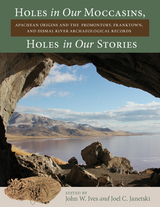 Holes in Our Moccasins, Holes in Our Stories: Apachean Origins and the Promontory, Franktown, and Dismal River Archaeological Records
Edited by John W. Ives and Joel C. Janetski
University of Utah Press, 2022 From 1930 to 1931, Julian Steward recovered hundreds of well-worn moccasins, along with mittens, bison robe fragments, bows, arrows, pottery, bone and stone tools, cordage, gaming pieces, and abundant faunal remains, making Utah’s Promontory Caves site one of the most remarkable hunter-gatherer archaeological records in western North America. Although Steward recognized that the moccasins and other artifacts were characteristic of the Canadian Subarctic and northern Plains and not the Great Basin, his findings languished for decades.
This volume connects Steward’s work with results from new excavations in Promontory Caves 1 and 2 and illustrates that the early Promontory Phase resulted from an intrusive large-game hunting population very different from nearby late Fremont communities. Lingering for just one or two human generations, the cave occupants began to accept people as well as material and symbolic culture from surrounding thirteenth-century neighbors. Volume contributors employ a transdisciplinary approach to evaluate the possibility that the Promontory Phase materials reflect the presence of Apachean ancestors. In these records lies the seeds for the intensive Plains-Puebloan interactions of the centuries that followed.
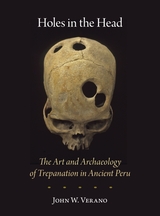 Holes in the Head: The Art and Archaeology of Trepanation in Ancient Peru
John W. Verano
Harvard University Press Trepanation is the oldest surgical procedure known from antiquity, extending back more than five thousand years in Europe and to at least the fifth century BC in the New World. Anthropologists and medical historians have been investigating ancient trepanation since the mid-nineteenth century, but questions remain about its origins, evolution, and the possible motivations for conducting such a dangerous surgical procedure. Peru is particularly important to these questions, as it boasts more trepanned skulls than the rest of the world combined. This volume presents the results of a long-term research project that examined more than 800 trepanned skulls from recent archaeological excavations and from museum collections in Peru, the United States, and Europe. It examines trepanation in ancient Peru from a broad anthropological and historic perspective, focusing on the archaeological context of osteological collections and highlighting the history of discoveries. It explores the origins and spread of the practice throughout the Central Andes, with a focus on trepanation techniques, success rates, and motivations for trepanning. It examines the apparent disappearance of trepanation in the Andes following Spanish conquest, while noting that there are reports of trepanations being performed by healers in highland Peru and Bolivia into the twentieth century.
Holiday
Susan Hahn
University of Chicago Press, 2001 Holiday is a book of poems chiseled into both public and private calendar markers, where the unfinished self seeks, desperately and defiantly, resolution through either completion or negation. The poems are filled with unflinching irony and an intelligence that celebrates and laments personal, mythic, biblical, and historical events.
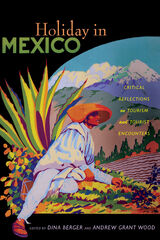 Holiday in Mexico: Critical Reflections on Tourism and Tourist Encounters
Dina Berger and Andrew Grant Wood, eds.
Duke University Press, 2009 With its archaeological sites, colonial architecture, pristine beaches, and alluring cities, Mexico has long been an attractive destination for travelers. The tourist industry ranks third in contributions to Mexico’s gross domestic product and provides more than 5 percent of total employment nationwide. Holiday in Mexico takes a broad historical and geographical look at Mexico, covering tourist destinations from Tijuana to Acapulco and the development of tourism from the 1840s to the present day. Scholars in a variety of fields offer a complex and critical view of tourism in Mexico by examining its origins, promoters, and participants. Essays feature research on prototourist American soldiers of the mid-nineteenth century, archaeologists who excavated Teotihuacán, business owners who marketed Carnival in Veracruz during the 1920s, American tourists in Mexico City who promoted goodwill during the Second World War, American retirees who settled San Miguel de Allende, restaurateurs who created an “authentic” cuisine of Central Mexico, indigenous market vendors of Oaxaca who shaped the local tourist identity, Mayan service workers who migrated to work in Cancun hotels, and local officials who vied to develop the next “it” spot in Tijuana and Cabo San Lucas. Including insightful studies on food, labor, art, diplomacy, business, and politics, this collection illuminates the many processes and individuals that constitute the tourism industry. Holiday in Mexico shows tourism to be a complicated set of interactions and outcomes that reveal much about the nature of economic, social, cultural, and environmental change in Greater Mexico over the past two centuries. Contributors. Dina Berger, Andrea Boardman, Christina Bueno, M. Bianet Castellanos, Mary K. Coffey, Lisa Pinley Covert, Barbara Kastelein, Jeffrey Pilcher, Andrew Sackett, Alex Saragoza, Eric M. Schantz, Andrew Grant Wood
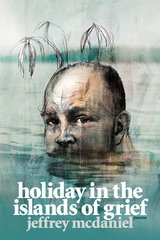 Holiday in the Islands of Grief: Poems
Jeffrey McDaniel
University of Pittsburgh Press, 2020 In his new collection, Jeffrey McDaniel confronts the insular and expansive qualities of loss. With electric language and surrealistic imagery, McDaniel’s poems deliver the quotidian elements of middle-age life while weaving us in & out of childhood and adulthood alongside body and mind. The tragic and life affirming share the same page and the same world, reminding us how close corruption can be to innocence; domesticity to fantasy; aging to youth.
Jonathan
We are underwater off the coast of Belize.
The water is lit up even though its dark
as if there are illuminated seashells
scattered on the ocean floor.
We’re not wearing oxygen tanks,
yet staying underwater for long stretches.
We are looking for the body of the boy
we lost. Each year he grows a little older.
Last December I opened his knapsack
and stuck in a plastic box of carrots.
Even though we’re underwater, we hear
a song playing over a policeman’s radio.
He comes to the shoreline to park
and eat midnight sandwiches, his headlights
fanning out across the harbor.
And I hold you close, apple of my closed eye,
red dance of my opened fist.
 Holidays in the Danger Zone: Entanglements of War and Tourism
Debbie Lisle
University of Minnesota Press, 2016 Holidays in the Danger Zone exposes the mundane and everyday interactions between two seemingly opposed worlds: warfare and tourism. Debbie Lisle shows how a tourist sensibility shapes the behavior of soldiers in war—especially the experiences of Western military forces in “exotic” settings. This includes not only R&R but also how battlefields become landscapes of leisure and tourism. She further explores how a military sensibility shapes the development of tourism in the postwar context, from “Dark Tourism” (engaging with displays of conflict and atrocity) to exhibitions of conflict in museums and at memorial sites, as well as advertising, film, journals, guidebooks, blogs, and photography. Focused on how war and tourism reinforce prevailing modes of domination, Holidays in the Danger Zone critically examines the long historical arc of the war–tourism nexus—from nineteenth-century imperialism to World War I and World War II, from the Cold War to globalization and the War on Terror.
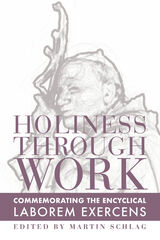 Holiness through Work: Commemorating the Encyclical Laborem Exercens
Martin Schlag
St. Augustine's Press, 2022 To mark the 40th anniversary of John Paul II's encyclical on human work, published in 1981, a group of globally-recognized scholars presents the critical aspects of this document and its purpose. These original essays revisit John Paul II's approach to work in post-modern society and reconnect the dignity of the working person to a pursuit of holiness. These authors convey that only when it is truly Christian can humanism accomplish the lofty ideals it indicates.
This book is a timely contribution to the field of scholarship that focuses on Catholic Social Thought and is ideally suited for graduate studies and the reader interested in more serious questions in Christian theology.
Giulio Maspero, "The Bible and the Fathers of the Church on Work"
Patricia Ranft, "Work Theology in the High Middle Ages"
Angela Franks, "John Paul II's Metaphysics of Labor"
Deborah Savage, "Confronting a Technocratic Future: Women's Work and the Church's Social Vision"
Martin Schlag, "Contemplation at Work: A Theological Conversation Between John Paul II and Josemaría Escrivá"
Richard Turnbull, "Laborem Exercens: A Protestant Appreciation"
Michael Naughton, "Good Work: Insights from the Subjective Dimension of Work"
Christopher Michaelson, "Subjects and Objects in Meaningful Work"
Javier Ignacio Pinto Garay and Alvaro Pezoa Bissieres, "The Worker and the Transistor: The Dignity of Work and Business Ethics in Global Corporate Practices"
Gonzalo Flores-Castro Lingán, "The Real Work: Making the Encyclical Laborem Exercens Operational"
Geoffrey C. Friesen, "Laborem Exercens and the Subjective Dimension of Work in Economics and Finance"
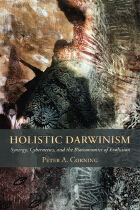 Holistic Darwinism: Synergy, Cybernetics, and the Bioeconomics of Evolution
Peter Corning
University of Chicago Press, 2005 In recent years, evolutionary theorists have come to recognize that the reductionist, individualist, gene-centered approach to evolution cannot sufficiently account for the emergence of complex biological systems over time. Peter A. Corning has been at the forefront of a new generation of complexity theorists who have been working to reshape the foundations of evolutionary theory. Well known for his Synergism Hypothesis—a theory of complexity in evolution that assigns a key causal role to various forms of functional synergy—Corning puts this theory into a much broader framework in Holistic Darwinism, addressing many of the issues and concepts associated with the evolution of complex systems. Corning's paradigm embraces and integrates many related theoretical developments of recent years, from multilevel selection theory to niche construction theory, gene-culture coevolution theory, and theories of self-organization. Offering new approaches to thermodynamics, information theory, and economic analysis, Corning suggests how all of these domains can be brought firmly within what he characterizes as a post–neo-Darwinian evolutionary synthesis.
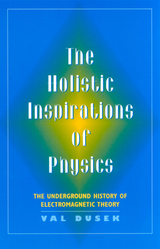 The Holistic Inspiration of Physics: The Underground History of Electromagnetic Theory
Dusek, Val
Rutgers University Press, 1999 While many books have claimed parallels between modern physics and Eastern philosophy, none have dealt with the historical influences of both Chinese traditional thought and non-mechanistic, holistic western thought on the philosophies of the scientists who developed electromagnetic field theory. In The Holistic Inspirations of Physics, R. Valentine Dusek asks: to what extent is classical field theory a product of organic and holistic philosophies and frameworks? Electromagnetic theory has been greatly influenced by holistic worldviews, Dusek posits, and he highlights three alternative scientific systems that made the development of electromagnetic theory possible: medieval Chinese science, Western Renaissance occultism, and the German romantic traditions. He situates these "alternative" approaches in their social context and background, and traces their connection with components of “accepted” physical science in relation to a number of social movements and philosophical theories. Readers will learn of specific contributions made by these alternative traditions, such as the Chinese inventing the compass and discovering the earth's magnetic field and magnetic declination. Western alchemical ideas of active forces and "occult" influences contributed to Newton's theory of gravitation force as action at a distance, rather as a result of purely mechanical collisions and contact action. Dusek also describes the extent to which women's culture supplied (often without credit) the philosophical background ideas that were absorbed into mainstream field theory.
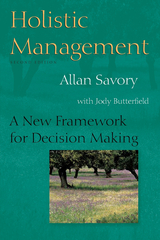 Holistic Management: A New Framework for Decision Making
Allan Savory and Jody Butterfield; Center for Holistic Management
Island Press, 1999 Increasingly sophisticated technology and an ever-expand-ing base of knowledge have not been enough to allow humans to halt the worldwide progression of environmental degradation. Extensive fieldwork in both Africa and the United States convinced Allan Savory that neither the forces of nature nor commonly blamed culprits -- overpopulation, poor farming practices, lack of financial support -- were causing the decline of once-healthy ecosystems. He also noted that once land has become degraded, leaving it alone seldom helps revitalize it. Savory eventually came to realize that on the most fundamental level, environmental problems are caused by human management decisions, and only through wholesale changes in the way decisions are made can functioning ecosystems be restored. In response to that startling discovery, Savory began to develop a revolutionary new approach to decision-making and management. Known initially as Holistic Resource Management, and now as simply Holistic Management, it considers humans, their economies, and the environment as inseparable. It includes a common-sense decision-making framework that requires no specialized knowledge or elaborate technology to utilize, and is applicable in any environment or management situation. At the heart of the approach lies a simple testing process that enables people to make decisions that simultaneously consider economic, social, and environmental realities, both short- and long-term.Holistic Management is a newly revised and updated edition of Holistic Resource Management (Island Press, 1988), which was the first book-length treatment of Savory's decision-making framework and how it could be applied. A decade of trial-and-error implementation has strengthened and clarified the book's ideas, and has expanded the scope of the process to include all manner of decisions and management situations, not just those that relate to land and resource management.Holistic Management has been practiced by thousands of people around the world to profitably restore and promote the health of their land through practices that mimic nature, and by many others who have sought a more rewarding personal or family life. This book is an essential handbook for anyone involved with land management and stewardship -- ranchers, farmers, resource managers, and others -- and a valuable guide for all those seeking to make better decisions within their organizations or in any aspect of their personal lives.
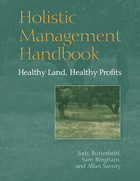 Holistic Management Handbook: Healthy Land, Healthy Profits
Jody Butterfield, Sam Bingham, and Allan Savory
Island Press, 2006 Holistic management, as described by Allan Savory in the books Holistic Resource Management (Island Press, 1988) and the revised edition, Holistic Management (Island Press, 2001), has been practiced by thousands of people around the world to profitably restore and promote the health of their land through practices that mimic nature, and by many others who have sought a more rewarding personal or family life. Holistic Management Handbook offers a detailed explanation of the planning procedures presented in those books and gives step-by-step guidance for implementing holistic management on a ranch or farm. Holistic Management and Holistic Management Handbook are essential reading for anyone involved with land management and stewardship, and together represent an indispensable guide for individuals interested in making better decisions within their organizations or in any aspect of their personal or professional lives.
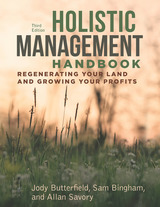 Holistic Management Handbook, Third Edition: Regenerating Your Land and Growing Your Profits
Jody Butterfield, Sam Bingham, and Allan Savory
Island Press, 2019 Holistic management is a systems-thinking approach developed by biologist Allan Savory to restore the world’s grassland soils and minimize the damaging effects of climate change and desertification on humans and the natural world. This third edition of Holistic Management Handbook: Regenerating Your Land and Growing Your Profits is the long-awaited companion volume to the classic text Holistic Management, Third Edition. Crafted under the direction of Savory’s longtime collaborator Jody Butterfield, this handbook is the key to developing a comprehensive holistic land plan based on Savory’s principles that will help you to restore health to your land and ensure a stable, sustainable livelihood from its bounty.
This new edition, thoroughly revised, updated, and streamlined, explains the planning procedures described in Holistic Management, and offers step-by-step instructions for running a ranch or farm using a holistic management approach. Butterfield and her coauthors describe how to use the handbook in conjunction with the textbook to tailor a management plan for your unique combination of land, livestock, and finances. Their mantra is “plan, monitor, control, and replan.” Using a four-part approach, the authors walk readers through basic concepts and techniques, help them put a plan onto paper, monitor the results, and adjust the details as needed. Appendixes provide updated worksheets, checklists, planning and monitoring forms, and detailed examples of typical scenarios a user might encounter. The handbook includes a comprehensive glossary of terms.
Ranchers, farmers, pastoralists, social entrepreneurs, government agencies, and NGOs working to address global environmental degradation will find this comprehensive handbook an indispensable guide to putting the holistic management concept into action with tangible results they can take to the bank.
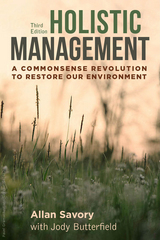 Holistic Management, Third Edition: A Commonsense Revolution to Restore Our Environment
Allan Savory with Jody Butterfield
Island Press, 2016 Fossil fuels and livestock grazing are often targeted as major culprits behind climate change and desertification. But Allan Savory, cofounder of the Savory Institute, begs to differ. The bigger problem, he warns, is our mismanagement of resources. Livestock grazing is not the problem; it’s how we graze livestock. If we don’t change the way we approach land management, irreparable harm from climate change could continue long after we replace fossil fuels with environmentally benign energy sources.
Holistic management is a systems-thinking approach for managing resources developed by Savory decades ago after observing the devastation of desertification in his native Southern Rhodesia (now Zimbabwe). Properly managed livestock are key to restoring the world’s grassland soils, the major sink for atmospheric carbon, and minimizing the most damaging impacts on humans and the natural world. This book updates Savory's paradigm-changing vision for reversing desertification, stemming the loss of biodiversity, eliminating fundamental causes of human impoverishment throughout the world, and climate change. Reorganized chapters make it easier for readers to understand the framework for Holistic Management and the four key insights that underlie it. New color photographs showcase before-and-after examples of land restored by livestock.
This long-anticipated new edition is written for new generations of ranchers, farmers, eco- and social entrepreneurs, and development professionals working to address global environmental and social degradation. It offers new hope that a sustainable future for humankind and the world we depend on is within reach.
 Holistic Shakespeare: An Experiential Learning Approach
Debra Charlton
Intellect Books, 2012 Shakespeare’s plays are staples of the classroom. Yet too often they are taught as antiquated works of literature with little reference to their theatrical life and enduringhuman themes. Applying the methodologies of the holistic education model to the study of four Shakespearean plays— Othello,The Tempest, A Midsummer Night’s Dream, and Measure for Measure—Holistic Shakespeare offers lively theater-based activities to complement traditional analytical exercises. In keeping with the aims of holistic education, each play is studied in relation to a particular social or ethical topic addressed in the work. Despite abundant scholarly works in the field of Shakespeare studies, few texts combine analytical and creative learning methodologies—and none before has specifically applied the principles of holistic education to the topic. Accessible to both teachers and learners, this book will be an essential tool for making Shakespeare come to life in the classroom.
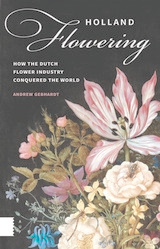 Holland Flowering: How the Dutch Flower Industry Conquered the World
Andrew Gebhardt
Amsterdam University Press, 2014 Growing tulip bulbs on the moon, and a tulip shaped island in the North Sea. Frederick Ruysch's wunderkammer and contemporary bloemencorsos. A Dutch-Chinese billionaire, aka the Orchid King, recreates a 'Dutch' town in northeast China complete with a replica of Amsterdam's central station and the International Court of Justice. A retired grower recalls a life in flowers, from the Second World War to the European Union. Dutch development policies in Ethiopia today and its former civilizing mission in Java. Auctions, cooperatives, networking, commodity culture, Dutch masculinity, and globalization. These are some of the imaginaries, themes, curious details, and perspectives you will encounter in this book. All of them pivot around Dutch flower culture today and in the Dutch Golden Age, and directly or indirectly link to Aalsmeer's flower auction, the world's largest, located not far from Amsterdam.
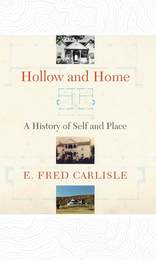 Hollow and Home: A History of Self and Place
E. Fred Carlisle
West Virginia University Press, 2017 Hollow and Home explores the ways the primary places in our lives shape the individuals we become. It proposes that place is a complex and dynamic phenomenon. Place refers to geographical and constructed places—location, topography, landscape, and buildings. It also refers to the psychological, social, and cultural influences at work at a given location. These elements act in concert to constitute a place.
Carlisle incorporates perspectives from writers like Edward S. Casey, Christian Norberg-Schulz, Yi-Fu Tuan, and Witold Rybczynski, but he applies theory with a light touch. Placing this literature in dialog with personal experience, he concentrates on two places that profoundly influenced him and enabled him to overcome a lifelong sense of always leaving his pasts behind. The first is Clover Hollow in Appalachian Virginia, where the author lived for ten years among fifth-, sixth-, and seventh-generation residents. The people and places there enabled him to value his own past and primary places in a new way. The story then turns to Carlisle’s life growing up in Delaware, Ohio. He describes in rich detail the ways the town shaped him in both enabling and disabling ways. In the end, after years of moving from place to place, Carlisle’s experience in Appalachia helped him rediscover his hometown—both the Old Delaware, where he grew up, and the New Delaware, a larger, thriving small city—as his true home.
The themes of the book transcend specific localities and speak to the relationship of self and place everywhere.
The Hollow Core: Private Interests in National Policy Making
John P. Heinz, Edward O. Laumann, Robert L. Nelson, and Robert H. Salisbury
Harvard University Press Critics of the policy-making process argue that private interest groups exert too much influence on the decisions of government, but only rarely has this proposition been examined systematically. The Hollow Core draws on interviews with more than 300 interest groups, 800 lobbyists, and 300 government officials to assess the efforts of private organizations to influence federal policy in four areas—agriculture, energy, health, and labor policy.
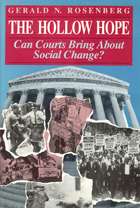 The Hollow Hope: Can Courts Bring About Social Change?
Gerald N. Rosenberg
University of Chicago Press, 1991 Liberals have acclaimed, and conservatives decried, reliance on courts as tools for changes. But while debate rages over whether the courts should be playing such a legislative role, Gerald N. Rosenberg poses a far more fundamental question—can courts produce political and social reform?
Rosenberg presents, with remarkable skill, an overwhelming case that efforts to use the courts to generate significant reforms in civil rights, abortion, and women's rights were largely failures.
"The real strength of The Hollow Hope . . . is its resuscitation of American Politics—the old-fashioned representative kind—as a valid instrument of social change. Indeed, the flip side of Mr. Rosenberg's argument that courts don't do all that much is the refreshing view that politics in the best sense of the word—as deliberation and choice over economic and social changes, as well as over moral issues—is still the core of what makes America the great nation it is. . . . A book worth reading."—Gary L. McDowell, The Washington Times
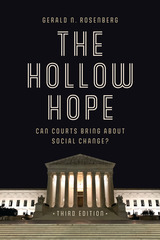 The Hollow Hope: Can Courts Bring About Social Change?
Gerald N. Rosenberg
University of Chicago Press, 2023 Presents a powerful argument for the limitations of judicial action to support significant social reform—now updated with new data and analysis.
Since its first publication in 1991, The Hollow Hope has spurred debate and challenged assumptions on both the left and the right about the ability of courts to bring about durable political and social change. What Gerald N. Rosenberg argued then, and what he confirms today through new evidence in this edition, is that it is nearly impossible to generate significant reforms through litigation: American courts are ineffective and relatively weak, far from the uniquely powerful sources for change they are often portrayed to be.
This third edition includes new data and a substantially updated analysis of civil rights, abortion rights and access, women’s rights, and marriage equality. Addressing changes in the political and social environment, Rosenberg draws lessons from the re-segregation of public schools, victories in marriage equality, and new obstacles to abortion access. Through these and other cases, the third edition confirms the power of the book’s original explanatory framework and deepens our understanding of the limits of judicial action in support of social reform, as well as the conditions under which courts do produce change. Up-to-date, thorough, and thought-provoking, The Hollow Hope remains vital reading.
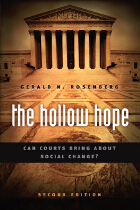 The Hollow Hope: Can Courts Bring About Social Change? Second Edition
Gerald N. Rosenberg
University of Chicago Press, 2008 In follow-up studies, dozens of reviews, and even a book of essays evaluating his conclusions, Gerald Rosenberg’s critics—not to mention his supporters—have spent nearly two decades debating the arguments he first put forward in The Hollow Hope. With this substantially expanded second edition of his landmark work, Rosenberg himself steps back into the fray, responding to criticism and adding chapters on the same-sex marriage battle that ask anew whether courts can spur political and social reform.
Finding that the answer is still a resounding no, Rosenberg reaffirms his powerful contention that it’s nearly impossible to generate significant reforms through litigation. The reason? American courts are ineffective and relatively weak—far from the uniquely powerful sources for change they’re often portrayed as. Rosenberg supports this claim by documenting the direct and secondary effects of key court decisions—particularly Brown v. Board of Education and Roe v. Wade. He reveals, for example, that Congress, the White House, and a determined civil rights movement did far more than Brown to advance desegregation, while pro-choice activists invested too much in Roe at the expense of political mobilization. Further illuminating these cases, as well as the ongoing fight for same-sex marriage rights, Rosenberg also marshals impressive evidence to overturn the common assumption that even unsuccessful litigation can advance a cause by raising its profile.
Directly addressing its critics in a new conclusion, The Hollow Hope, Second Edition promises to reignite for a new generation the national debate it sparked seventeen years ago.
The Hollow Log Lounge: POEMS
R. T. Smith
University of Illinois Press, 2003 "This is no fairy tale. / It's all fantastic and bizarre and true. / It's my life, a raspy song, that sounds better if you sing along."
The men and women who live and work near Opelika, Alabama, gather at the Hollow Log Lounge. There, under the watchful eye of the stuffed fox behind the bar, they unload their gripes and worries, tell their stories, argue, joke, commune, complain, and confess.
In this collection of poems, R. T. Smith paints a vividly imagined portrait of the community in this small-town bar, capturing the chorus of the patrons' voices echoing off the knotted wood-paneled walls. Smith's stand-in, Sam Buckhannon, scribbles stories heard and overheard as tongues loosened by liquor spin out monologues in which southern idiom and vernacular seem perfectly at home within the constraints of measured verse.
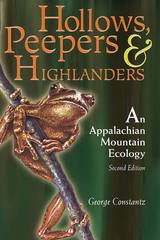 HOLLOWS, PEEPERS, AND HIGHLANDERS: AN APPALACHIAN MOUNTAIN ECOLOGY
George Constantz
West Virginia University Press, 2004 In this revised and expanded edition of Hollows, Peepers, and Highlanders, author George Constantz, a biologist and naturalist, writes about the beauty and nature of the Appalachian landscape. While the information is scientific in nature, Constantz's accessible descriptions of the adaptation of various organisms to their environment enable the reader to enjoy learning about the Appalachian ecosystem. The book is divided into three sections: "Stage and Theater," "The Players," and "Seasonal Act." Each section sets the scene and describes the events occurring in nature. "Stage and Theatre" is comprised of chapters that describe the origins of the Appalachia region. "The Players" is an interesting and in-depth look into the ecology of animals, such as the mating rituals of different species, and the evolutionary explanation for the adaptation of Appalachian wildlife. The last section, "Seasonal Act," makes note of the changes in Appalachian weather each season and its effect on the inhabitants.
Hollywood & God
Robert Polito
University of Chicago Press, 2009 Hollywood & God is a virtuosic performance, filled with crossings back and forth from cinematic chiaroscuro to a kind of unsettling desperation and disturbing—even lurid—hallucination. From the Baltimore Catechism to the great noir films of the last century to today’s Elvis impersonators and Paris Hilton (an impersonator of a different sort), Robert Polito tracks the snares, abrasions, and hijinks of personal identities in our society of the spectacle, a place where who we say we are, and who (we think) we think we are fade in and out of consciousness, like flickers of light dancing tantalizingly on the silver screen. Mixing lyric and essay, collage and narrative, memoir and invention, Hollywood & God is an audacious book, as contemporary as it is historical, as sly and witty as it is devastatingly serious.
Hollywood and Broadcasting: From Radio to Cable
Michelle Hilmes
University of Illinois Press, 1990 "Michele Hilmes has produced
an excellent introduction to a most important subject. This is an invaluable
work for both scholars and students that places film, radio, and television
within the context of the national culture experience."
--- American Historical Review
"Hilmes is one of the few historians
of broadcasting to move beyond a political economy of the media. . . . Her work
should serve as a model for future histories of broadcasting."
--- Journal of Communication
"All media historians will
find this work a critical addition to their bookshelves."
--- American Journalism
"A major addition to media
history literature."
--- Journalism History
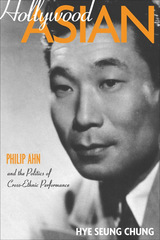 Hollywood Asian: Philip Ahn and the Politics of Cross-Ethnic Performance
Hye Seung Chung
Temple University Press, 2006 From silent films to television programs, Hollywood has employed actors of various ethnicities to represent "Oriental"characters, from Caucasian stars like Loretta Young made up in yellow-face to Korean American pioneer Philip Ahn, whose more than 200 screen performances included roles as sadistic Japanese military officers in World War II movies and a wronged Chinese merchant in the TV show Bonanza. The first book-length study of Korean identities in American cinema and television, Hollywood Asian investigates the career of Ahn (1905-1978), a pioneering Asian American screen icon and son of celebrated Korean nationalist An Ch'ang-ho. In this groundbreaking scholarly study, Hye Seung Chung examines Ahn's career to suggest new theoretical paradigms for addressing cross-ethnic performance and Asian American spectatorship. Incorporating original material from a wide range of sources, including U.S. government and Hollywood screen archives, Chung's work offers a provocative and original contribution to cinema studies, cultural studies, and Asian American as well as Korean history.
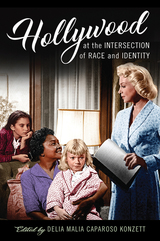 Hollywood at the Intersection of Race and Identity
Delia Malia Caparoso Konzett
Rutgers University Press, 2020 Hollywood at the Intersection of Race and Identity explores the ways Hollywood represents race, gender, class, and nationality at the intersection of aesthetics and ideology and its productive tensions. This collection of essays asks to what degree can a close critical analysis of films, that is, reading them against their own ideological grain, reveal contradictions and tensions in Hollywood’s task of erecting normative cultural standards? How do some films perhaps knowingly undermine their inherent ideology by opening a field of conflicting and competing intersecting identities? The challenge set out in this volume is to revisit well-known films in search for a narrative not exclusively constituted by the Hollywood formula and to answer the questions: What lies beyond the frame? What elements contradict a film’s sustained illusion of a normative world? Where do films betray their own ideology and most importantly what intersectional spaces of identity do they reveal or conceal?
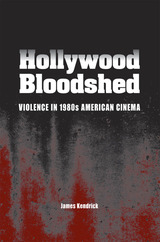 Hollywood Bloodshed: Violence in 1980s American Cinema
James Kendrick
Southern Illinois University Press, 2009 In Hollywood Bloodshed, James Kendrick presents a fascinating look into the political and ideological instabilities of the 1980s as studied through the lens of cinema violence. Kendrick uses in-depth case studies to reveal how dramatic changes in the film industry and its treatment of cinematic bloodshed during the Reagan era reflected shifting social tides as Hollywood struggled to find a balance between the lucrative necessity of screen violence and the rising surge of conservatism. As public opinion shifted toward the right and increasing emphasis was placed on issues such as higher military spending, family values, and “money culture,” film executives were faced with an epic dilemma: the violent aspects of cinema that had been the studios’ bread and butter were now almost universally rejected by mainstream audiences. Far from eliminating screen bloodshed altogether, studios found new ways of packaging violence that would allow them to continue to attract audiences without risking public outcry, ushering in a period of major transition in the film industry. Studios began to shy away from the revolutionary directors of the 1970s—many of whom had risen to fame through ideologically challenging films characterized by a more disturbing brand of violence—while simultaneously clearing the way for a new era in film. The 1980s would see the ascent of entertainment conglomerates and powerful producers and the meteoric rise of the blockbuster—a film with no less violence than its earlier counterparts, but with action-oriented thrills rather than more troubling images of brutality. Kendrick analyzes these and other radical cinematic changes born of the conservative social climate of the 1980s, including the disavowal of horror films in the effort to present a more acceptable public image; the creation of the PG-13 rating to designate the gray area of movie violence between PG and R ratings; and the complexity of marketing the violence of war movies for audience pleasure. The result is a riveting study of an often overlooked, yet nevertheless fascinating time in cinema history. While many volumes have focused on the violent films of the New American Cinema directors of the 1970s or the rise of icons such as Woo, Tarantino, and Rodriguez in the 1990s, Kendrick’s Hollywood Bloodshed bridges a major gap in film studies.This comprehensive volume offers much-needed perspective on a decade that altered the history of Hollywood—and American culture—forever.
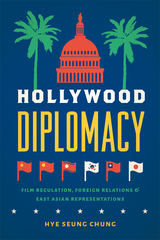 Hollywood Diplomacy: Film Regulation, Foreign Relations, and East Asian Representations
Hye Seung Chung
Rutgers University Press, 2020 Hollywood Diplomacy contends that, rather than simply reflect the West’s cultural fantasies of an imagined “Orient,” images of Chinese, Japanese, and Korean ethnicities have long been contested sites where the commercial interests of Hollywood studios and the political mandates of U.S. foreign policy collide, compete against one another, and often become compromised in the process. While tracing both Hollywood’s internal foreign relations protocols—from the “Open Door” policy of the silent era to the “National Feelings” provision of the Production Code—and external regulatory interventions by the Chinese government, the U.S. State Department, the Office of War Information, and the Department of Defense, Hye Seung Chung reevaluates such American classics as Shanghai Express and The Great Dictator and applies historical insights to the controversies surrounding contemporary productions including Die Another Day and The Interview. This richly detailed book redefines the concept of “creative freedom” in the context of commerce: shifting focus away from the artistic entitlement to offend foreign audiences toward the opportunity to build new, better relationships with partners around the world through diplomatic representations of race, ethnicity, and nationality.
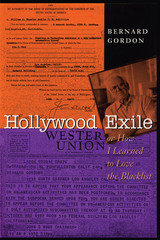 Hollywood Exile, or How I Learned to Love the Blacklist
By Bernard Gordon
University of Texas Press, 2000 The Hollywood blacklist, which began in the late 1940s and ran well into the 1960s, ended or curtailed the careers of hundreds of people accused of having ties to the Communist Party. Bernard Gordon was one of them. In this highly readable memoir, he tells a engrossing insider's story of what it was like to be blacklisted and how he and others continued to work uncredited behind the scenes, writing and producing many box office hits of the era. Gordon describes how the blacklist cut short his screenwriting career in Hollywood and forced him to work in Europe. Ironically, though, his is a success story that includes the films El Cid, 55 Days at Peking, The Thin Red Line, Krakatoa East of Java, Day of the Triffids, Earth vs. the Flying Saucers, Horror Express, and many others. He recounts the making of many movies for which he was the writer and/or producer, with wonderful anecdotes about stars such as Charlton Heston, David Niven, Sophia Loren, Ava Gardner, and James Mason; directors Nicholas Ray, Frank Capra, and Anthony Mann; and the producer-studio head team of Philip Yordan and Samuel Bronston.
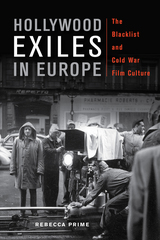 Hollywood Exiles in Europe: The Blacklist and Cold War Film Culture
Prime, Rebecca
Rutgers University Press, 2014 Rebecca Prime documents the untold story of the American directors, screenwriters, and actors who exiled themselves to Europe as a result of the Hollywood blacklist. During the 1950s and 1960s, these Hollywood émigrés directed, wrote, or starred in almost one hundred European productions, their contributions ranging from crime film masterpieces like Du rififi chez les hommes (1955, Jules Dassin, director) to international blockbusters like The Bridge on the RiverKwai (1957, Carl Foreman and Michael Wilson, screenwriters) and acclaimed art films like The Servant (1963, Joseph Losey, director). At once a lively portrait of a lesser-known American “lost generation” and an examination of an important transitional moment in European cinema, the book offers a compelling argument for the significance of the blacklisted émigrés to our understanding of postwar American and European cinema and Cold War relations. Prime provides detailed accounts of the production and reception of their European films that clarify the ambivalence with which Hollywood was regarded within postwar European culture. Drawing upon extensive archival research, including previously classified material, Hollywood Exiles in Europe suggests the need to rethink our understanding of the Hollywood blacklist as a purely domestic phenomenon. By shedding new light on European cinema’s changing relationship with Hollywood, the book illuminates the postwar shift from national to transnational cinema.
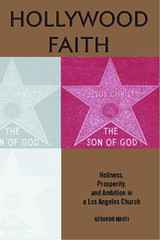 Hollywood Faith: Holiness, Prosperity, and Ambition in a Los Angeles Church
Marti, Gerardo
Rutgers University Press, 2008 In Christianity, as with most religions, attaining holiness and a higher spirituality while simultaneously pursuing worldly ideals such as fame and fortune is nearly impossible. So how do people pursuing careers in Hollywood's entertainment industry maintain their religious devotion without sacrificing their career goals? For some, the answer lies just two miles south of the historic center of Hollywood, California, at the Oasis Christian Center. In Hollywood Faith, Gerardo Marti shows how a multiracial evangelical congregation of 2,000 people accommodates itself to the entertainment industry and draws in many striving to succeed in this harsh and irreverent business. Oasis strategically sanctifies ambition and negotiates social change by promoting a new religious identity as "champion of life"-an identity that provides people who face difficult career choices and failed opportunities a sense of empowerment and endurance. The first book to provide an in-depth look at religion among the "creative class," Hollywood Faith will fascinate those interested in the modern evangelical movement and anyone who wants to understand how religion adapts to social change.
Hollywood in Cannes: The History of a Love-Hate Hate Relationship
Christian Jungen
Amsterdam University Press Conjuring up all the glamour of the event, Jungen recounts the history of the Cannes Film Festival from an American perspective surveying the complex interplay of talent, money and corporate clout. He traces the growing influence of the Hollywood studios on the festival's rise to the key film event. Case studies of film (including The Birds, Easy Rider, and The Da Vinci Code) and of the creation of stars such as Arnold Schwarzenegger and Sharon Stone, profit from the author's experience of visiting the Cannes Film Festival over more than twelve years.
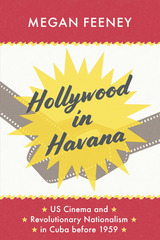 Hollywood in Havana: US Cinema and Revolutionary Nationalism in Cuba before 1959
Megan Feeney
University of Chicago Press, 2018 From the turn of the twentieth century through the late 1950s, Havana was a locus for American movie stars, with glamorous visitors including Errol Flynn, John Wayne, and Marlon Brando. In fact, Hollywood was seemingly everywhere in pre-Castro Havana, with movie theaters three to a block in places, widely circulated silver screen fanzines, and terms like “cowboy” and “gangster” entering Cuban vernacular speech. Hollywood in Havana uses this historical backdrop as the catalyst for a startling question: Did exposure to half a century of Hollywood pave the way for the Cuban Revolution of 1959?
Megan Feeney argues that the freedom fighting extolled in American World War II dramas and the rebellious values and behaviors seen in postwar film noir helped condition Cuban audiences to expect and even demand purer forms of Cuban democracy and national sovereignty. At the same time, influential Cuban intellectuals worked to translate Hollywood ethics into revolutionary rhetoric—which, ironically, led to pointed critiques and subversions of the US presence in Cuba. Hollywood in Havana not only expands our notions of how American cinema was internalized around the world—it also broadens our view of the ongoing history of US-Cuban interactions, both cultural and political.
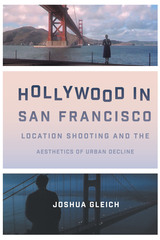 Hollywood in San Francisco: Location Shooting and the Aesthetics of Urban Decline
By Joshua Gleich
University of Texas Press, 2018 One of the country’s most picturesque cities and conveniently located just a few hours’ drive from Hollywood, San Francisco became the most frequently and extensively filmed American city beyond the production hubs of Los Angeles and New York in the three decades after World War II. During those years, the cinematic image of the city morphed from the dreamy beauty of Vertigo to the nightmarish wasteland of Dirty Harry, although San Francisco itself experienced no such decline. This intriguing disconnect gives impetus to Hollywood in San Francisco, the most comprehensive study to date of Hollywood’s move from studio to location production in the postwar era. In this thirty-year history of feature filmmaking in San Francisco, Joshua Gleich tracks a sea change in Hollywood production practices, as location shooting overtook studio-based filming as the dominant production method by the early 1970s. He shows how this transformation intersected with a precipitous decline in public perceptions of the American city, to which filmmakers responded by developing a stark, realist aesthetic that suited America’s growing urban pessimism and superseded a fidelity to local realities. Analyzing major films set in San Francisco, ranging from Dark Passage and Vertigo to The Conversation, The Towering Inferno, and Bullitt, as well as the TV show The Streets of San Francisco, Gleich demonstrates that the city is a physical environment used to stage urban fantasies that reveal far more about Hollywood filmmaking and American culture than they do about San Francisco.
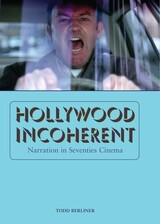 Hollywood Incoherent: Narration in Seventies Cinema
By Todd Berliner
University of Texas Press, 2010 In the 1970s, Hollywood experienced a creative surge, opening a new era in American cinema with films that challenged traditional modes of storytelling. Inspired by European and Asian art cinema as well as Hollywood's own history of narrative ingenuity, directors such as Martin Scorsese, Robert Altman, William Friedkin, Stanley Kubrick, Woody Allen, and Francis Ford Coppola undermined the harmony of traditional Hollywood cinema and created some of the best movies ever to come out of the American film industry. Critics have previously viewed these films as a response to the cultural and political upheavals of the 1970s, but until now no one has explored how the period's inventive narrative design represents one of the great artistic accomplishments of American cinema. In Hollywood Incoherent, Todd Berliner offers the first thorough analysis of the narrative and stylistic innovations of seventies cinema and its influence on contemporary American filmmaking. He examines not just formally eccentric films—Nashville; Taxi Driver; A Clockwork Orange; The Godfather, Part II; and the films of John Cassavetes—but also mainstream commercial films, including The Exorcist, The Godfather, The French Connection, Willy Wonka and the Chocolate Factory, Dog Day Afternoon, Chinatown, The Bad News Bears, Patton, All the President's Men, Annie Hall, and many others. With persuasive revisionist analyses, Berliner demonstrates the centrality of this period to the history of Hollywood's formal development, showing how seventies films represent the key turning point between the storytelling modes of the studio era and those of modern American cinema.
 Hollywood Independents: The Postwar Talent Takeover
Denise Mann
University of Minnesota Press, 2008 Hollywood Independents explores the crucial period from 1948 to 1962 when independent film producers first became key components of the modern corporate entertainment industry. Denise Mann examines the impact of the radically changed filmmaking climate—the decline of the studios, the rise of television, and the rise of potent talent agencies like MCA—on a group of prominent talent-turned-producers including Burt Lancaster, Joseph Mankiewicz, Elia Kazan, and Billy Wilder. In order to show how these newly independent filmmakers negotiated through an increasingly fraught, reactionary creative atmosphere, Mann analyzes the reflexive portraits of their altered working conditions in such films as A Face in the Crowd, Sweet Smell of Success, and Will Success Spoil Rock Hunter? These artists, she shows, took on the corporate middle-managers at television networks and talent agencies as a way of challenging the status quo without risking censorship or blacklisting. This period saw the evolution of film production from the studio-governed system to one of entrepreneurs. Out of this new arrangement, which encouraged greater creative freedom, emerged a nascent form of independent art cinema that sowed the seeds of the Hollywood Renaissance that followed. Denise Mann is associate professor of film, TV and digital media at UCLA. She is coeditor of Private Screenings: Television and the Female Consumer (Minnesota, 1992).
Hollywood is Everywhere: Global Directors in the Blockbuster Era
Melis Behlil
Amsterdam University Press, 2016 Hollywood has a long tradition of bringing in emigre directors from around the world, dating back to the silent era. Today, as the film industry is ever more global, the people who make blockbuster movies seemingly reflect this tradition, hailing from many countries across the world. But that fact hides a fundamental difference, one that Melis Behlil examines in Hollywood is Everywhere: today's Hollywood studios are themselves transnational, with ownership structures and financial arrangements that stretch far beyond the borders of the United States. Seen in that context, today's international directors are less analogous to the emigre talent of the past than to ordinary transnational employees of other major global corporations.
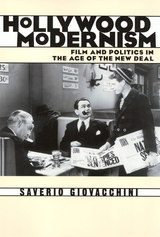 Hollywood Modernism: Film & Politics In Age Of New Deal
Saverio Giovacchini
Temple University Press, 2001 Hollywood culture has been dismissed as insignificant for so long that film buffs and critics might be forgiven for forgetting that for two decades an unprecedented interaction of social and cultural forces shaped American film. In this probing account of how a generation of industry newcomers attempted to use the modernist art of the cinema to educate the public in anti-Fascist ideals, Saverio Giovacchini traces the profound transformation that took place in the film industry from the 1930's to the 1950's. Rejecting the notion that European emigres and New Yorkers sought a retreat from politics or simply gravitated toward easy money, he contends that Hollywood became their mecca precisely because they wanted a deeper engagement in the project of democratic modernism.
Seeing Hollywood as a forcefield, Giovacchini examines the social networks, working relationships, and political activities of artists, intellectuals, and film workers who flocked to Hollywood from Europe and the eastern United States before and during the second world war. He creates a complex and nuanced portrait of this milieu, adding breadth and depth to the conventional view of the era's film industry as little more than an empire for Jewish moguls or the major studios. In his rendering Hollywood's newcomers joined with its established elite to develop a modernist aesthetic for film that would bridge popular and avant-garde sensibilities; for them, realism was the most effective vehicle for conveying their message and involving a mass audience in the democratic struggle for process.
|
|
